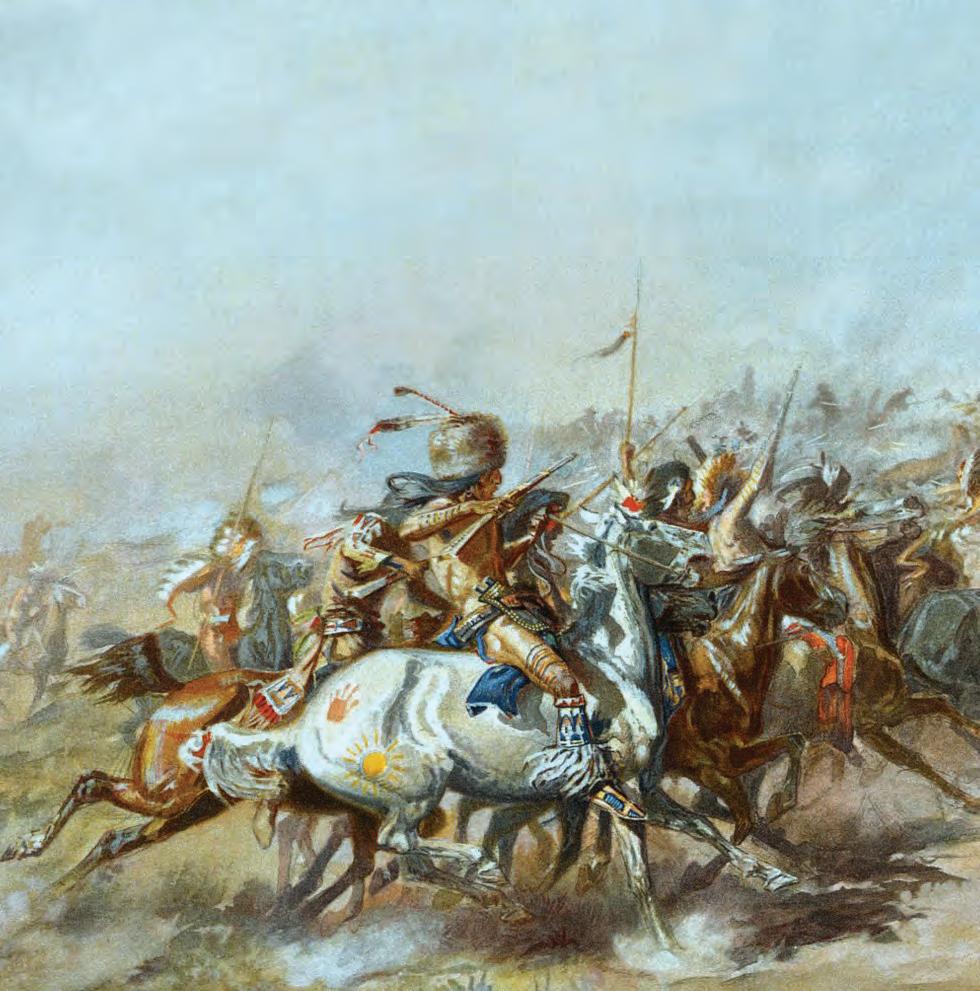




This 16" full tang stainless steel blade is not for the faint of heart
In the blockbuster film, when a strapping Australian crocodile hunter and a lovely American journalist were getting robbed at knife point by a couple of young thugs in New York, the tough Aussie pulls out his dagger and says “That’s not a knife, THIS is a knife!” Of course, the thugs scattered and he continued on to win the reporter’s heart.
Our Aussie friend would approve of our rendition of his “knife.” Forged of high grade 420 surgical stainless steel, this knife is an impressive 16" from pommel to point. And, the blade is full tang, meaning it runs the entirety of the knife, even though part of it is under wraps in the natural bone and wood handle.
Secured in a tooled leather sheath, this is one impressive knife, with an equally impressive price.

This fusion of substance and style can garner a high price tag out in the marketplace. In fact, we found full tang, stainless steel
blades with bone handles in excess of $2,000. Well, that won’t cut it around here. We have mastered the hunt for the best deal, and in turn pass the spoils on to our customers. But we don’t stop there. While supplies last, we’ll include a pair of $99, 8x21 power compact binoculars, and a genuine leather sheath FREE when you purchase the Down
Under Bowie Knife
Your satisfaction is 100% guaranteed. Feel the knife in your hands, wear it on your hip, inspect the impeccable craftsmanship. If you don’t feel like we cut you a fair deal, send it back within 30 days for a complete refund of the item price.
Limited Reserves. A deal like this won’t last long. We have only 1120 Down Under Bowie Knives for this ad only. Don’t let this beauty slip through your fingers at a price that won’t drag you under. Call today!
Down Under Bowie Knife $249*
Stauer® 8x21 Compact Binoculars

-a $99 valuewith purchase of Down Under Knife



êêêêê
“This knife is beautiful!”
— J., La Crescent, MN
êêêêê


“The feel of this knife is unbelievable...this is an incredibly fine instrument.”
— H., Arvada, CO
BONUS! Call today and you’ll also receive this genuine leather sheath!

Offer Code Price Only $99 + S&P Save $150
1-800-333-2045
Your Insider Offer Code: DUK370-01
You must use the insider offer code to get our special price.
Stauer ®
Rating of A+
14101 Southcross Drive W., Ste 155, Dept. DUK370-01
Burnsville, Minnesota 55337 www.stauer.com
*Discount is only for customers who use the offer code versus the listed original Stauer.com price.
California residents please call 1-800-333-2045 regarding Proposition 65 regulations before purchasing this product.
•Etched stainless steel full tang blade ; 16” overall • Painted natural bone and wood handle • Brass hand guards, spacers & end cap • Includes genuine tooled leather sheath
—now ONLY $99!

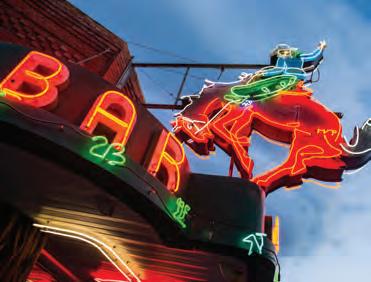

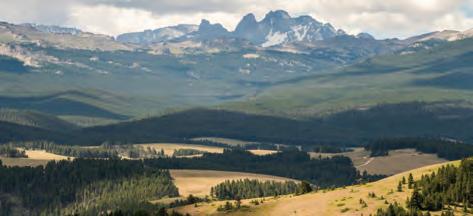

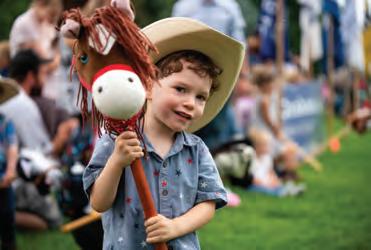

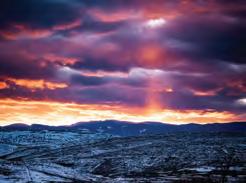


The world comes out west expecting to see cowboys driving horses through the streets of downtown; pronghorn butting heads on windswept bluffs; clouds encircling the towering pinnacles of the Cloud Peak Wilderness; and endless expanses of wild, open country. These are some of the fibers that have been stitched together over time to create the patchwork quilt of Sheridan County’s identity, each part and parcel to the Wyoming experience. Toss in a historic downtown district, with western allure, hospitality and good graces to spare; a vibrant art scene; bombastic craft culture; a robust festival and events calendar; small town charm from one historic outpost to the next; and living history on every corner, and you have a golden ticket to the adventure of a lifetime.
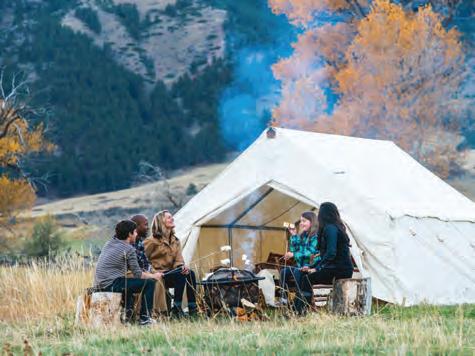
 By Mike Coppock
By Mike Coppock
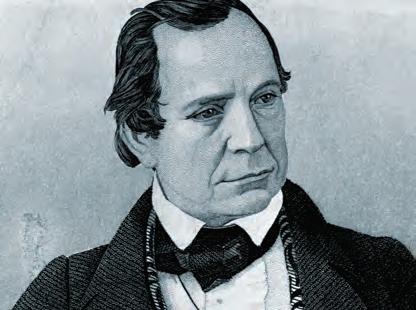
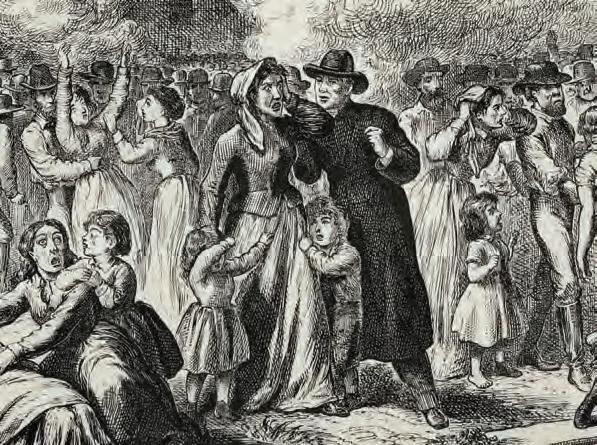
 By Matthew Bernstein
By Matthew Bernstein
Kansan Patrick Cleary was as violent—and ill-fated—as ‘the Kid’ from New Mexico
The west Texas boomtown of Colorado City was known for its wealth, vice and violence

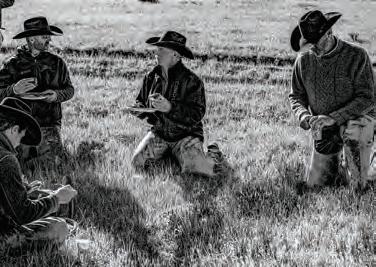 By Candy Moulton
By Candy Moulton
SUMMER 2023
8 LETTERS
10 ROUNDUP
16 INTERVIEW
BY JOHNNY D. BOGGSActor Michael Dante writes about his Hollywood career, history and the West
18 WESTERNERS
Dancer ‘Klondike Kate’ Rockwell dazzled miners in Yukon Territory, Canada
20
‘Lion of Tombstone’ Wyatt Earp was something of a lamb in Wrangell, Alaska
Though happy in the kitchen, Alaskan Fannie Quigley took guff from no one
24 ART OF THE WEST
BY JOHNNY D. BOGGSRick Kennington loves the texture of paint nearly as much as the West he depicts

30 INDIAN LIFE
BY DENNIS GOODWINDid notable Lakota warrior White Bull kill George Custer at the Little Bighorn?
70 GUNS OF THE WEST
BY GEORGE LAYMANThe Springfield Model 1842 smoothbore musket had a storied career as surplus
EICHIN
Gold Hill, Nevada, yielded plentiful gold and silver—and experienced tragedy
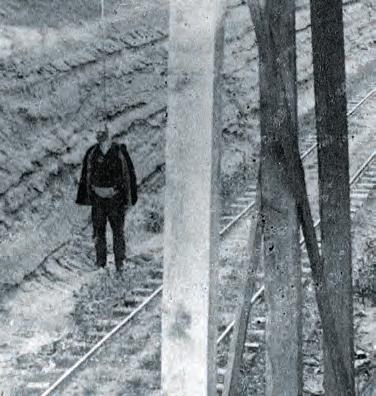
74 REVIEWS
Mike Coppock shares his favorite Klondike-related books and films. Plus reviews of books about ‘Dirty Dave’ Rudabaugh, Crow artist White Swan and others

80 GO WEST
Alaska’s Inside Passage is as stunning as ever, the accommodations far better
Spry 84-year-old John J. ‘Two-Step Jake’ Hirsch, of Tenakee Springs, Alaska, poses with a tool of his trade in 1936. Hirsch spent 57 years in the goldfields of Alaska and Canada’s Yukon Territory. At the time of this portrait he was mulling plans to start a fox and mink fur farm and boasting he’d soon appear on the big screen with Mae West. When a friend expressed concern Hirsch might overexert himself, Jake replied, “My father lived to 97, and he wouldn’t have died then if he had taken care of himself.” Hirsch himself died at the Alaska Pioneers’ Home in Juneau in 1944. He was 96. (Alaska State Archives, Skinner Foundation, ASL-PCA-44; colorization by Brian Walker)
A photographer’s portrait of Wyoming’s Wagonhound proves little has changedWe share with you, our reader, a love of both history and the American West that makes our work a labor of love. Still, it is encouraging when peers recognize our efforts—and that brings me to our big news.
Wild West contributor Matthew Kerns has earned two of the top writing awards in the Western history niche for his April 2022 cover story “‘Texas Jack’ Takes an Encore,” which relates the life story of pioneering cowboy celebrity John Baker “Texas Jack” Omohundro (see P. 11 for details). Kerns won both the 2023 Western Heritage Award for best magazine article from the National Cowboy & Western Heritage Museum and the 2023 Spur Award in the same category from Western Writers of America. The rare double win marks this magazine’s seventh lifetime Wrangler and sixth lifetime Spur.
Wild West is honored by the awards and proud of our writers. Meanwhile, we’ve been hard at work. In this issue we range to the far north. In our cover story (see P. 30) Mike Coppock relates the colorful chronicles and characters of the 1896–99 Klondike Gold Rush from rough-hewn ports in southeast Alaska to northwestern Canada’s Yukon Territory. Among the betterknown figures who made their mark in the goldfields and boomtowns of the Klondike and southeast Alaska were Call of the Wild author Jack London and lawman Wyatt Earp of Tombstone, Arizona Territory, fame, whose time up north Coppock details in Gunfighters & Lawmen (see P. 20). Our Westerners profile (see P. 18) shines the spotlight on dancer and vaudeville performer “Klondike Kate” Rockwell, who whirled her way into prospectors’ hearts and beguiled them out of their gold dust. Finally, Go West (see P. 80), the destination page that closes each issue, features then-and-now maritime images of Alaska’s Inside Passage, the embarkation point for most Klondike prospectors.
Of the 100,000 hopefuls who set out from there for the goldfields, scarcely one-third completed the grueling trek up through dizzying mountain passes, across untamed wilderness and down lethal rapids on makeshift boats. Hundreds died due to accidents, exposure, starvation, illness, alcoholism, murder, suicide and other causes. It was—and in many areas still qualifies as—frontier.
In 1893 Frederick Jackson Turner delivered a speech entitled “The Significance of the Frontier in American History” to a gathering of the American Historical Association in Chicago. Turner famously quoted an 1890 Census Bureau bulletin
declaring the “closing of the frontier” in the Lower 48. “Up to and including 1880 the country had a frontier of settlement,” the bulletin read, “but at present the unsettled area has been so broken into by isolated bodies of settlement that there can hardly be said to be a frontier line.”
Alaska is another matter altogether. To this day there are remote settlements accessible only to bush planes fitted with floats or skis, and the state nickname remains “The Last Frontier.” Just how much elbow room is there? At 570,951 square miles, it is by far the largest state—more than twice the size of Texas—and if all 736,081 of its residents were to stake his or her own claim, each would have the greater part of a square mile on which to prospect, fish, trap, hunt, raise a cabin, build an igloo or throw snowballs. Compare that to Washington, D.C., and its claustrophobic population density of 11,295 people per square mile. Granted, most Alaskans, like most Americans, live in cities and towns, but that only further frees up its wilderness.
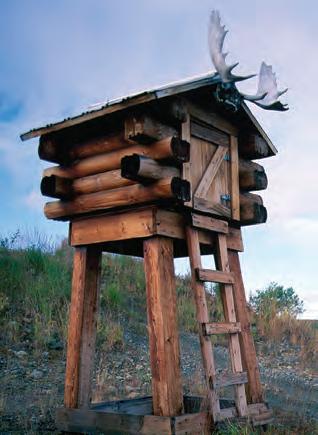
Just ask such modern-day Alaskan frontiersmen as Heimo Korth. Subject of the 2004 biography The Final Frontiersman, by James Campbell, Heimo and wife Edna are among the few permanent residents of the 19-million-plus-acre Arctic National Wildlife Refuge. Hacking out a subsistence living between seasonal cabins hundreds of miles from any town, the Korths eat mostly what they can hunt, fish and trap, and they haul in creek water daily just to survive. But they are free to live as they choose, and they wouldn’t have it any other way.
Have your own tales of the wild frontier? Drop us a line at WildWest@HistoryNet.com, and we’ll share your memories with fellow readers in the next Letters section. To keep up with our latest, sign up for our monthly email newsletter at HistoryNet.com/signmeup.
Now, “Mush!”
Wild West editor David Lauterborn is a published writer, author and photographer with two books and hundreds of magazine articles to his credit. A hopelessly addicted traveler to and onetime resident of the American West, he lives in historic Harpers Ferry, W.Va.
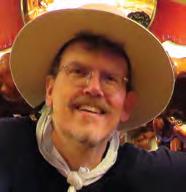
This black genuine leather bracelet is hand-crafted of solid stainless steel and ion-plated 24K-gold accents, and features an impressively sized genuine turquoise cabochon at the center. One of the oldest stones known to man, and used extensively in jewelry from America’s Southwest, it makes a strong statement along with the images of American bison.

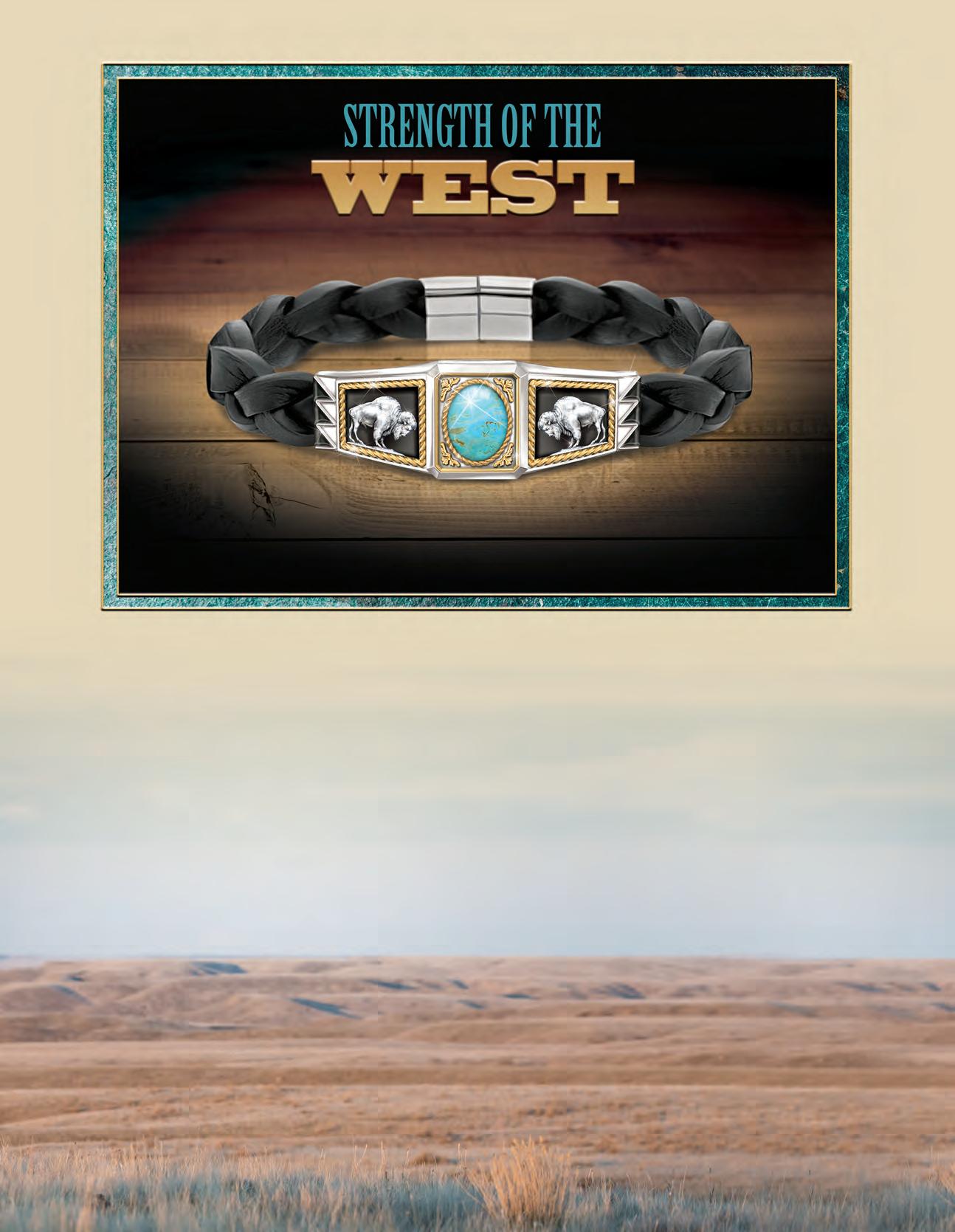
The turquoise center stone is surrounded by a raised twisted rope design along with impressive scrollwork accents. On either side of the turquoise stone, you’ll nd masterfully sculpted images of the majestic bison on a black ion-plated background also framed by a raised twisted rope border. Decorative Western-style art motifs honoring the American
West complete the distinctive look. Adding to the meaning and value, the words “Strength of the West,” are boldly etched on the back. A magnetic clasp allows for easy wear and it’s designed to t most wrists.



This bracelet is an exceptional value at $119.99*, payable in 4 easy installments of just $30, and is backed by our unconditional 120-day full money-back guarantee. Each bracelet arrives in a velvet jewelry pouch along with a gift box and Certi cate of Authenticity. To reserve, send no money now; just mail the Priority Reservation. Don’t miss out—order yours today!

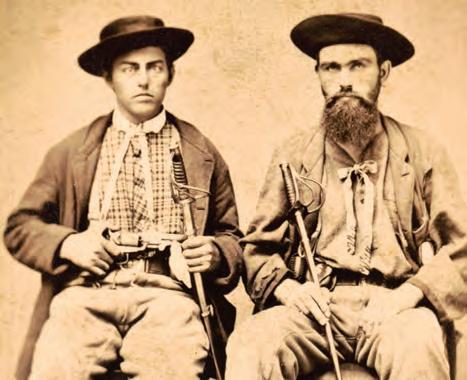 By Jerry D. Morelock historynet.com/bleeding-kansas-myth
By Jerry D. Morelock historynet.com/bleeding-kansas-myth
DAVID LAUTERBORN EDITOR
JON GUTTMAN SENIOR EDITOR
GREGORY J. LALIRE EDITOR EMERITUS
JOHNNY D. BOGGS SPECIAL CONTRIBUTOR
JOHN BOESSENECKER SPECIAL CONTRIBUTOR
JOHN KOSTER SPECIAL CONTRIBUTOR
BRIAN WALKER GROUP DESIGN DIRECTOR
MELISSA A. WINN DIRECTOR OF PHOTOGRAPHY
AUSTIN STAHL ASSOCIATE DESIGN DIRECTOR
ALEX GRIFFITH PHOTO EDITOR
DANA B. SHOAF EDITOR IN CHIEF CLAIRE BARRETT NEWS AND SOCIAL EDITOR
CORPORATE
KELLY FACER SVP REVENUE OPERATIONS
MATT GROSS VP DIGITAL INITIATIVES
ROB WILKINS DIRECTOR OF PARTNERSHIP MARKETING
JAMIE ELLIOTT SENIOR DIRECTOR, PRODUCTION
ADVERTISING
MORTON GREENBERG SVP ADVERTISING SALES mgreenberg@mco.com
TERRY JENKINS REGIONAL SALES MANAGER tjenkins@historynet.com

DIRECT RESPONSE ADVERTISING NANCY FORMAN / MEDIA PEOPLE nforman@mediapeople.com
© 2023 HISTORYNET, LLC
SUBSCRIPTION INFORMATION: 800-435-0715 OR SHOP.HISTORYNET.COM
WILD WEST (ISSN 1046-4638) is published quarterly by HistoryNet, LLC, 901 North Glebe Road, 5th Floor, Arlington, VA 22203 Periodical postage paid at Tysons, Va., and additional mailing offices. postmaster, send address changes to WILD WEST, P.O. Box 900, Lincolnshire, IL 60069-0900
List Rental Inquiries: Belkys Reyes, Lake Group Media, Inc. 914-925-2406; belkys.reyes@lakegroupmedia.com
Canada Publications Mail Agreement No. 41342519




Canadian GST No. 821371408RT0001
The contents of this magazine may not be reproduced in whole or in part without the written consent of HistoryNet, LLC
PROUDLY MADE IN THE USA

The enduring image of this notorious pre–Civil War struggle is that it was unusually bloody. But the casualty numbers suggest otherwise.




On the grounds of the Wyoming State Fair
The Wyoming Pioneer Museum is a must see for western history enthusiasts!

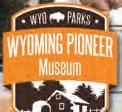

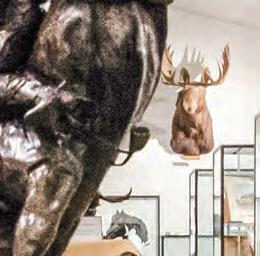

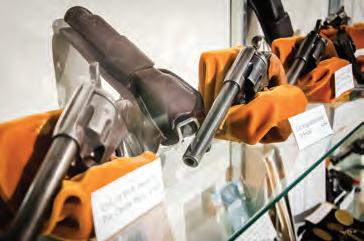



Among the collections you’ll find stories of area cowboy Wild Horse Robbins and his adventures gathering wild mustangs and an outstanding collection of American Indian artifacts. Rodeo contractor Charlie Irwin’s larger than life biboveralls are always a favorite among children visiting the museum, as is the tepee used in the film Dances With Wolves.
Important chapters in American history are told in Glenrock and across the surrounding countryside. It’s the early day tale of the West we know today.






From the emigrant trails to the Pony Express and the telegraph, Glenrock’s history is heavily intertwined with some of the most colorful chapters in American history. That story is told at the community’s Deer Creek Museum.
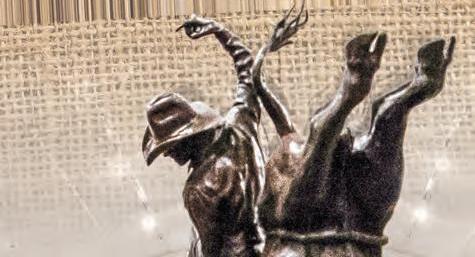
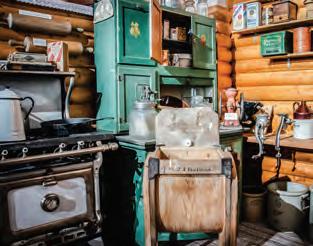
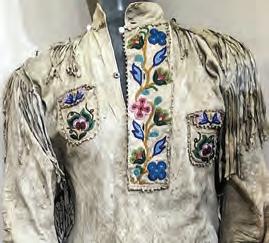


Venture north from Douglas, Wyo., on Highway 93 to Fort Fetterman to learn more about the pioneering days of the Bozeman Trail!

Visitors to Fort Fetterman — only 11 miles northwest of Douglas — are encouraged to walk the grounds where interpretive signs tell the story of the fort that was abandoned in 1882.
Visitors to the site will also find much more beyond the fort itself of interest. The area features many historic markers and beautiful vistas that add to the richness of the story of Fort Fetterman.


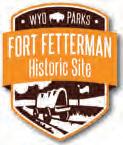


visit us online at












































wyoparks.wyo.gov, or find our Facebook page for hours.







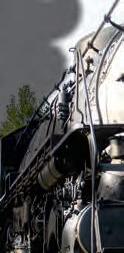
The Douglas Railroad Museum & Visitor Center is housed in the historic FE & MV Railroad Passenger Depot. The building is listed on the National Historic Register and is surrounded by seven historic railcars, including the Chicago Burlington and Quincy Railroad 4-8-4 Steam Locomotive #5633.
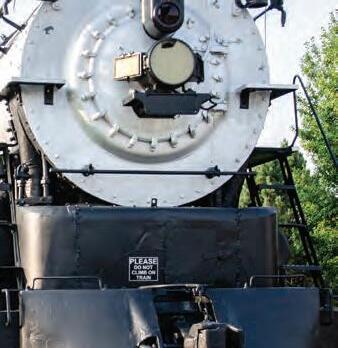
Discover how the West was truly won!

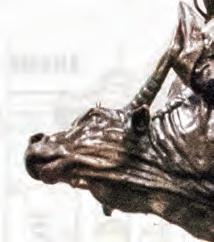











[Re. “The Trial of Billy the Kid, by David G. Thomas, Autumn 2022:] The image on P. 51 of the Billy the Kid Gift Shop [the former Doña Ana County Courthouse] in Mesilla, N.M., centers on the front entrance, featuring a painting of saloon doors with people looking out as you look in. I did that painting when I was 19 and living in Tucson with other artists at the time. The owner, whose name I can’t recall, bought the wood to my studio at Las Canastas, on Prince Street, and I painted it there. There were two wooden panels, and the batwing doors were overlaid after he purchased the panels and returned to Las Cruces. He was clear about wanting the people to be looking out, as though over a door.
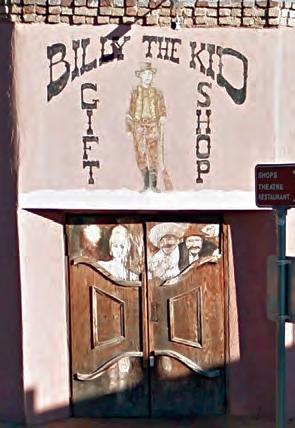
So much fun to see it again! I am no w 79, and I’m sure the painting has been retouched many, many times since installation.
Rena Paradis Las Cruces, N.M.I was very pleased to see the informative article [“The Night the Ruggles Brothers Met ‘Judge Lynch,’” by Matthew Bernstein, Autumn 2022] on my notorious ancestors the Ruggles brothers, John and Charles. They were first cousins of my great-grandmother Augusta Florence Ruggles, who was born in Woodland, Calif., in 1860. She was the daughter of Fernando Cortez Ruggles, who came to Placerville looking for gold along with brother Lyman in 1850. Their brother Ely did not come with them from Pennsylvania, staying to care for the family’s farming interests, expecting to see his brothers if and when they returned.
Needless to say, by the time I came along in 1943, John and Charles were not mentioned much in the family. In fact, I had not heard of them until I saw your August 1995 article [“The Struggles of the Ruggles,” by Harold L. Edwards] and asked my grandmother about them. I had seen their names in our family’s genealogical records. She was 90 at the time and was still ashamed about this black spot on the family name. She had been born in 1904 in Esparto, Calif., and raised in Woodland. Undoubtedly she had known much about them but never mentioned it to me. There are still a number of Ruggles relatives in and around Woodland, though I am not in contact with them.
I am fortunate in that most of my close family lines are pioneers, some prominent, stretching back to [Massachusetts Bay Colony] Governor John Winthrop. I have read many of their accounts and still have Ely Ruggles’ book, Recollections of a Busy Life. I also have three journals my grandfather kept sporadically from 1919 until his death in 1967.
History was not of much interest to me while growing up, until I started looking into my family history and finding recognized historical figures from the [California] Gold Rush, Civil War, French and Indian War, and War of Independence. People I had read about in history books came alive to me. Thank you, Mr. Edwards and Mr. Bernstein for this enjoyable article.
Michael Lee San Carlos, Calif.Matt Bernstein responds: Thanks, Michael. After reading your letter, I dug up Recollections of a Busy Life . Fascinating stuff. I particularly enjoyed Ely Ruggles’ description of Pasadena, which he called “that paradise on earth.” Having lived in Pasadena, I couldn’t agree more.
I started out many years ago with the Louis L’Amour Western Magazine and was disappointed when that ceased printing, and I was turned over to Wild West. All these years later I am a big fan. I just want to say that if Wild West ever stops being printed, I will stop being a subscriber. I tried going electronic with a trade publication I subscribe to and never read it. I switched back to print. I spend way too much time on computers, so please keep the print edition coming. I love relaxing in a comfy chair and escaping to the ever compelling Wild West!
Larry Cagle Bandon, OregonEditor responds: We, too, spend way too much time on computers and are protective of the print edition of Wild West. Keystrokes just can’t beat the sound of rustling pages.
Send letters by email to wildwest@historynet.com
Many congratulations on a great Western magazine. I have been collecting Wild West since it first appeared in our local news agent back in December 1993. Each year since I have had the six bimonthly issues hardbound and have now quite an extensive Wild West library. As the magazine has recently gone quarterly, I’ll have eight issues (two years) bound into one volume—save a few dollars. I certainly look forward to receiving each issue and also your emailed newsletter.
Please include your name and hometown @WildWestMagazine
Paul Raspin Riverside, Tasmania Australia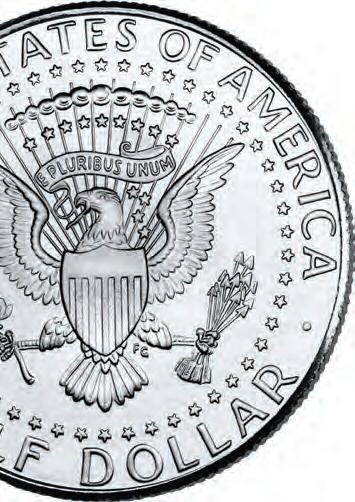
Nowown an exclusive US half dollar enhanced by Mystic to commemorate legendary Native American warrior Geronimo. Worth $9.99 – it’s yours FREE – send just $2.95 for shipping and guaranteed delivery.
A historic image of Geronimo has been bonded to a US half dollar. Taken in 1887, the portrait pictures the Apache leader during what was known as “Geronimo’s War.” This coin is available only from Mystic.
Send for your free Geronimo history coin today. You’ll also receive special collector’s information and other interesting coins on approval. Strict limit of one coin. Satisfaction guaranteed.
FREE Geronimo Coin
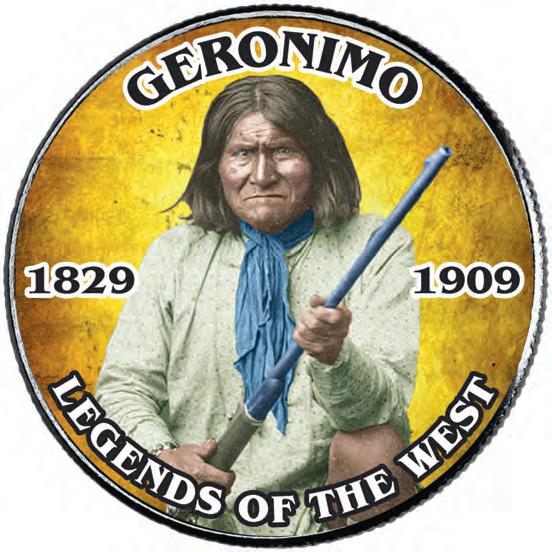

❏ Yes! Send me the Geronimo history coin. Enclosed is $2.95 for shipping and guaranteed delivery. Strict limit of one coin. Satisfaction guaranteed. Quick order at MysticAd.com/IU153
Name _______________________________________________________

Address _____________________________________________________
City/State/Zip ________________________________________________





❏ Check or money order
❏ Visa
Please send payment to: Mystic Dept. IU153, 9700 Mill St., Camden, NY 13316-9111

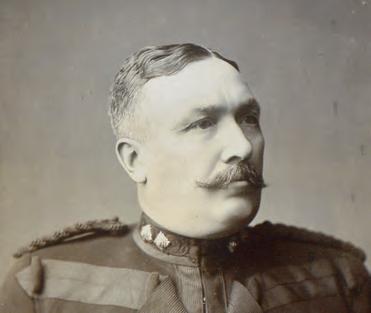
1 Wyatt Earp The “Lion of Tombstone” was over the hill, pudgy and graying when he headed for the Klondike in 1897, initially accepting a temporary stint as a lawman in Wrangell, Alaska (see related story, P. 20). He and a pregnant Sadie, his common-law wife, turned back at Juneau. A year later they again tried for the Klondike, setting out on the “rich man’s route” up the Yukon River from St. Michael, Alaska, before becoming iced in that winter with boxing promoter Tex Rickard and novelist Rex Beach. Finally giving up on the Klondike, the Earps joined the Nome Gold Rush, Wyatt and a partner opening the two-story Dexter Saloon.

3 Bill McPhee McPhee drifted into the Yukon in 1888 and later opened saloons in Forty Mile, Dawson City and Fairbanks. He grubstaked such successful prospectors as C.J. Berry and Frank Dinsmore, Berry later returning the favor by paying to rebuild McPhee’s fire-ravaged Fairbanks saloon. During the bitterly cold winter months McPhee transformed his Dawson saloon into housing for the poor, saving their lives. Not until 1921 did age and failing eyesight finally force the saloonman into retirement in San Francisco.
2
Jack London If London hadn’t ventured north, he would have been forever linked to maritime literature for his 1904 novel The Sea-Wolf. On arrival in the Klondike in 1897 he was no longer the young innocent. Among other escapades, he helped save a family from drowning on the Yukon River and spent weeks patronizing Klondike saloons. A year later, broke and battling scurvy, he continued downriver to the Bering Sea and worked his way home to California on a steamer. London was not only a great writer, but also the real deal.
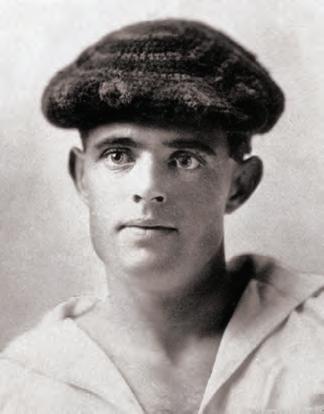
4 Jefferson “Soapy” Smith Elbowed out of Denver in 1897, Smith and gang headed north for the Klondike just as it boomed. Soon he controlled both Wrangell and Skagway through murder, intimidation and imaginative con jobs. It all proved bad for legitimate business, as homebound prospectors instead opted for the onward Yukon River route. Soapy met his end in a classic 1898 gunfight with vigilante Frank Reid on Skagway’s Juneau Wharf.
5 Clarence “C.J.” Berry Top dog of the “Klondike Kings,” Berry started out as one of McPhee’s bartenders before the saloonman grubstaked him. C.J. found so
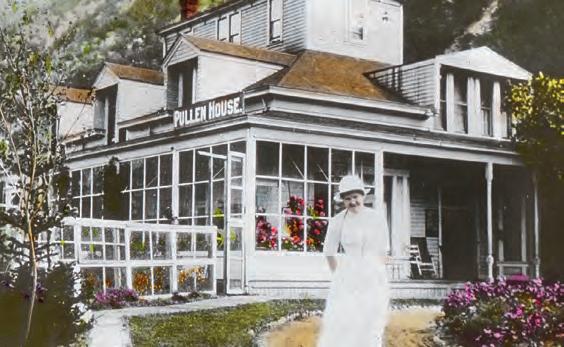

much gold that he reportedly left a bucket of nuggets and a bottle of whiskey outside his cabin with a sign reading, Help Yourself. Unlike most riches-to-rags prospectors, however, he invested in oil-rich properties in California, exponentially increasing his fortune.
6
Harriet Pullen
The pioneering Pullen arrived in Skagway with only $7 and began making pies to sell to prospectors. With her profits she bought a cabin, sent for her husband and four kids and started a freighting business hauling goods over the White Pass Trail. When the rush subsided, she opened the Pullen House. Catering to high society, the hotel made Harriet and family a fortune. She died there in 1947.
day, and Texas Jack earned fame as the first entertainer to popularize the cowboy onstage. But his stardom was short-lived, as he was tragically stricken with pneumonia and died on June 28, 1880, a month shy of his 34th birthday. A heartbroken Morlacchi became a recluse and died six years later of cancer. Kerns is the author of the 2021 biography Texas Jack: America’s First Cowboy Star (read his award-winning article and a review of his book online at HistoryNet.com).
7
Sam Steele
The enduring image of the Mounties stems from the Klondike, and the superintendent of the North-West Mounted Police division in the Yukon was Steele. With relatively few men the no-nonsense Steele established customs posts atop passes into the Yukon, ensured prospectors brought enough goods to support themselves and tamped down on crime, bringing order out of disorder.
—Mike CoppockWild West contributor Matthew Kerns (below) has earned the 2023 Western Heritage Award for best magazine article from the National Cowboy & Western Heritage Museum in Oklahoma City. The award recognizes his April 2022 cover story
“‘Texas Jack’ Takes an Encore,” which relates the bittersweet story of iconic American cowboy John Baker “Texas Jack” Omohundro. A Virginian
This marks Wild West’s seventh lifetime Western Heritage Award. The award itself—a bronze by sculptor John Free of a cowboy on horseback known as the “Wrangler”—was first presented by the museum in 1961. Past recipients have included such Western legends as director John Ford, actors John Wayne and Kevin Costner, composers Dimitri Tiomkin and Elmer Bernstein, historians Robert Utley and Mari Sandoz, authors Elmer Kelton and Larry McMurtry and a host of other luminaries in Western music, film, television and literature.
Coincidentally, this year’s recipient of the Wrangler for best art/photography book—Ranchland: Wagonhound , by Anouk Krantz—is the subject of our feature portfolio (see P. 62). In it Wyoming native Candy Moulton examines the parallels between ranching in the Old West and life on Wyoming’s sprawling Wagonhound Ranch, the subject of Krantz’s spectacular images.
For a full list of recipients visit nationalcowboymuseum.org/collections/awards/wha.
You guessed it—in addition to his 2023 Wrangler, Matthew Kerns has also earned Western Writers of America’s 2023 Spur Award for best magazine article for his April 2022 cover story “‘Texas Jack’ Takes an Encore.” That’s a rare double win for Kerns and Wild West . It marks this magazine’s sixth lifetime Spur, an award WWA has bestowed on Western writers, poets, songwriters and screenwriters since 1953.
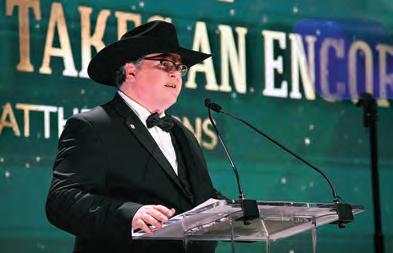
by birth, Omohundro fought for the gray in the Civil War and took up wrangling steers in postwar Texas. After working as an Army scout and trail guide alongside friend Will Cody during the Indian wars, Texas Jack toured with Buffalo Bill and Wild Bill Hickok in Western-themed stage productions. Omohundro later married co-star Giuseppina Morlacchi, a popular Italian prima ballerina. They were the celebrity couple of their
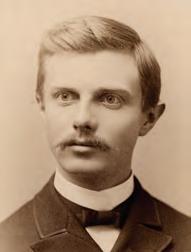
Among other Wild West contributors to receive 2023 Spurs are Melody Groves for best biography (Before Billy the Kid) and Candy Moulton for best documentary script (The Battle of Red Buttes, co-written with Bob Noll). Emmy-winning director Walter Hill won the spur for best screenplay (Dead for a Dollar). Best known for the films Broken Trail and Geronimo and an episode of the TV series Deadwood, Hill was recently interviewed by Wild West (read online at HistoryNet.com/ walter-hill-interview). Spurs will be presented at WWA’s annual convention, held this June in Rapid City, S.D. For a full list of recipients visit westernwriters.org/winners.
‘Since the days when the fleet of Columbus sailed into the waters of the New World, America has been another name for opportunity, and the people of the United States have taken their tone from the incessant expansion which has not only been open but has even been forced upon them.... The American energy will continually demand a wider field for its exercise. But never again will such gifts of free land offer themselves’
—So concluded historian Frederick Jackson Turner in his 1893 essay “The Significance of the Frontier in American History,” in which he proclaimed the “closing” of the frontier to a gathering of the American Historical Association at the World’s Columbian Exposition in Chicago.
On March 4 and 5, 2023, Holabird Western Americana Collections [holabirdamericana.com] of Reno, Nev., auctioned another 422 lots of artifacts recovered from the wreck of the steamship Central America , which sank in a storm off the Carolinas on Sept. 12, 1857. The ship went down with 425 of its 578 passengers and crew, among whom were men returning from the California Gold Rush. It carried a cargo of gold worth some $765 million. The top seller of the recent auction was a 2-pound gold ingot, which brought $138,000, far above its gold content value of $59,000. Another haunting relic, a daguerreotype of a young woman dubbed “Mona Lisa of the Deep” (above), fetched $73,200.
—Famed big-game hunter Ben Lilly (see “Lilly of the Field,” by Aaron Robert Woodard, Spring 2023 Wild West) whispered these words hours before his death near Silver City, N.M., on Dec. 17, 1936, just two weeks shy of his 80th birthday. The once vigorous outdoorsman, famed for his tireless, dayslong hunts after bears and mountain lions, had been in physical and mental decline for some time and confined to a bed in a county home for the indigent.
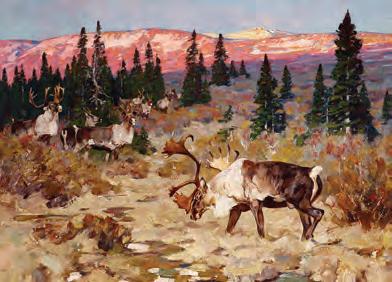
Wild West History Association members recently gathered at Oak Hill Cemetery in Lampasas, Texas, to unveil the repaired headstone of Albertus Sweet, who served two terms as sheriff (1873–78) of that town in the heart of the Lone Star State.

At a January event in Las Vegas, Nev., Lovig Auctions sold firearms and artifacts with reported ties to the June 25–26, 1876, Battle of the Little Bighorn. The items were from the collection of Wendell Grangaard, owner-operator of the since closed Guns of History museum in Mitchell, S.D. Among the 479 items were artifacts Grangaard reportedly tied to both 7th U.S. Cavalry and Lakota participants in the battle, including weapons alleged to have belonged to Lt. Col. George Armstrong Custer and Oglala war leader Crazy Horse. While some question the authenticity of Grangaard’s claims, Oglala Sioux Tribe President Frank Comes Out wrote Grangaard requesting the withdrawal of 111 items of “cultural significance to warrant protection under federal law.” Grangaard counters that he legally purchased all items over the past 60 years, thus federal repatriation laws don’t apply. “Wendell, in fact, did pay money for them,” said auctioneer Brian Lovig. “To me it’s the free market.”
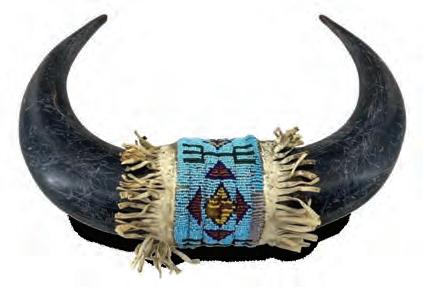
On Dec. 9, 1880, the 38-yearold lawman was serving as a deputy city marshal in Belton, Texas, when killed in a gunfight while helping a fellow deputy make an arrest. Sweet’s remains were returned to Lampasas for burial, and in the intervening decades his headstone at Oak Hill Cemetery had suffered damage.
Ongoing economic woes haven’t hurt the art market much, judging by the results of recent backto-back Bonhams auctions. The Los Angeles division of the British auction house [bonhams.com] realized more than $5.4 million on the collection of the late financial analyst G. Andrew Bjurman, whose works spanned more than 150 years of Western art. A dozen lots fetched more than six figures, including Walter Ufer’s The Water Women ($567,375) and Oscar Edmund Berninghaus’ Ancient Forest ($542,175). Other top sellers included paintings by Frank Tenney Johnson, Maynard Dixon and Joseph Henry Sharp. That same day Bonhams realized nearly $2 million with a follow-up Western art auction. Highlights included wildlife artist Carl Rungius’ The Intruder (below, $529,575) and Charles Schreyvogel’s bronze The Last Drop ($353,175).
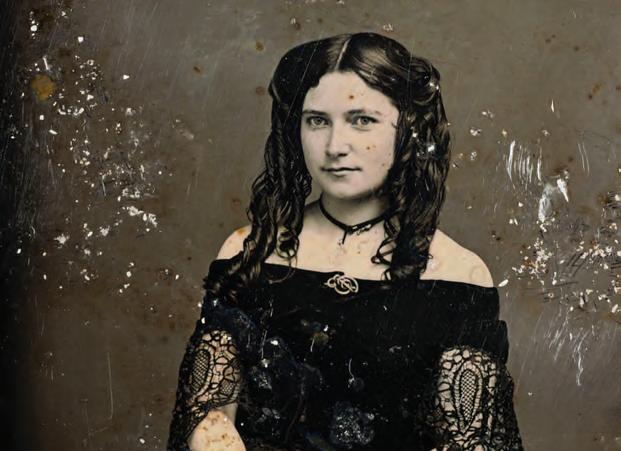

With his guns blazing and his reins in his teeth, Duke lit up the silver screen. Now that iconic scene comes galloping to life in a gleaming tribute to his Academy Award®-winning role.

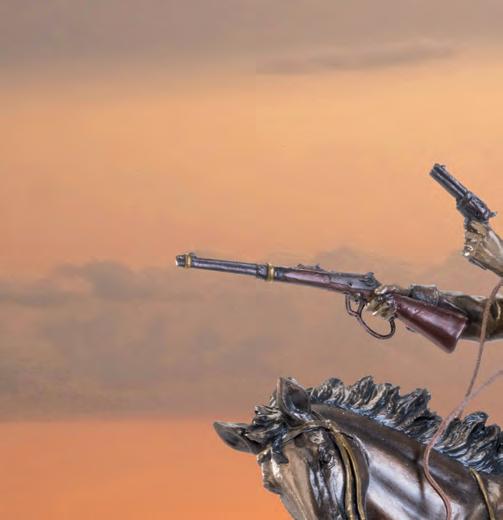
The John Wayne: Heroic Charge Cold-Cast Bronze Masterpiece Sculpture is artisan hand-crafted in cold-cast bronze for a thrilling sense of motion. This fine collector’s edition stands tall in the saddle at 11 inches high and is available ONLY from The Bradford Exchange.
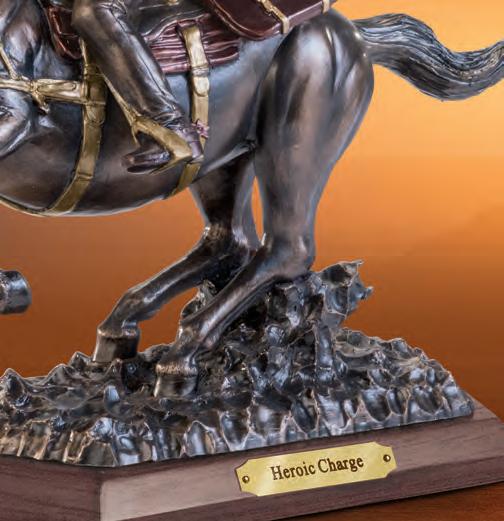

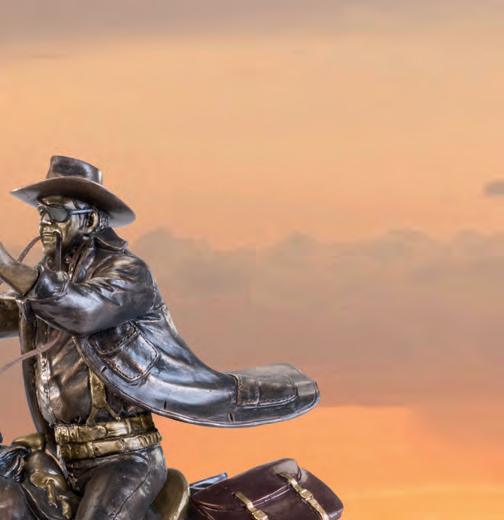

Significant demand is expected for this exclusive presentation, limited to 295 casting days. Make it yours in four installments of $42.50 for a total of $169.99*, backed by our unconditional, 365-day money-back guarantee. Send no money now. Return the order coupon today!

Actress Raquel Welch, 82, died in Los Angeles on Feb. 15, 2023. Ranked among the sexiest stars of the 20th century, she debuted in Westerns on the small-screen series The Virginian (1962–71) before co-starring in Bandolero! (1968) with James Stewart, who said of her performance, “I think she’s going to stack up all right.” As rebel leader in 100 Rifles (1969) she stopped a Mexican troop train, and the show, with a shower beneath a water tower.
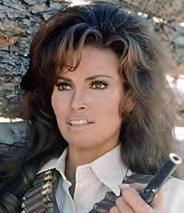
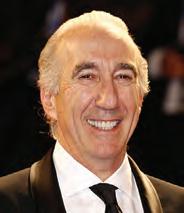
Academy
Award–winning producer Walter Mirisch, 101, died in Los Angeles on Feb. 24, 2023. Founder of the independent Mirisch Corp., he produced 68 films for United Artists, including Man of the West (1958, starring Gary Cooper) and The Magnificent Seven (1960, starring Yul Brynner, Steve McQueen and those other five gunmen). The first Western Mirisch produced was Wichita (1955), starring Joel McCrea as a pre-Tombstone Wyatt Earp.
On Feb. 4, 2023, historian Bob Ernst, 80, died in Perkins, Okla. For the past three decades Ernst dedicated himself to researching the stories of lawmen who died in the line of duty for the U.S. Marshals Service. He and co-author George Stumpf compiled their accounts in the 2006 book Deadly Affrays: The Violent Deaths of U.S. Marshals. Ernst also wrote the 2009 book Robbin’ Banks and Killin’ Cops, about Depression-era Oklahoma outlaw Lawrence DeVol, as well as articles about lawmen for various Western association journals.

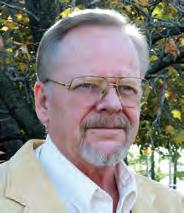
Author Gerald (“Jerry”) Kean Keenan, 90, died in Longmont, Colo., on Nov. 19, 2022. Among the four feature articles in the June 1988 premier issue of Wild West was Keenan’s “Cheyenne Island Saga,” about the dramatic September 1868 Battle of Beecher Island. In the 1996 compilation book Best of the Wild West that article was the first included. Over the decades Keenan wrote seven more Wild West features. His last, “Fury on the Spokane Plains” (August 2018), told of the little remembered Yakima War in what is now the state of Washington. Keenan, who was born in Waukon, Iowa, and grew up in Milwaukee, also wrote books, including Encyclopedia of American Indian Wars, 1492–1890 (1997), The Wagon Box Fight: An Episode of Red Cloud’s War (2000), The Life of Yellowstone Kelly (2006), The Terrible Indian Wars of the West: From the Whitman Massacre to Wounded Knee, 1846–1890 (2016) and West of Green River: A Novel of the Bonneville Expedition, 1832–1835 (2011). He edited Western Writers of America’s Roundup magazine from 1978 to ’80 and later wrote articles and book reviews for that publication.
A 26-mile stretch of Highway 9 in Claiborne Parish, La., has been dedicated as the “Sheriff Pat Garrett Memorial Highway.” Garrett, the slayer of Billy the Kid in New Mexico Territory in July 1881, was born on June 5, 1850, in Alabama’s Chambers County, but at age 3 he moved with his parents, John and Elizabeth Garrett, to Claiborne Parish. The Garretts established a farm 6 miles northeast of Homer, La., and also kept a second home in town. John and Elizabeth both died in the late 1860s, and all the property was auctioned off to satisfy debts. In January 1869 Garrett saddled his horse and rode west in search of a new life in Texas and, later, New Mexico Territory. The memorial highway runs between Homer and Junction City, appropriately passing the site of the Garrett family farm (a historical marker was erected at the location three years ago). Both the historical marker and memorial highway were projects originated by the Claiborne Parish Public Library.
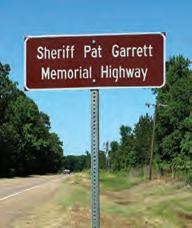
Through April 7, 2024, Santa Fe’s Museum of International Folk Art [internationalfolkart.org] presents “Ghhúunayúkata/ To Keep Them Warm,” an exhibit of 20 parkas representing six Alaska Native communities: Yupik, Iñupiaq, Unangan (Aleut), Dena’ina, St. Lawrence Island Yupik and Koyukon.
Crafted out of a selection of furs, skins and intestines, the items range from historic mid-19th century parkas to contemporary garments. Illustrations, photographs and traditional dolls provide context for how parkas are used in both ceremonial and everyday life.













North Dakota’s legendary people, like Lewis and Clark, Sakakawea, Sitting Bull, Custer and places like Theodore Roosevelt National Park have a story as fascinating today as it was 200 years ago. Visit the Northern Plains with its frontier army forts and Indian villages standing ready to greet you.

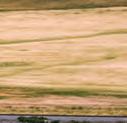




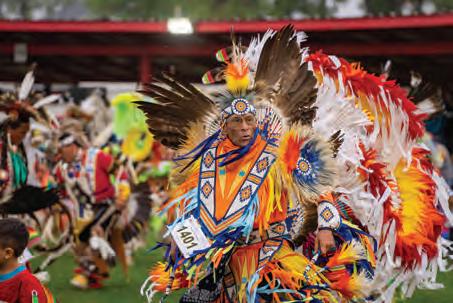






Come, explore today!


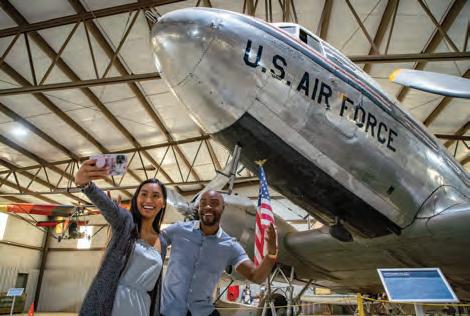
Michael Dante, 91, appeared in nearly 200 big- and smallscreen productions. Western film buffs would recall him best from such movies as Westbound (1959), with Randolph Scott; Apache Rifles (1964) and Arizona Raiders (1965), both with Audie Murphy; and as the title Blackfoot chief in Winterhawk (1975). Born Ralph Vitti (Dante picked his professional name after signing with Warner Bros.) in Stamford, Conn., in 1931, he started acting in the fourth grade and majored in drama at the University of Miami. Before moving to Hollywood, he played professional baseball in the Boston Braves and Washington Senators organizations. Nursing a shoulder injury, he took a screen test arranged by big band legend Tommy Dorsey and left pro ball. From 1994–2008 he hosted the radio series The Michael Dante Classic Celebrity Talk Show , out of Palm Springs, Calif. Dante has since turned to writing both nonfiction and fiction, including the autobiography Michael Dante: From Hollywood to Michael Dante Way (2013); My Classic Radio Interviews With the Stars: Vol. 1 (2021), co-authored by wife Mary Jane Dante; and such novels and novellas as the post–Civil War Six Rode Home (2018), the Western sequel Winterhawk’s Land (2017) and the redemption tale Macabe’s Journey (2022), all from BearManor Media. Dante [michaeldanteway.com] recently took time to speak with Wild West about his various careers.
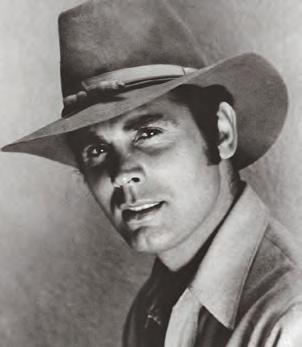
Jesse James. He was a colorful character, very deceptive and knew the territory and despised the railroad. I wanted to make him a colorful character. He was a great horseman, and he and his brother were a team, and his gang was a family. He began to get a little too aggressive, which led to his demise. I made notes about his character, but I never got a chance to play him.
I had read a great deal about him and had tremendous respect and love for native Americans. He was my favorite because he was a visionary and a militarist, a deep thinker, had a high element of a spiritual side. That is the kind of man I am. I could make a wonderful marriage to this character and do something exciting and interesting and show to the American audience what kind of man and leader he was.
But [producer David Weisbart] passed away after the seventh show—died of a heart attack on the golf course—and we were knocked off the air because of political correctness. Custer became a very bad name, unfortunately, so we were off after 17 shows. So I never really got a chance to share with the audience what I eventually was going to contribute to the character and the story.
What are some favorite memories from your days playing pro baseball?
I was underage but signed to a pro contract with a $6,000 bonus. When I received that bonus, the first thing I did was buy our family a brand-new four-door Buick—whitewall tires, radio and heater. It was a beautiful sedan.
Number two was putting on the major league uniform. The Washington Senators invited me to spring training in 1955 in Orlando, Fla., and the first moment I put on the uniform, I sat by my locker, turned my back on everyone and just shed tears.
Who was your favorite ballplayer and what movies did you like as a boy?
Joe DiMaggio. The Westerns.
We loved Westerns and the Dead End Kids. We didn’t have any money, but theaters had exit doors. After the first running of the movie and the serials, they would open the side doors. Everybody would exit out of the side instead of going out the front. We used to sneak in!
What made you turn to writing?
It evolved. I didn’t realize I was pursuing the career of my life by treating it as an art form. It gave me encouragement from my acting experience, what I was reading, and I took notes. So I put these thoughts down on paper and thought maybe someday I’d be fortunate to write these stories, or a book or novella or screenplay, or a combination of all these things.
During my radio show and then COVID I had an ample amount of time to put these words and thoughts together.
If you were interviewing Michael Dante, what would you ask?
I would ask, “Why did you refuse a number of film and TV series?”
I did what I wanted to do, and I did it well.
Visit historynet.com/michael-dante-interview to read more.





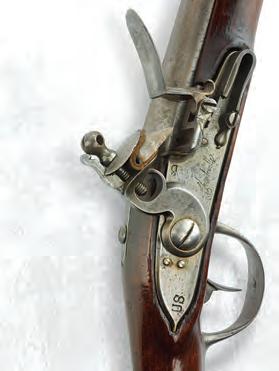


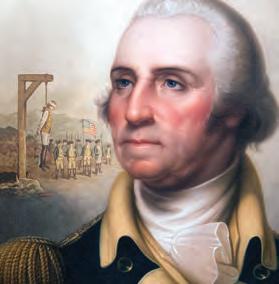

That was among several monikers attributed to dancer and vaudeville star Kathleen Eloise Rockwell (1880–1957), who, headlining as “Klondike Kate,” trod the rough boards of theater stages in post–gold rush Yukon Territory, Canada. Taken during her 1899–1902 heyday, this portrait of innocence proves only that appearances can be deceiving. Born in Kansas and raised in Washington, Kate was a flirt from an early age, enjoyed singing and dancing for older men, and was eventually expelled from boarding school. After failing to break into show business in New York City, she returned to Washington before venturing north in 1899. Kate reportedly sneaked into the Yukon, so the story goes, dressed like a boy. But it wasn’t boyish looks that got her notice as a member of the Savoy Theatrical Company in Dawson City. It was there in 1900 she met
Greek-born Alexander Pantages, owner of the Orpheum Theater and future movie theater mogul. Their stormy affair waxed and waned through 1914, when Pantages married a musician and settled a breach-of-promise-to-marry suit with Rockwell out of court. In the meantime, Kate dazzled miners with her numbers, including one called the Flame Dance, in which she emerged onstage wrapped in a continuous length of red chiffon and then spun before the footlights till fully revealed in skin-colored tights. She made a fortune in tips before the spotlight dimmed. In 1954 Kate appeared as a guest on the Groucho Marx game show You Bet Your Life alongside Walter Knott of Knott’s Berry Farm fame. The pair split winnings of $57.50—a far cry from Kate’s nightly take in the Yukon. A recluse in her dotage, she died in obscurity three years later in Sweet Home, Ore., at age 76.


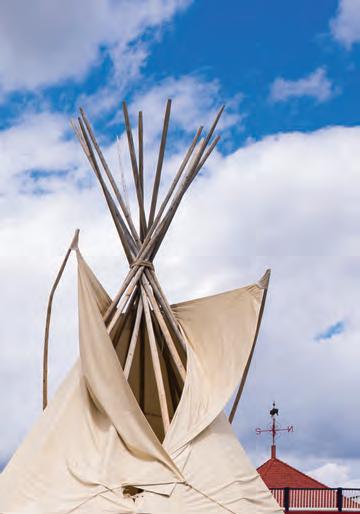


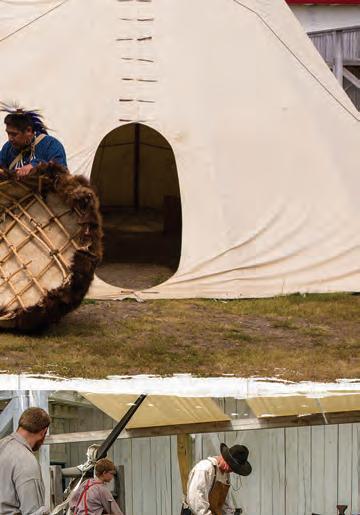
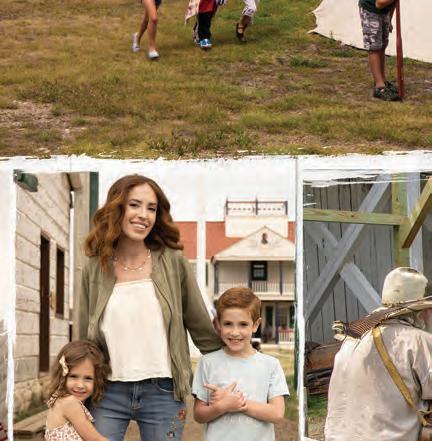
















At least a half dozen times in his life Wyatt Earp placed himself in harm’s way by pinning a tin star to his lapel. He policed two Kansas cow towns—Wichita and Dodge City—before making headlines in Tombstone, Arizona Territory. Chroniclers also record later stints as a deputy in Kootenai County, Idaho, and Cibola, Ariz. But few recall the time Earp served as a lawman in frontier Alaska amid the Klondike Gold Rush.
By year’s end 1896 Earp had hit a low point. Financial woes had forced him and common-law wife Josephine Sarah Marcus (“Sadie” to Wyatt) to change addresses often in San Francisco, for a time even living with her parents. Then came a break, as he agreed to referee a high-prof ile heavyweight boxing match between up-and-coming Cornishman Bob Fitzsimmons and brawler Tom Sharkey that December 2. Things went bad from the start. As Earp climbed through the ropes into the ring, he revealed a concealed .45-caliber Colt revolver, which he
had to surrender on the spot to a police captain before the crowd of 15,000.
In the eighth round Fitzsimmons landed a devastating uppercut, and Sharkey fell forward rather than backward, receiving what may have been an unintentional blow to the groin from Fitzsimmons. After ordering the fighters to their corners, Earp declared Sharkey the winner, citing Fitzsimmons’ foul. The crowd exploded with anger.
Fitzsimmons’ promoters took the decision to court, the boxer’s attorney claiming Earp had telegraphed friends to bet on Sharkey. Though the judge dismissed the baseless allegation as hearsay, the damage was done. Adding insult to injury, Earp was fined $50 for having carried the concealed pistol into the ring.
His reputation sullied and pockets empty, Earp was desperate for an income. In stepped fate.
On July 14, 1897, the steamship Excelsior docked in San Francisco, disembarking gold-bearing prospectors rife with rumors
of a major strike in Canada’s Yukon Territory. Two days later the steamer Portland unloaded “a ton of gold” in Seattle, confirming the rumors. At the time Wyatt and Sadie were in Yuma seeking funds for a mining venture. They sold everything they had for the passage to Alaska.
Within months more than 40 ships sailed for Alaska from San Francisco alone. Many were derelicts scheduled to be broken up in shipyards.
By then Earp himself had become something of a derelict. Pushing 50, he had grown a belly and jowls, and his trademark handlebar mustache had begun to turn gray.
Other Old West derelicts would make their way to the Klondike. Denver con man Jefferson “Soapy” Smith told his cousin, “Alaska is the last West,” before heading north to terrorize Wrangell and Skagway. Serial adventurer Luther “Yellowstone” Kelly ventured to Alaska to map the interior. Lawman Frank Canton, John Clum of Tombstone and Geronimo fame, showman “Arizona Charlie” Meadows, Denver madam Mattie Silks and “Captain Jack” Crawford, the “Poet Scout” of the West, all went north.

Wyatt and Sadie had underestimated their travel costs, given gold rush prices, and were close to going broke as their ship approached Wrangell, Alaska.
Wrangell had always been a wild place. During the gold rush a flotilla of riverboats hauled prospectors and cargo from its port up the Stikine River into the Canadian interior. Town itself comprised a motley collection of 139 cedar plank and log structures. It also held a courthouse, a jail, a customhouse, a sawmill, a brewery, a boardinghouse, a restaurant, a handful of saloons, three stores and a shoemaker’s shop. Rough plank boardwalks kept locals out of the mud under what seemed a constant rain.
Though Soapy Smith made his headquarters up the coast in Skagway, his gang initially held Wrangell in the same grip of terror, demanding a percentage of each saloon’s take and openly robbing and even murdering prospectors along the trails leading to the interior. That Wrangell was the only place in Alaska where dance hall girls performed in the nude spoke volumes about the port.

The U.S. marshal for the District of Alaska was desperately seeking a deputy to temporarily police Wrangell, as the man he’d hired wouldn’t arrive for weeks. The marshal had been keeping law and order as best he could, but eventually he’d have to return to the district capital at Sitka. It must have seemed a godsend, then, when out of the blue none other than Wyatt Earp approached him about the position. Earp considered Wrangell a “hell on wheels” town, worse than Tombstone had been.
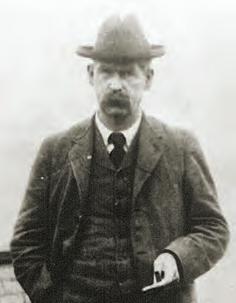
Still, he needed the money, so he accepted the temporary duty.
Realizing he represented the hated law to a sordid collection of gunmen, prostitutes, pimps, gamblers and thugs, Earp planned to sit things out as quietly as possible until his replacement arrived. That the Smith gang controlled vice in town was to his advantage. He and Bat Masterson had had dealings with Soapy when the three of them were mining the miners in Creede, Colo. How much Earp was counting on that acquaintance in order to survive in Wrangell is unclear. But he knew that as long as he kept his nose out of Soapy’s business, he’d be safe. Then it happened. One evening a burly town tough got drunk and began shooting up a saloon. Bystanders sent for the pudgy marshal. When Earp arrived and demanded the man surrender his gun, the intoxicated shooter broke into a smile. “I know you!” he exclaimed. “You’re Wyatt Earp!” Twenty years earlier Earp had thrown the man and his drunken cowboy cohorts out of a Dodge City saloon. For the rest of that evening in Wrangell the antagonists stood at the bar reminiscing about the “good old days.”
Though amused by the incident, Earp also recognized it as a close call and a reminder to lay low for the duration of his time in town. Thankfully, within 10 days of Wyatt and Sadie’s arrival his replacement arrived. As soon as the new deputy marshal stepped from the gangplank, the couple caught the first northbound steamer to Juneau. Local wags joked that Wrangell had proved “too wild for Wyatt.”
In Juneau the couple learned Sadie was pregnant, and they decided to return to San Francisco. Better to deliver their child in her parents’ home than on the Alaskan frontier. No sooner had they arrived Stateside, however, than Sadie suffered a miscarriage.
The lure of riches soon drew the couple north to Alaska again. This time they took the “rich man’s route,” sailing up the Yukon River bound for Dawson. But they were iced in for the winter. Come spring, they drifted back downriver and soon headed to the new strike in Nome, where Earp opened the Dexter, the only two-story saloon in the district. So, it was back to mining miners.
When the Earps finally left Alaska, in 1900, they carried $85,000 on them.
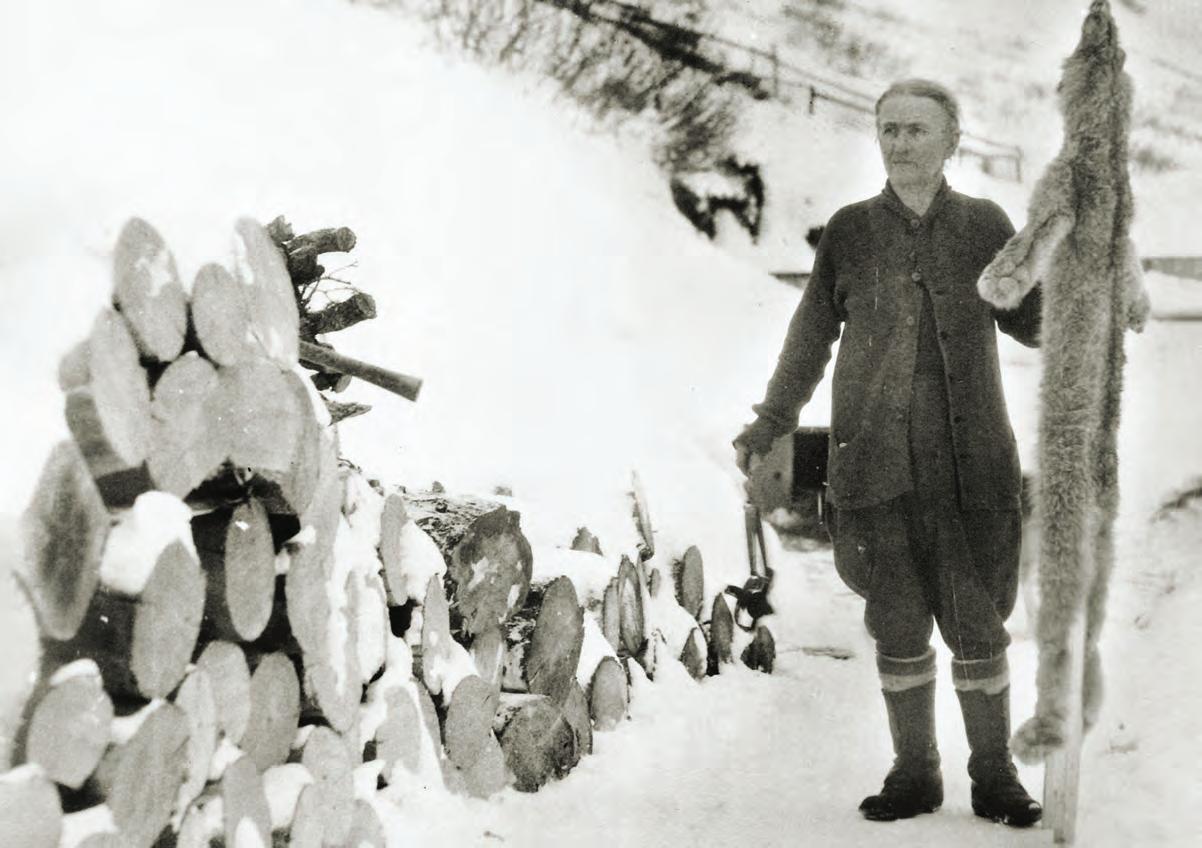 BY DENNIS GOODWIN
BY DENNIS GOODWIN
She was tough as grizzly bear claws,” one observer wrote about Fannie Quigley, who forged her own path from a dugout on the Great Plains to the Pacific Coast and then north to Alaska.
Born in Wahoo, Neb., on March 18, 1870, little Frances Sedlacek was known as “Fannie” from childhood. It was a childhood tempered with hard times. Wahoo was a village of largely Czech-speaking Bohemian immigrants from the Austro-Hungarian empire who in 1870 were being assaulted by the triple hardships of a locust plague, record-breaking blizzards and a seven-year drought. As if fate hadn’t stacked the deck against Fannie sufficiently, illness took her mother when the girl was only 5. Within a year her father remarried, and Fannie soon had three more siblings for whom to care, adding to her already
heavy workload. Like many such children of hardship, she surely longed to escape the drudgery of life on her family’s windswept homestead.
So, at age 16 she left home to follow the westward-leading Burlington and Union Pacific railroads. As she cooked for the work crews, Fannie soaked up the spirit of the frontier. Though she spoke only her parents’ native Czech at home and had scarcely any schooling, she soon learned English from the roughneck workers. As might be expected, in and among the more traditional English words and phrases she picked up some pretty colorful exclamations. Those expressions only enhanced her rough-edged persona.
Fannie followed the tracks for more than a decade. When she finally ran out of west, she turned her gaze north, having heard
the rumors of a gold strike in the Klondike region of Yukon Territory in northwestern Canada. It was a cinch most of the miners rushing toward potential riches hadn’t bothered to pack cooking supplies among their picks, shovels and pans. Hot meals, she reasoned, might be as precious to them as gold. By 1898 she’d scraped together the money for passage to Alaska.
Some accounts suggest Fannie worked for a couple of years as a dance hall girl in a Dawson saloon. Whether true or not, she soon reverted to her skills as a cook. Packing a sled with a sheet-metal Yukon stove, a tent, cooking supplies and a shingle advertising Meals for Sale, she set out for the remote gold camps. As she didn’t have money to spare for dogs, little Fannie lugged the sled herself. Despite the intense physical effort, she found her hunch was right. Miners were drawn to her mobile diner like bears to a honey tree. Not content with merely cooking for a living, Fannie jumped into the prospecting game herself and started acquiring mining claims. She also staked her claim to a ruggedly handsome miner named Angus McKenzie, whom she married on Oct. 1, 1900. The couple soon opened a roadhouse near the settlement of Gold Bottom, southeast of Dawson.
According to reports in Dawson’s Daily Klondike Nugget, the McKenzies’ marriage fell somewhat outside the bounds of wedded bliss. They were said to mix it up regularly with fights resulting in mutual black eyes. Three years after they’d tied the knot, it unraveled, and Fannie stomped out the front door. That stomping extended into a 500-plus-mile hike down the banks of the Yukon River to Rampart, Alaska.
After prospecting around Rampart, Fannie pursued rumored gold in several neighboring camps. None filled her pockets, so in 1906 she followed another lead south to Kantishna, a camp in the shadow of towering Mount McKinley. Originally called Denali, a Native Alaskan word meaning “High One,” the mountain had been renamed by a prospector in 1896 in support of then presidential candidate William McKinley, despite the fact the politician had never, and would never, set foot in Alaska. (The Interior Department restored the name Denali in 2015.)
Between 1907 and ’19 Fannie staked some 26 claims. While most didn’t pan out, one thing did gleam for her in Kantishna—another good-looking fellow. Long-legged Joe Quigley was a locally known frontier jack-of-all-trades who combined the skills of hunting, carpentry, mining and blacksmithing. Fortunately, their pairing proved far less explosive than that of Fannie and her ex. On Feb. 2, 1918, the couple married and for the next

two decades worked their Red Top Mine, leased other claims, and fed and boarded guests at their Kantishna residence.
The Quigleys made quite an interesting visual impression, with Joe topping 6 feet and Fannie not quite reaching 5. She more than compensated for her diminutive stature with her feisty personality. One day she and Joe ventured out separately to hunt. Joe returned to the cabin emptyhanded, his shame only escalating at the sight of Fannie proudly dressing out the carcasses of two caribou, a bear and a moose. Never one to mince words, she tossed him her skirt. “Here,” she blurted, “you do the housework today. Gimme your pants.”
By necessity Fannie learned a wide range of wilderness skills. Another day Joe showed up with his nose split open in the wake of a bush plane accident. Without hesitation Fannie cleansed the wound and stitched it with catgut. “I sewed him the way I do my moccasins,” she later related, “with a baseball stitch.”
During her years as a Kantishna homesteader Fannie also became known as one of the best cooks in Alaska. Despite the brief 10-week frost-free growing season, her prolific garden provided a steady supply of vegetables, even in winter. She utilized the mine shafts and tunnels of the Red Top to keep her produce frozen year-round. Her recipes for blueberry or rhubarb pie included a step city slickers’ recipes didn’t list—mushing one’s dogs 125 miles to the nearest town (Nenana) for flour and sugar. The secret ingredient in those pies also took a little doing—shooting a nice fat bear and dragging it back to the cabin to be rendered into lard for her flaky crusts.
By the mid-1930s, whether due to environment or temperament, the Quigleys’ marriage was showing signs of wear and tear. In 1937 they leased their mining claims to the Red Top Mining Co. and split the income as part of a divorce settlement. Joe then headed to Seattle. Fannie kept the Kantishna cabin, where she died at age 74 on Aug. 22, 1944. Her legacy lives on. In 2000 Fannie was inducted into the Alaska Mining Hall of Fame, while the Quigleys’ old cabin remains standing and open to visitors within Denali National Park and Preserve.
Whatever subject or scene Rick Kennington paints—American Indians in the saddle or in camp, contemporary or Old West cowboys at work—his blend of techniques lends his works a life of their own. But that wasn’t always the case.
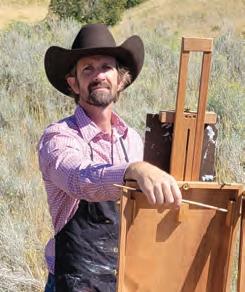

“I used to paint thin with many layers,” recalls the artist [rickkennington.com] from his home studio in North Salt Lake, Utah.
Rick KenningtonHis mentors told him to use more paint—and when one’s mentors include such masters in their own right as Grant Redden, Jason Rich, Chad Poppleton and Charles Dayton, one listens.
“I was instructed to purchase the larger tubes of paint to encourage me to have heavier loads of paint on my pallet and to have the stiffer bristle brushes to help gather heavy loads,” Kennington explains. “Over time I became fascinated with paintings that have a high paint quality—meaning, the paint and texture have aesthetic appeal.
“It’s amazing at times to remember how different my mindset was 20 years ago,” he says.
“I thought I had a good handle on painting. However, the more I learn and study, the more I realize I have much further to go. I enjoy seeing how my work has evolved and progressed over the years.”
That progression began in boyhood when he watched his older sister draw and sketch and tried to match her skills. His parents fostered their son’s budding interest with gifts of drawing pads, pencils and instructional art books. Family trips to Jackson, Wyo., stirred Kennington’s love of Western subjects.
“I remember walking into the Legacy Gallery, which is no longer there, and being blown away by all the paintings from the best contemporary artists…artists such as Bill Anton, Clyde Aspevig, Tom Browning and Jason Rich,” he recalls. “I wondered how amazing it would be to have my artwork hanging on the walls in a gallery like that.”
Thus inspired, Kennington worked hard and earned an art scholarship to Salt Lake Community College. He later transferred to the University of Utah, where he attended workshops, learned from established artists and gradually shed bad habits.

“I remember asking one of my mentors, ‘How do I get my work in a gallery?’” he recalls. “After a thoughtful pause came the sincere reply, ‘Become
so good at painting that they can’t ignore you.’ I took that to heart and continued to improve my skills.”
His focus on the West came naturally.
“I come from deep-rooted Western pioneer stock,” he says. “In the late 1800s my great-greatgrandfather William Henry Kennington settled Star Valley, Wyo., where he raised his family.”
The artist spends most of his time in the studio, though he paints plein air a few times a year. “Painting outdoors is more of a break for me,” he says.
“I enjoy paintings that look like paintings,” Kennington says of his more recent work. “I aim for accuracy in drawing, value and color. But I enjoy using thick paint and challenging myself with a looser, or Impressionist, approach.”
The artist’s commitment to the West remains as firm as his commitment to his craft. “Growing up in the West and being outdoors is a major part of my life,” Kennington says. “I’ve enjoyed growing up around horses, ranches and the Western landscape. Much of the Western ranches and landscapes have been lost with new development, especially in Utah. I feel art is a way to help preserve and maintain the history and culture of the West.”
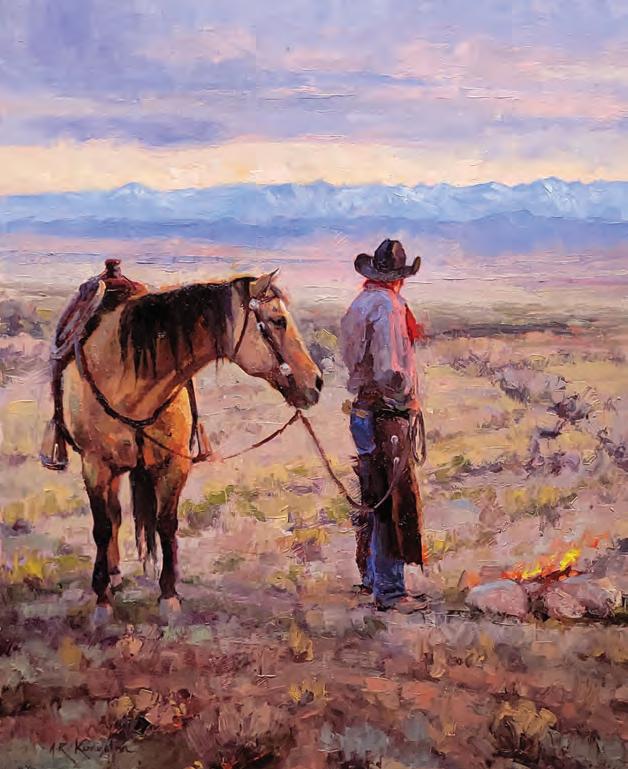
Kennington has family roots in Wyoming’s Star Valley and grew up around horses and wide-open landscapes, influences that shine through in such works as (clockwise from top left) Finders Keepers (a 24-by-36-inch oil) A Light on the Horizon (a 24by-20-inch oil) and Hauling Ass (a 30-by-18-inch oil).

THE LAKOTA WARRIOR MARKED A DECADE-PLUS STRING OF VICTORIES, BUT HIS CLAIM TO HAVE KILLED GEORGE CUSTER IS SUBJECT TO DEBATE
BY DENNIS GOODWINAfter solemnly surveying the mingled corpses of fellow warriors and 7th U.S. Cavalry troopers on the hillside above Montana Territory’s Little Bighorn River (the Greasy Grass to Indians), the pair of Lakota warriors focused on the lifeless body of Lt. Col. George Armstrong Custer at their feet. “Long Hair thought he was the greatest man in the world,” one said. “Now he lies there.” White Bull, the warrior he was addressing, had killed two men in battle that morning, June 25, 1876. “Well,” White Bull replied, “If that is Long Hair, I am the man who killed him.”
Historian Stanley Vestal recounted this alleged conversation in the February 1957 issue of American Heritage, published a decade after White Bull’s death. Vestal had interviewed the warrior chief and said White Bull had asked not to be revealed as Custer’s killer during his lifetime, to avoid retaliation.
“A tall, well-built soldier with yellow hair and a mustache saw me coming and tried to bluff me,” White Bull had told Vestal. The soldier drew a bead on the warrior with a rifle. Before he could fire, White Bull rushed in, and the soldier threw the rifle at him, missing. According to White Bull, the two then locked in hand-to-hand combat. Amid the dust and smoke, he noted, “It was like fighting in a fog.” Grabbing White Bull’s braids, the soldier pulled the warrior close and tried to bite off his nose. White Bull called for help from a pair of fellow Lakotas, but their blows mostly landed on their friend as the combatants whirled around. Finally, the soldier drew his pistol. Wresting it away, White Bull repeatedly struck the soldier over the head with it and then delivered two shots—one to the soldier’s head, another to his chest. Though he didn’t recognize the man he’d killed, White Bull knew he’d slain a worthy opponent.

With the publication of Vestal’s article Minneconjou Chief White Bull joined the short list of
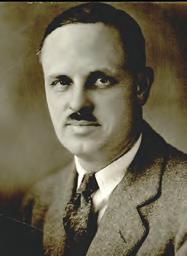
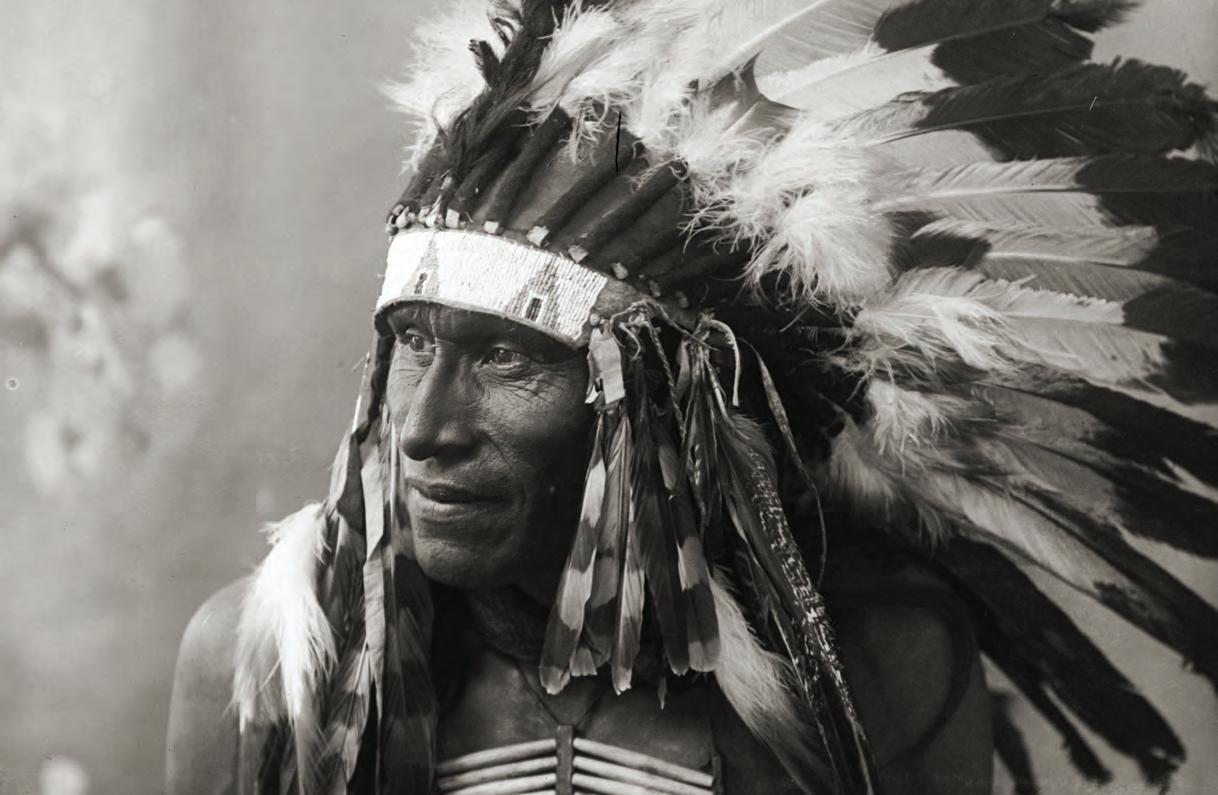
5 Countries, 5 Pure Silver Coins!

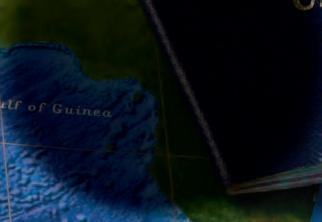

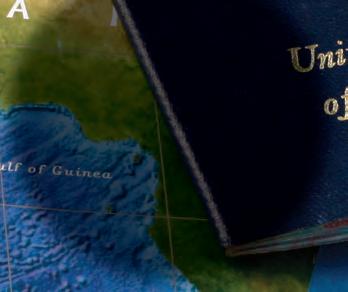
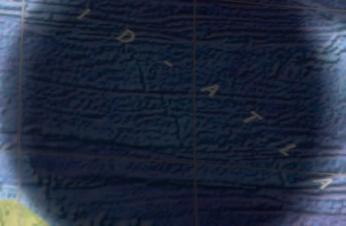
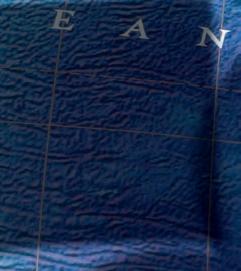

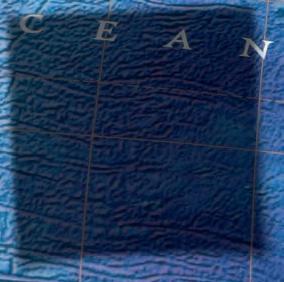


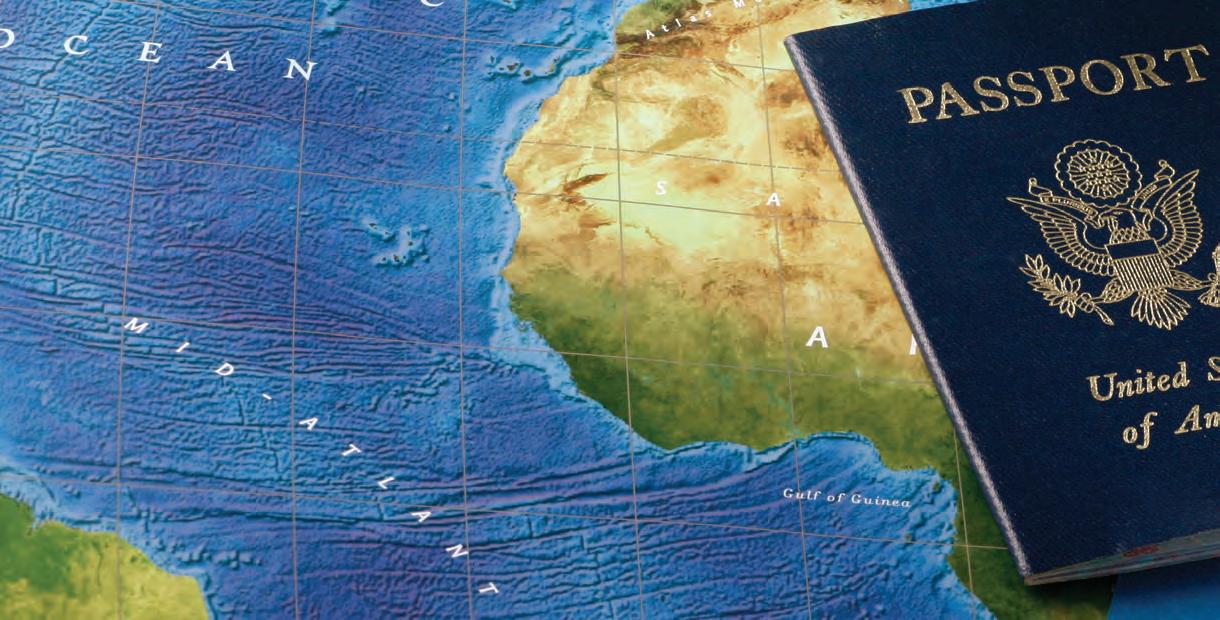




Travel the globe, without leaving home—with this set of the world’s ve most popular pure silver coins. Newly struck for 2023 in one ounce of ne silver, each coin will arrive in Brilliant Uncirculated (BU) condition. Your excursion includes stops in the United States, Canada, South Africa, China and Great Britain.
Each of these coins is recognized for its breathtaking beauty, and for its stability even in unstable times, since each coin is backed by its government for weight, purity and legal-tender value.

2023 American Silver Eagle: The Silver Eagle is the most popular coin in the world, with its iconic Adolph Weinman Walking Liberty obverse backed by Emily Damstra's Eagle Landing reverse. Struck in 99.9% fine silver at the U.S. Mint.





2023 Canada Maple Leaf: A highly sought-after bullion coin since 1988, this 2023 issue includes the FIRST and likely only use of a transitional portrait, of the late Queen Elizabeth II. These are also expected to be the LAST Maple Leafs to bear Her Majesty's effigy. Struck in high-purity




99.99% fine silver at the Royal Canadian Mint.
2023 South African Krugerrand: The Krugerrand continues to be the best-known, most respected numismatic coin brand in the world. 2023 is the Silver Krugerrand's 6th year of issue. Struck in 99.9% fine silver at the South African Mint.




2023 China Silver Panda: 2023 is the 40th anniversary of the first silver Panda coin, issued in 1983. China Pandas are noted for their heart-warming one-year-only designs. Struck in 99.9% fine silver at the China Mint.

2023 British Silver Britannia: One of the Royal Mint's flagship coins, this 2023 issue is the FIRST in the Silver Britannia series to carry the portrait of King Charles III, following the passing of Queen Elizabeth II. Struck in 99.9% fine silver.





These coins, with stunningly gorgeous finishes and detailed designs that speak to their country of origin, are sure to hold a treasured place in your collection. Plus, they provide you with a unique way to stock up on precious silver. Here’s a legacy you and your family will cherish. Act now!
You’ll save both time and money on this world coin set with FREE shipping and a BONUS presentation case, plus a new and informative Silver Passport!
BONUS Case!
2023 World Silver 5-Coin Set Regular Price $229 – $199 SAVE $30.00 (over 13%) + FREE SHIPPING




FREE SHIPPING: Standard domestic shipping. Not valid on previous purchases. For fastest service call today toll-free

1-888-201-7070


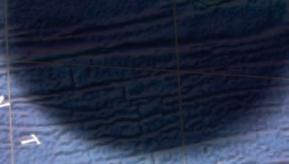


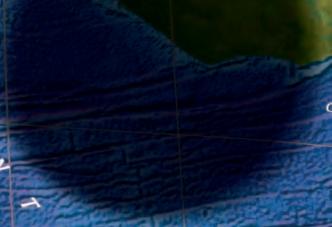







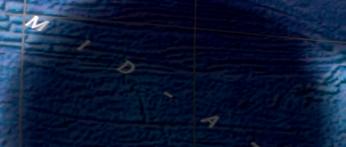









Offer Code WRD287-05









Please mention this code when you call.




SPECIAL CALL-IN ONLY OFFER
Not sold yet? To learn more, place your phone camera here >>> or visit govmint.com/WRD
GovMint.com® is a retail distributor of coin and currency issues and is not a liated with the U.S. government. e collectible coin market is unregulated, highly speculative and involves risk. GovMint.com reserves the right to decline to consummate any sale, within its discretion, including due to pricing errors. Prices, facts, gures and populations deemed accurate as of the date of publication but may change signi cantly over time. All purchases are expressly conditioned upon your acceptance of GovMint.com’s Terms and Conditions (www.govmint.com/terms-conditions or call 1-800-721-0320); to decline, return your purchase pursuant to GovMint.com’s Return Policy. © 2023 GovMint.com. All rights reserved.
possible candidates for the man who killed Custer. While the lens of time will forever blur the specifics of Custer’s death, two facts remain clear— White Bull was a dynamic participant in the Battle of the Little Bighorn, and his demonstrated courage over 11 years on the warpath is well documented.
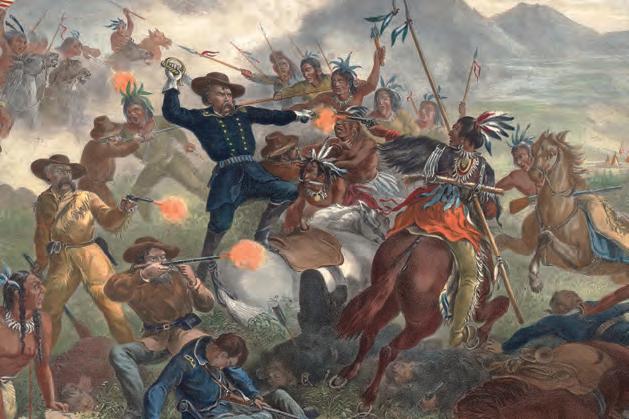
In 1932 Vestal visited the Cheyenne River Indian Reservation, in northcentral South Dakota, to interview 83-year-old White Bull, who poured out his life story to the prolific journalist and biographer. According to his own account, the future warrior chief entered the world in April 1849 in the Black Hills of what a dozen years later would be designated Dakota Territory. Known as Bull-Standing-With-Cow until the summer of his 16th year, he was born into a lineage of strong Sioux warriors. His father, Makes Room—like his father before him—was a chief of the Minneconjou, and his mother, Good Feather Woman of the Hunkpapa, the favorite sister of the legendary Sitting Bull.
The games of Bull-Standing-With-Cow’s youth often centered on simulated combat. He and his friends formed their own warrior societies and learned the intricacies of warfare by play fighting. To count coup on one’s enemy by striking him with a hand or a stick was considered especially courageous.
Up to four warriors were permitted to count coup on a single foe in the same fight—the most honored being the one who counted first coup. Such feats were recorded in the language of feathers. The man striking first coup could wear a single eagle feather lodged upright in his hair at the back of his head. A second coup was identified by a feather angling upward, a third by a horizontal feather and a fourth by one sloping downward. In their war games Bull-Standing-With-Cow and friends would count coup on each other and keep score by sticking small feathers in their hair.
As childhood gave way to adolescence, Bull-Standing-With-Cow grew determined to make his reputation as a warrior. In July 1865 noted Minneconjou warrior High Hump recruited volunteers for a war party. White soldiers had violated a recent treaty, and High Hump resolved to seek enemy scalps and horses.
Sixteen year old Bull-Standing-With-Cow didn’t need to be asked twice, and Makes Room saw there was no stopping him. After presenting his son with a fast dapple-gray pony, the chief had half brother Horse Tail, a medicine man, create protective “medicine” for the boy and his horse. Horse Tail hung a leather pouch painted with a war eagle around the gray’s neck, then painted its legs and jawline with wavy red lines. After fastening a soft eagle plume
in Bull-Standing-With-Cow’s hair, he finally draped a leather thong suspending an eagle-bone whistle around the boy’s neck.
“Nephew,” he declared, “this medicine will make your horse strong and long-winded.”
Following an evening of singing and dancing, the warriors left camp early the next morning. One evening several days later a scout pinpointed an enemy camp. Anxious to be the first to the fight, Bull-Standing-With-Cow slipped away from camp early. When the sun broke over the horizon, he made a solo charge into the soldiers’ remuda. Cutting out eight horses, he blew his eagle-bone whistle to scare them into a run.
Unfortunately for him, the whistle also roused the enemy. Moments later the neophyte warrior found himself the target of a running pursuit by 10 mounted bluecoats. Lashing his pony’s flanks while bullets whizzed past, he likely prayed his uncle’s medicine would indeed make his horse “strong and long-winded.” Just when his pony began to tire and the soldiers were about to catch up with him, he encountered his own war party. His pursuers abruptly retreated.
Bull-Standing-With-Cow’s daredevil spirit and eight captured horses made quite an impression on his friends. Meanwhile, the dissatisfied High Hump organized another raid. Near the headwaters of the Powder River the party encountered seven bluecoat scouts driving horses. Bull-StandingWith-Cow was riding down on one of the scouts with his lance when the soldier whirled in his saddle and fired a revolver at nearly point-black range. Miraculously, the bullet missed. Moments later Bull-Standing-With-Cow stabbed the bluecoat in the shoulder, counting first coup. By the time the party turned for home he’d counted three coups and stolen 10 horses.
When Bull-Standing-With-Cow returned to camp, his father arranged a victory dance for his son. Astride his horse, resplendent in warpaint, the boy warrior rode toward a black pole in the center of the ceremony grounds. “From this day,” proclaimed his Uncle Black Moon, “Bull-StandingWith-Cow will lay down his boy name. From this time, he shall be called by the name of his grandfather, White Bull.”
In the coming years White Bull racked up an impressive string of coups, finally realizing the future he’d envisioned when he and young friends ran about play fighting and sticking small feathers in their hair. As a member of both the Minneconjou and Hunkpapa bands of the Lakota Nation, he fought in nearly every battle waged by either band—and who knows, he just may have counted coup on Custer.
ago, Persians, Tibetans and Mayans considered turquoise a gemstone of the heavens, believing the striking blue stones were sacred pieces of sky. Today, the rarest and most valuable turquoise is found in the American Southwest–– but the future of the blue beauty is unclear.
On a recent trip to Tucson, we spoke with fourth generation turquoise traders who explained that less than five percent of turquoise mined worldwide can be set into jewelry and only about twenty mines in the Southwest supply gem-quality turquoise. Once a thriving industry, many Southwest mines have run dry and are now closed.
We found a limited supply of turquoise from Arizona and purchased it for our Sedona Turquoise Collection . Inspired by the work of those ancient craftsmen and designed to showcase the exceptional blue stone, each stabilized vibrant cabochon features a unique, one-of-a-kind matrix surrounded in Bali metalwork. You could drop over $1,200 on a turquoise pendant, or you could secure 26 carats of genuine Arizona turquoise for just $99

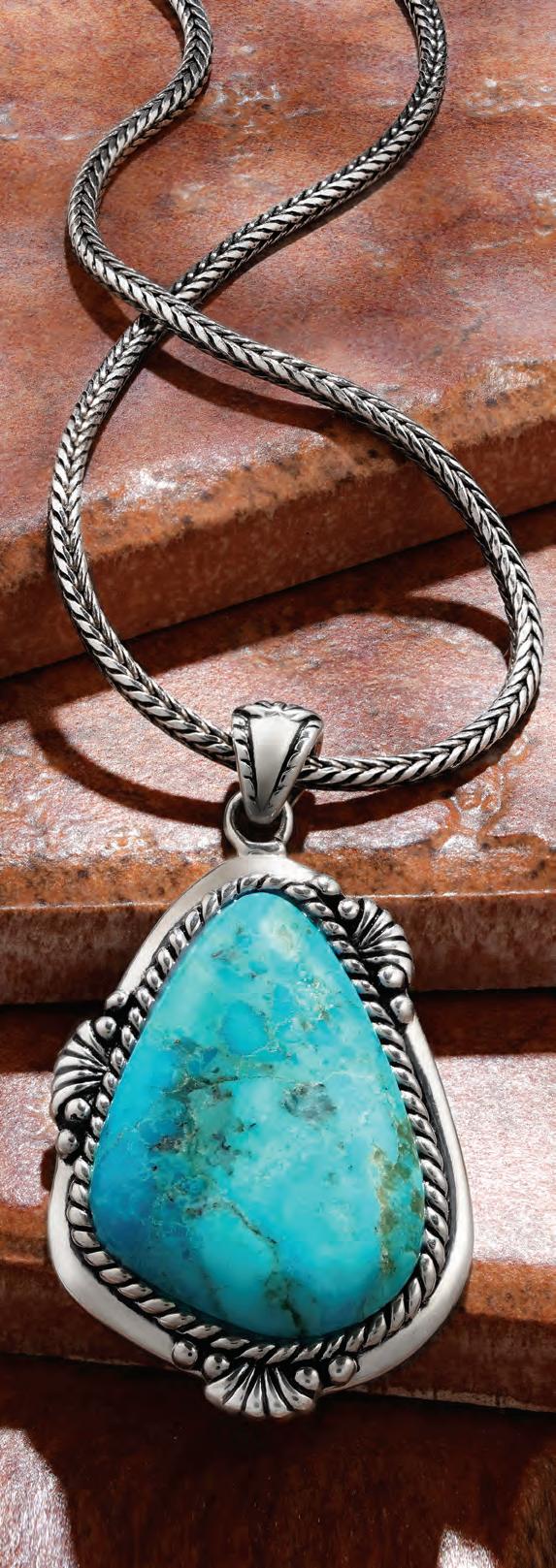
Your satisfaction is 100% guaranteed. If you aren’t completely happy with your purchase, send it back within 30 days for a complete refund of the item price.
The supply of Arizona turquoise is limited, don’t miss your chance to own the Southwest’s brilliant blue treasure. Call today!
Jewelry Specifications:
•Arizona turquoise • Silver-finished settings
Sedona Turquoise Collection
A. Pendant (26 cts) $299 * $99 +s&p Save $200
B. 18" Bali Naga woven sterling silver chain $149 +s&p
C. 1 1/2" Earrings (10 ctw) $299 * $99 +s&p Save $200
Complete Set** $747 * $249 +s&p Save $498
**Complete set includes pendant, chain and earrings.
Call now and mention the offer code to receive your collection.
1-800-333-2045
Offer Code STC789-09
You must use the offer code to get our special price.
*Special price only for customers using the offer code versus the price on Stauer.com without your offer code.
26 carats of genuine Arizona turquoise ONLY $99
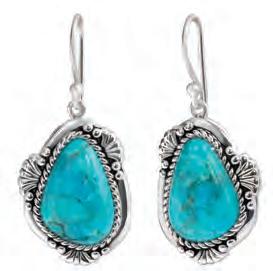 A.
B.
A.
B.
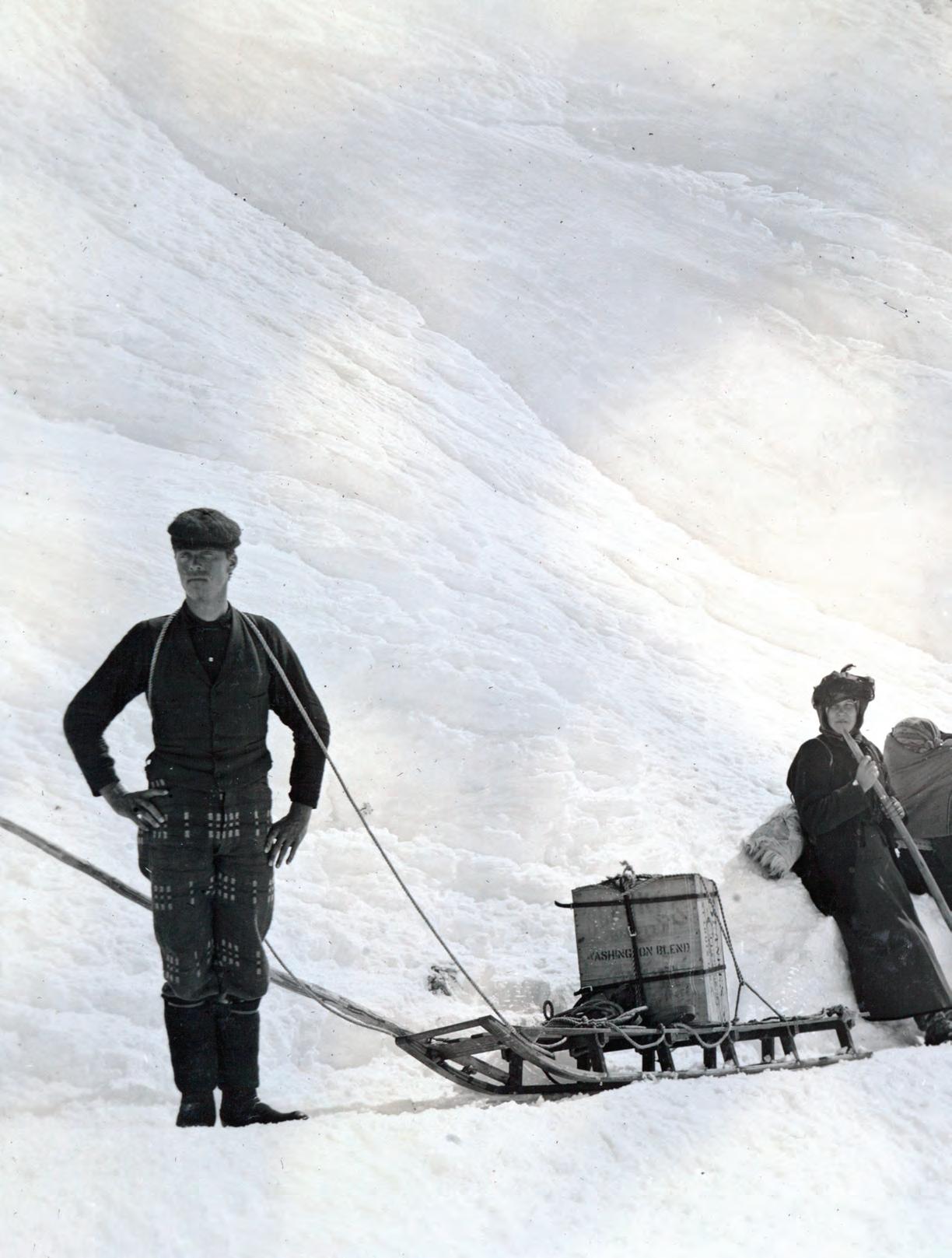
AN
BY MIKE COPPOCKThe High Road to Riches...or Heartbreak Klondike hopefuls clog the route to 3,525-foot Chilkoot Pass in 1898, at the height of the gold rush. The average miner would make more than 30 round trips to ferry his supplies the 33 miles from Dyea, on the southeast Alaskan coast, up to Lake Bennett, in British Columbia, Canada. This was but the first step in the long, hazardous land-and-water route north to the goldfields.
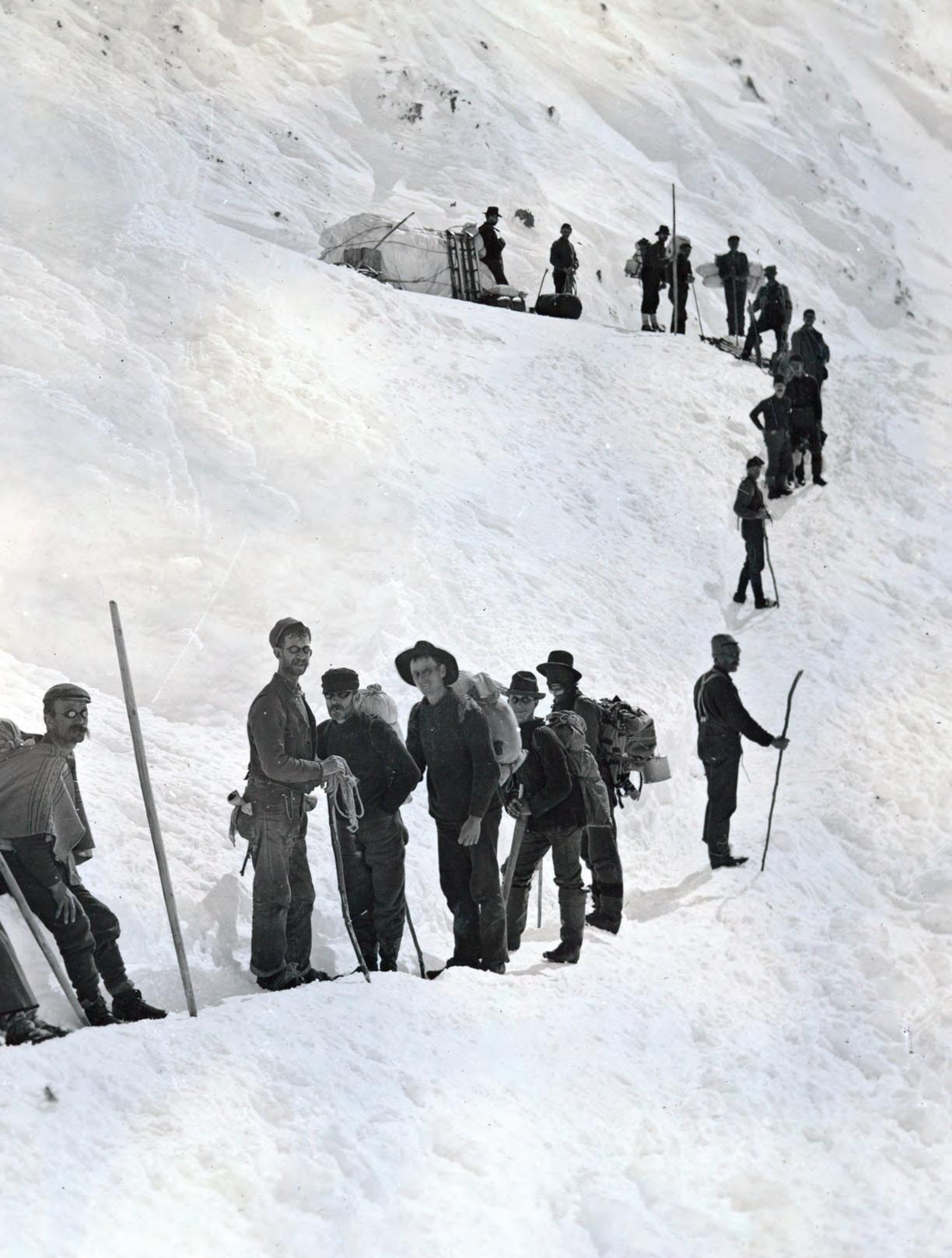
George Carmack strutted into Bill McPhee’s smoke-filled saloon in the settlement of Forty Mile, Canada, at the confluence of the Fortymile and Yukon rivers. Days earlier, on Aug. 16, 1896, Carmack and his Tagish brother-in-law, Keish (aka “Skookum Jim” Mason), and nephew Káa Goox (aka “Dawson Charlie”) had found gold far to the east on Rabbit Creek, a tributary of the Klondike River. Carmack ordered a round of drinks for the house, shouting, “There’s been a big strike upriver!” Few of the bar patrons paid much mind. After all, it was “Lying George” doing the talking. But the gold nuggets the excited prospector slapped down to pay for the drinks did catch their attention.
These “Sourdoughs,” so named for the fermented dough they used to make everything from bread to flapjacks, were a unique breed. They drifted north by ones and twos when most Americans were heading west to the Pacific. They liked to claim they were prospectors, but only a few actually found gold.
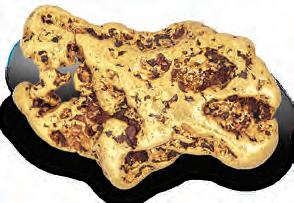
They were also extremely eccentric. Four partners kept a moose in their cabin as a pet. Others, like Frank Buteau, rigged up sails to propel their sleds —in Buteau’s case because he couldn’t afford dogs. Another hardy, albeit penniless, soul was rumored to have fashioned dental plates for his fronts from tin spoons and teeth pulled from the skulls of a mountain sheep, a wolf and a bear he’d shot. With typical Sourdough gusto he then stewed and ate the bear with its own teeth.
These adventurers barely peppered the vast region. The 1890 federal census recorded only 31,795 residents (including 4,303 whites and 23,274 Native Alaskans) in the adjacent 663,000-square-mile District of Alaska, whose governor was appointed by the president of the United States. Little more than 2,000 souls dwelled along the banks of the 1,980-mile-long Yukon River itself, which flows westward through Canada’s Yukon Territory and Alaska to the Bering Sea.
As soon as Carmack left the bar, or perhaps before, bystanders inquired at the recorder’s office about the location of Carmack’s claim. Time was ripe for a major strike; the value of gold shipments from the Yukon had increased from $30,000 in 1887 to $800,000 in 1896. Within days some 1,500 Sourdoughs descended on the Klondike River, just upstream from where it empties into the Yukon. Taking its name from the river, the gold-bearing region of central Yukon Territory became known as the Klondike. Through the bitter winter months of 1896–97 each prospector worked his solitary claim, having scant communication with the outside world.
With the spring ice breakup hundreds of miners rafted down the Yukon to the sea. Many hadn’t emerged from the interior for decades. Nearly all had been destitute the previous spring. At the former Russian trading port of St. Michael, Alaska, they boarded the southbound coastal steamers Portland and Excelsior. On July 14, 1897, Excelsior docked in San Francisco, unloading more than a dozen free-spending Sourdoughs who ignited rumors of quick wealth. Two days later 5,000 people crowded Seattle’s waterfront to greet Portland The Seattle Post Intelligencer published an extra edition with reporter Beriah Brown’s news the ship had brought “more than a ton of gold” from the Klondike.
The Klondike Gold Rush was on.
Gold fever swept Seattle. Thousands of hopefuls jammed the streets to elbow and snarl their way to the docks. Store clerks quit by the hundreds. Streetcar service ground to a halt as operators resigned on the spot. Hotels booked up and restaurants were packed to bursting as people flooded to town. There was also an epidemic of stolen dogs, presumably smuggled north for use pulling sleds. Meanwhile, a ragtag fleet composed of anything that would float hastily assembled for a return voyage to the ports of entry in Alaska.
Seattle Mayor W.D. Wood was attending a conference in San Francisco when he read about Portland ’s cargo. He promptly telegraphed in his resignation as mayor, raised $150,000 and bought a steamer to take him and paying passengers to St. Michael. John McGraw, president of Seattle’s First National Bank and the state’s former governor, booked passage on Portland for its return voyage. One man dying of lung disease boarded Portland, insisting to distressed relatives he would rather die trying to get rich than rot on his deathbed in poverty.
Within months of the news more than 40 ships out of San Francisco alone were making regular passages to and from Alaska—no matter that many had been condemned and were waiting to be broken up in local shipyards. More than 100,000 people would ultimately set out for the Klondike.
The gold rush drew such Old West refugees as lawman Wyatt Earp (see Gunfighters & Lawmen, P. 20), Tex Rickard and Frank Canton; madam Mattie Silks; frontier scouts Jack Crawford (“Poet Scout” of the West) and Luther “Yellowstone” Kelly; and Indian fighter “Arizona Charlie” Meadows. They mingled with thousands of inexperienced men and women willing to stake everything on a shot
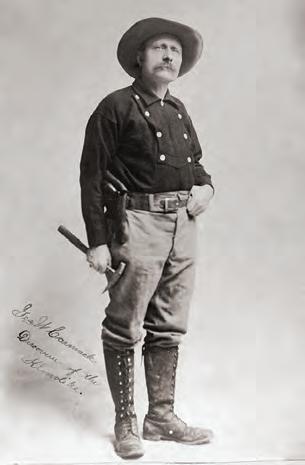

at striking it rich as the United States emerged from a horrific economic depression. People who had never lived off the land—schoolteachers, bank tellers, unemployed seamen, basketball coaches and single mothers with children to feed—all headed north. In 1887 steamship captain Billy Moore—who, guided by Skookum Jim, had pioneered the White Pass trail into the Canadian interior—claimed a 160-acre homestead at the mouth of the Skagway River. But the crush of follow-on prospectors ignored his claim. When surveyors of the city of Skagway later platted a street straight through the middle of Moore’s house, the grizzled old captain emerged swinging a crowbar only to be subdued by a mob.
Arriving in Skagway that summer, a young Jack London found streets of muddy ruts lined with tents, huts and hastily constructed wood-frame structures. Laughter, screams and sporadic gunfire filled the air. Murders were almost a nightly occurrence, and prostitutes conducted business in full public view. Famed Yukon Territory officer Sam Steele of Canada’s North-West Mounted Police deemed Skagway “little better than a hell on earth.”
London was just 21 when he arrived in Skagway. Hollywood has long portrayed him as an innocent, but that wasn’t true. Young London, whose birth father had deserted his pregnant mother, went to work delivering papers, sweeping saloons, setting
By Steamer, Dogsled, Raft andThose arriving in southeast Alaska had little concept of what lay ahead. Trails from Dyea or Skagway (circled at bottom) climbed up to Lake Bennett. From there hopefuls floated themselves and supplies on homemade rafts and boats some 500 miles down the Yukon River to its confluence with the Klondike at Dawson (at top). Then the real work began.
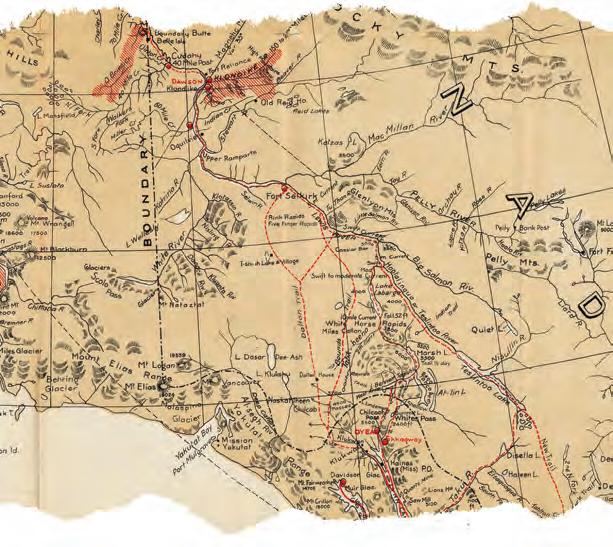
Foot
Curious thousands cram the San Francisco wharf as the coastal steamer Excelsior readies for its return trip to Alaska on July 28, 1897. That spring, after overwintering on the Klondike, prospectors had returned stateside with news of the gold strike.
up pins at bowling alleys and working in a cannery all by the age of 13. After trying his hand at pirating commercial oyster beds, he hired out to the Californian Fish Patrol to hunt down the very oyster pirates with whom he’d worked.
At age 17 he shipped for Japan, en route encountering a dynamic mariner and sealer who became the model for his 1904 novel The Sea-Wolf . On his return stateside he marched across the country with other socialist activists to Washington, D.C. In Buffalo, N.Y., he was arrested for vagrancy and served 30 days in jail.
By the time of the Klondike Gold Rush he was starving in his chosen profession as a writer. When he mentioned the strike to his 54-year-old brother-in-law, James Shepard, the latter offered to grubstake the 21-yearold if Shepard could join him. London agreed. On July 25, 1897, the unlikely pair sailed from San Francisco aboard the steamship Umatilla . Aboard they fell in with carpenter Merritt Sloper, placer miner Jim Goodman and Fred Thompson, who kept a journal of their adventures. On August 2 the five disembarked at Juneau and canoed to Skagway from there.

By then Skagway was under the thumb of a ruthless gang controlled by one Jefferson Randolph “Soapy” Smith—a con man, or “sure thing man” in Western parlance. Having ventured to Alaska from Denver, he and his cohorts had first moved in on Wrangell, a backdoor port to the Klondike a few hundred miles down the coast. Moving north, Soapy had considered taking over Dyea, just upriver from Skagway, but former lawman turned trader John J. Healy had proved too powerful an opponent, so Smith and his men settled on Skagway. Soapy’s saloons sold watered down whiskey to northbound prospectors, while his henchmen ran a protection racket on competing saloons.


En route to Alaska aboard the steamship Utopia the gang had helped the ailing Captain “Dynamite Johnny” O’Brien (see sidebar, opposite) put down a mutiny. Johnny returned the favor by allowing Soapy and his men to travel free on O’Brien’s growing fleet of ships. While aboard Soapy’s men would target a mark worth plucking and then pounce amid the crowded frenzy when the ship disembarked in Skagway. O’Brien had a massive fleet, all Skagway bound. Most Klondike prospectors came north on one of his ships, and each had Soapy men on its manifest.
Soapy ran a dockside information booth that sold newcomers maps of the White Pass, the best campsites helpfully marked with X’s. What they didn’t know is that Soapy’s men were waiting at those X’s to rob and even murder them. Perhaps Smith’s “best” con was his Dominion Telegraph Service—not that Alaska had telegraph service. Dominion’s line comprised a section of wire strung from town and nailed to a tree in the deep woods. Newcomers who didn’t know any better would rush into the telegraph office and, for a fee, “wire home” with news of their arrival. Some hours later a convincing runner would locate the customer
and hand him a reply—almost always a plea to immediately wire home money. Presented with such a desperate request, the mark would continue to open his wallet until someone set him straight.

On the Taiya River some 5 miles north of Skagway, Dyea sits at the foot of near vertical 3,759-foot Chilkoot Pass. Some 40,000 would-be millionaires confronted the pass in the first year of the gold rush, Dyea’s population swelling from 1,000 to 8,000 by the spring of 1898.
Presented with a choice of fending off the Smith gang in Skagway or trying their luck in the pass, London and his friends chose to trek to Dyea and scale the Chilkoot into the Klondike. Soon after setting out, they met with a horrifying scene. The landscape was littered with dead and dying horses, as few of the 3,000 horses urged up the arduous trail that autumn survived. Inexperienced owners beat the animals, many of which dropped from exhaustion, slipped in the mire and fell to their deaths. Others succumbed to wounds rent by jagged rocks.
“The horses died like mosquitoes in the first frost,” London wrote, “and from Skagway to [Lake] Bennett they rotted in heaps.”
On reaching the top of the pass, the party encountered Mounties who demanded each prospector have 1,000 pounds of supplies before proceeding into the Yukon. It took London and his friends 20 days to porter sufficient supplies over the summit, an effort that broke the health of his brother-in-law, who returned to San Francisco. At one point while hefting his goods upslope, London spotted a pair of boots sticking out of a snowbank. He tried picking them up only to find them still attached to the feet of a man who’d been buried in an avalanche minutes earlier. London and others pulled the very much alive and grateful man free.
Trails from both passes ended at Lake Bennett, which spans the border of British Columbia and Yukon territories. A vast tent city rose on its shoreline as 30,000 hopeful prospectors waited for the frozen lake to thaw so they could raft the 500 or so miles downstream to Dawson and the Klondike. On May 29 the ice broke, and by day’s end 800 assorted boats and rafts had set off. Within 48 hours 7,124 had set sail. All had to shoot a series of rapids patrolled by the Mounties, who were on hand to recover the dead.
Irish American ship’s captain John O’Brien was as legendary a seaman as James Butler “Wild Bill” Hickok and Wyatt Earp were Old West lawmen. Over the course of his career “Dynamite Johnny” fought off Chinese pirates, dined with the Hawaiian royal family, made love to a Tahitian princess, escaped from cannibals preparing him for lunch and sailed with the vicious Robert O’Malley, another character who inspired Jack London’s sea tales. Fellow Irishman and ship’s captain David “King Cappy” O’Keefe, who himself once ruled an island in the Western Pacific, was so taken with Johnny, he offered to make him a business partner.
Dynamite Johnny earned his nickname after having sailed 60 tons of dynamite into a Panamanian port during a violent electrical storm while lying to his crew about the cargo. He was smuggling guns and supplies to Cuban rebels, keeping just ahead of blockading Spanish gunboats, when he decided to try his luck in Alaska.
There, in a shack on Alaska’s Cook Inlet, he required an operation to remove a tumor in his skull. The alcoholic doctor used only a knife and a pair of scissors. Infection had set in by the time O’Brien returned to Seattle. Adding insult to injury, his financial backers and crew deserted him. Some time later he was lying incapacitated with fever aboard his steamship— the ironically named Utopia—when he looked up to find Soapy Smith leaning over his bunk, asking about passage to Alaska for himself and his men. Appraising his prospective passengers, O’Brien demanded cash up front, and Soapy agreed.
Hours from port O’Brien’s crew, believing the ship unseaworthy, mutinied. Moments later they were staring down the barrel of Dynamite Johnny’s pistol. Beside him, also armed, stood Soapy.
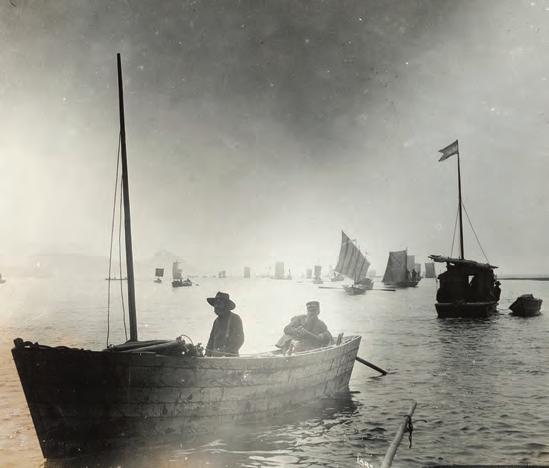
“I want steam up in this old tub,” growled O’Brien. “If you refuse, in less than five seconds you’ll be in Hell.” His men went back to work, and from then on O’Brien felt indebted to Smith.
On March 16, 1912, 75-year-old Captain O’Brien had the honor of manning the raised battleship USS Maine, under tow from Havana Harbor into the Strait of Florida, then lowering the Stars and Stripes and scuttling her. Five years later Dynamite Johnny died in Manhattan. His obituary appeared in The New York Times, and citizens threw him a mighty wake. —M.C.
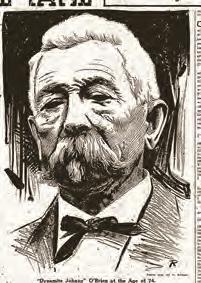
In the end, it depended on one’s perspective. Scarcely a third of the 100,000 hopefuls who set out for the Klondike reached it. Among those only a few thousand found gold. Still, a lucky few came home richer than lords, while scores of merchants, saloonmen, hoteliers and restaurateurs also made out, as did the showgirls and “painted ladies.”
London and party tempted fate on the rapids. He and his party shot through Miles Canyon Rapids without any problems, though their boat rocketed downstream within 6 feet of the canyon’s granite walls. After helping a couple get through, they took on Whitehorse Rapids. Amid that stretch a whirlpool captured their craft in its spin, nearly throwing everyone overboard. London lost all rudder control. Only by chance did the whirlpool just as suddenly pop their boat free.
During the first winter of the gold rush starvation had almost wiped out Dawson. Too many people had arrived without sufficient food—hence the Mounties’ stiffened requirements. Saloonman
McPhee of Forty Mile fame turned his Dawson saloon into an after-hours shelter for the homeless, whom he fed. The population reached 500 by year’s end 1896. Six months later it had grown to 5,000. By year’s end 1897 it boasted a population approaching 20,000, its residents almost all hailing from the United States.
Rumor had it Dawson again lacked sufficient food stores for the coming winter. That prompted London and party on October 8 to pull ashore on Split-Up Island, at the mouth of the Stewart River some 75 river miles short of
their destination, so as not to be around whatever was about to befall Dawson. They would overwinter in one of the many abandoned cabins. It was there London’s observations inspired his short story “To Build a Fire.”
After a 47-day visit to Dawson, marked by much drinking and camaraderie, London and friends returned to their isolated cabin, and soon winter temperatures plunged to minus 40. For months their daily routine consisted of collecting ice, chopping firewood and shoveling snow, as well as preparing the three B’s—beans, bread and bacon— that sustained most overwintering prospectors. By spring London’s gums were swollen and bleeding. He had scurvy and still no gold.
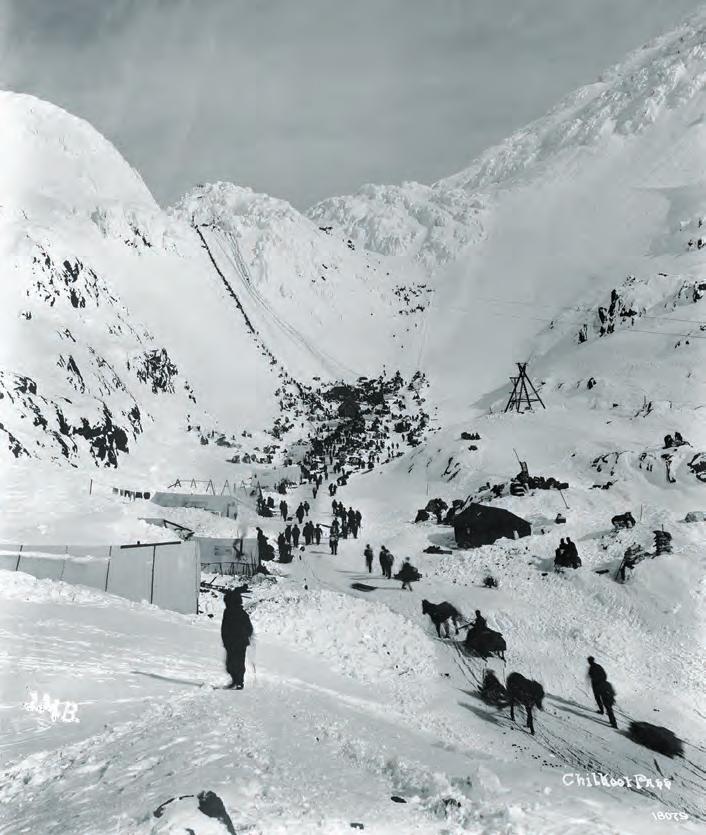
Of the 100,000 hopefuls that set out, roughly 35,000 reached the Klondike. Among those only a few thousand found any gold, and only a couple hundred of those in quantities enough to truly be considered “rich.” Whether they were wideeyed young adventurers like London, weathered lawmen, teachers, bank tellers or prostitutes, Dawson’s varied residents shared a certain kinship as they slogged its muddy streets past saloons, warehouses, whorehouses and churches. For better or worse, they had stuck it out, while the majority had turned back.
Some of the prospectors did quite well. “Swiftwater Bill” Gates’ claim was literally knee deep in gold. He spent his Klondike fortune but found another in Nome after having returned to Alaska with one especially irate mother-in-law in hot pursuit. In one two-hour span Jim Tweed found $4,284 in nuggets on his claim, while Frank Dinsmore took $24,489 in gold in a single day. Albert Lancaster averaged $2,000 a day over eight weeks. Brooklynite Gus Mack found enough gold to start Mack Trucks with his brothers, and with a fortune earned by entertaining Klondike miners Sid Grauman opened his namesake Chinese Theater in Los Angeles.
Others followed more traditional paths. Lying George Carmack invested in Seattle real estate and died a wealthy man. So did Clarence “C.J.” Berry, who returned from Alaska with $1.5 million in gold. Outside his cabin in the Yukon he’d placed a coffee can containing rough nuggets, a whiskey bottle and a sign reading, Help Yourself. Prospector turned philanthropist Tom Lippy donated land to expand Seattle General Hospital. Lawman turned saloonman Tex Rickard left Alaska to build the third iteration of New York City’s Madison Square Garden, while playwright and con man Wilson Mizner opened the Brown Derby restaurant in Los Angeles.
Dawson prostitutes Silks and “Diamond Tooth Lil” Davenport made a fortune mining the miners,
By the time London set foot back in San Francisco, he had only $4.50 in gold in his pockets
while “Klondike Kate” Rockwell (see P. 18), “Diamond Tooth” Gertie Lovejoy and other dance hall girls also cleaned up. Two won notoriety for quite literally selling themselves. Grace Drummond sold herself to Charley “Lucky Swede” Anderson for $50,000, and Bill Gates bought Gussie Lamore for $30,000, her wedding present determined by her literal weight in gold.
Others’ fortunes slipped through their hands. Through no fault of his own Anderson lost his when the 1906 San Francisco earthquake and fire destroyed his real estate holdings. He died in 1939 pushing a wheelbarrow at a sawmill for $3.25 a day.
Anton Stander built Seattle’s Stander Hotel before liquidating the rest of his fortune in alcohol. Pat Galvin spent his fortune investing in riverboats and was battered into bankruptcy by the rough Yukon.
London made it out of the Yukon in 1898 by sailing downriver to the Bering. By the time he set foot back in San Francisco, he had only $4.50 in gold in his pockets but a wealth of stories to write.
By then homebound prospectors—fed up with being scammed, robbed and worse by the Smith gang when they returned south through Skagway —were largely leaving the Klondike westbound
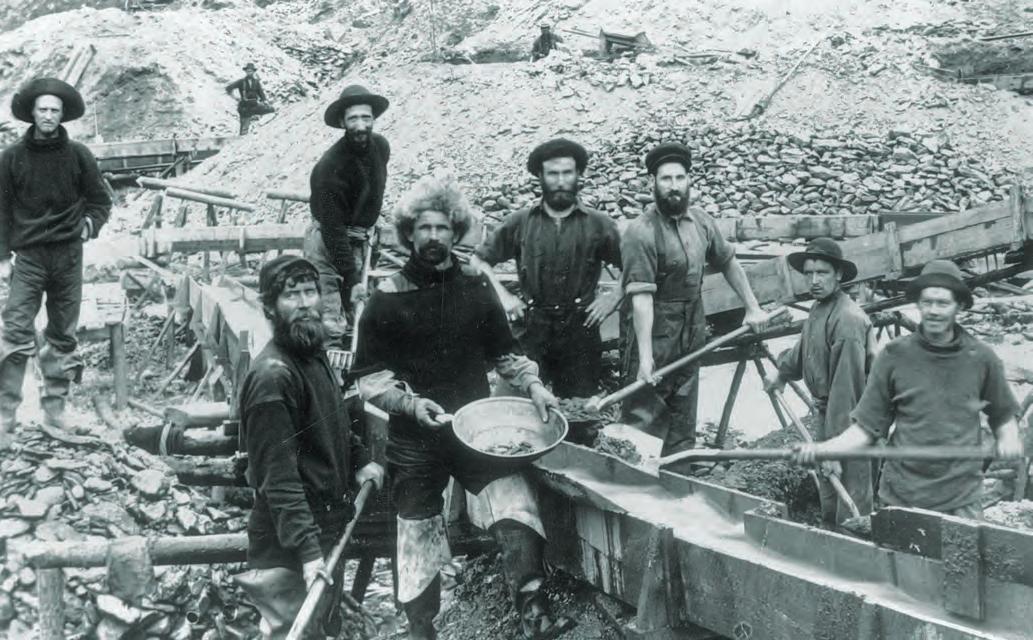
via the Yukon River. On the evening of July 8 the town’s equally fed up vigilance committee met on the wharf to discuss what to do about Soapy. When Smith came to break up the meeting, he engaged in a shootout with a man guarding the dock. Both were killed.
On the night of April 26, 1899, fire broke out in the room of a Dawson dance hall girl, and the city was soon ablaze. Some 117 buildings, from the most ornate hotels to riverside shacks, were reduced to ashes. Most of the Klondike goldfields had been claimed by then.

When word came later that spring that the very landing beaches of Nome held gold, 8,000 residents abandoned Dawson for the new strike.
The Klondike Gold Rush was over.
Oklahoma-based Mike Coppock is a frequent contributor to Wild West. For further reading he recommends Coming Into the Country, by John McPhee, and Alaska: Saga of a Bold Land, by Walter R. Borneman.
Andy Thomas’ depiction of the April 7, 1869, fire in the Yellow Jacket mine in Gold Hill, Nev., captures the terror miners must have felt when trapped hundreds of feet belowground. At least 35 men succumbed to the flames and fumes, making it one of the nation’s worst mine disasters.
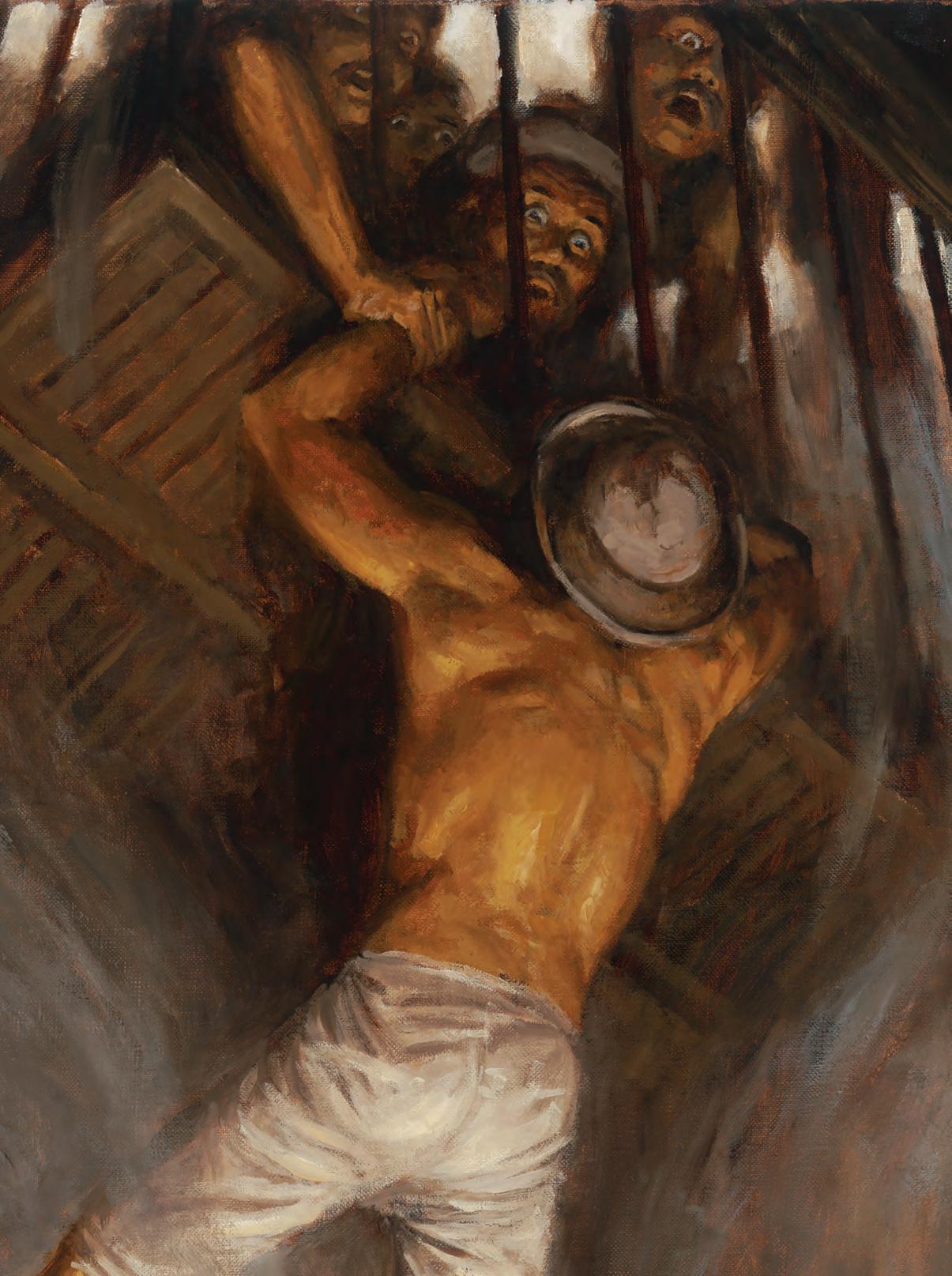
On April 5, 1869, Timothy Griffin woke from a disturbing dream. In it a presence conveyed to him that if he entered the Yellow Jacket mine once more, a terrible fate would befall him. Griffin treated the vision seriously, for he well knew that though the Yellow Jacket yielded ample silver, it exacted a toll in blood. After all, the previous July his cousin James from Cork, Ireland, and two fellow miners had been ascending the south shaft when the cage caught on a stray timber, snapping the hoist rope. Plummeting 260 feet, the cage struck the bottom of the shaft, instantly killing all three.
Unsettled, Griffin checked out of Gold Hill’s Vesey House the next morning, quit work and that night began the 240-mile journey west from Nevada to San Francisco. He left just in time. Early the next morning the Yellow Jacket was ground zero for the deadliest mine disaster in the history of the Silver State.
At 4 a.m. on the morning of April 7 the night crews of the Yellow Jacket, Kentuck and Crown Point mines—collectively known as the Gold Hill shafts—rose to the surface.
Although competitors, the men were well acquainted, for all three mines intersected. Partly this was to increase ventilation, for in the depths of the Comstock Lode, whose shafts descended more than 1,000 feet, temperatures could exceed 110 Fahrenheit. At other points the mines connected where crews—sometimes accidentally, often deliberately—had dug through into a rival shaft. With more wealth in silver concentrated in the mile-anda-half stretch between Gold Hill and Virginia City than in all the gold discovered in California, playing dirty became second nature.
Of the managers of the three mines, those of the Yellow Jacket were the most aggressive. Its principal owner was William Sharon, one of the most notorious robber barons of the Gilded Age. In April 1864 the men of the Yellow Jacket waged a subterranean war with those of the neighboring Gentry. It began
when Yellow Jacket miners cut a drift into the Gentry, set a garbage fire and smoked out the Gentry crews. The Gentry men responded by sealing off their shaft above the opening, which sent the smoke and foul vapors through the drift into the Yellow Jacket, driving their foes from the mine. The smudge war kept up for days, nearly asphyxiating one incautious Gentry miner, while the wind carried the stench to neighboring houses.
Five years later the Yellow Jacket would learn the consequences of playing with fire.
Although no one knew exactly how the fire started, the prevailing theory was that a Yellow Jacket miner on the night crew negligently left a candle burning 800 feet below the surface, igniting the pine timbers between the Yellow Jacket and Kentuck. A few cried arson, a theory that would garner political consequences years later. Whatever the case, the fire smoldered for hours, generating billows of black smoke and a reserve of suffocating carbon monoxide that lingered in the depths of the mine.
At 7 a.m. 25 miners—most working the Crown Point, a handful the Kentuck—stepped onto the Crown Point cage. Descending rapidly, the men clung to the crossbar, knowing that any appendage carelessly extended between the cage and the timbered shaft risked amputation. A pair of miners were deposited at the 230-foot level, and several more at the 600-foot, 800-foot and 900-foot levels. Several Kentuck men unloaded as well—including B.F. Rogers and Martin Clooney. It took about 30 seconds to hoist up the empty cage, whereupon another group of Crown Point and Kentuck men stepped forward. Simultaneously, 100 feet to the north several dozen men from the Yellow Jacket descended in their own cage.
Yellow Jacket miners on the upper levels blithely began lighting candles. Meanwhile, the fire—fed by the sudden influx of oxygen—roared to life. Unable to support the weight of the earth,
the weakened framework at the 900-foot level near the Kentuck boundary collapsed. The cave-in further fanned the flames and spawned a hellish gale of smoke and carbon monoxide that rushed outward with stupendous force.
John Murphy, who’d mined the Comstock Lode since its discovery in 1859 and served as stationman at the 800-foot level of the Yellow Jacket, had never felt anything like it. When the blast caught him, it snuffed out all 15 of his candles, leaving him choking in darkness. As chants of “Fire!” chorused throughout the mine, Murphy wrapped his rubber coat about his face. Even then, he was nearly insensible when pulled into a cage with Crown Point foreman George F. Kellogg and the Yellow Jacket’s underground foreman, Isaac S. Hubbell.

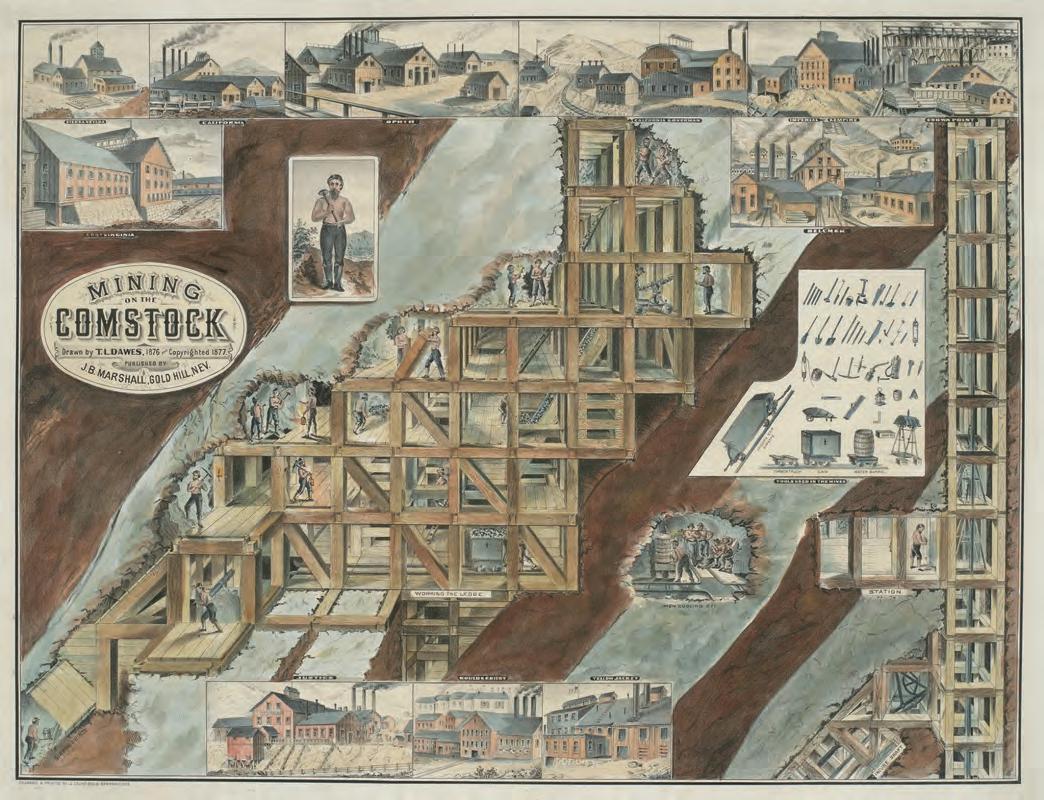
From 100 feet below him Murphy heard Jack Hogan weakly call out: “Murphy, where is all the smoke…? Send me a cage, I am suffocating to death.”
Instead, the desperate men aboard the cage signaled to be hoisted up. “These are the last words I heard from him,” Murphy later testified.
The blast hit the Kentuck equally hard. Rogers and Clooney were at the 800-foot level in that mine when the noxious gale engulfed them, dousing their candles. Blindly, the miners groped toward the Crown Point shaft. Rogers—who had cut his teeth as a Forty-Niner 20 years earlier—somehow made the shaft and ascended. Clooney fell behind, asphyxiated and died.
As dreadful as the events in the Yellow Jacket and Kentuck were, they played second fiddle to the nightmare unfolding in the Crown Point. The second cage had just passed the 700-foot level in its descent—having let off miners at various stations along the way—when the torrent hit. At the 800-foot level they came upon fellow miners gasping and choking in the smothering smoke.
The Bickle brothers—James, George and Richard, strong young men from Yorkshire, England—were among them. The Englishmen and the others rushed to the cage but to their horror realized they would not fit. As the bell was pulled and the cage rapidly hoisted up, the men waited in darkness.
Thirty seconds later the cage reached the surface in a cloud of smoke. Once the men were clear, the engineers sent the cage back to the 800-foot level. Leaving brother James behind, George and Richard Bickle and just four others managed to stumble into the cage before someone pulled the bell. By the time they surfaced, only George drew breath. Although unconscious, he had an iron grip on the body of older brother Richard, who had slumped down while riding the cage. Having leaned too close to the edge, Richard had his head taken off at the jawline, and his left arm hung by a shred.
By then the air was alive with steam whistles, summoning firemen from Gold Hill, who blasted a stream of water down the Yellow Jacket shaft. As panic ensued, all of Storey County seemed to turn out. Father Pat Manogue came from St. Mary’s of the Mountains. Newspaperman Alfred Doten of the Gold Hill Daily News skipped breakfast and made for the mines. The families of the miners rushed to their loved ones, including the former Ann Hall, recently married to Kentuck miner Anthony Toy. Soon fire engines No. 3, 4 and 6 arrived from Virginia City. At about 9:30 a.m. the Kentuck cleared of smoke. Tom Smith, who had charge of the ropes, and another man descended into its shaft. A half hour later they emerged with the bodies of two men found at the 700-foot station: 30-year-old Patrick E. Quinn and 25-year-old Toy. After only 20 days of marriage Ann Toy was a widow. She wasn’t alone in her grief. Doten described “so many women hurrying wildly…at the scene of the disaster, loudly weeping or eagerly inquiring after the safety of those near and dear to them.”
As the smoke from the Yellow Jacket abated, Kellogg led down a rescue party of miners and firemen. They returned with four corpses from the 900-foot level. As for the Crown Point, the smoke blew so powerfully that no one dared enter.
Around noon John P. Jones—the industrious former sheriff of California’s Trinity County and current superintendent of the Crown Point and Kentuck mines—had an empty cage sent down the shaft to which was affixed a lighted lantern, a box of candles and a sheet of pasteboard scrawled with the following:
We are fast subduing the fire. It is death to attempt to come up from where you are. We shall get you out soon. The gas in
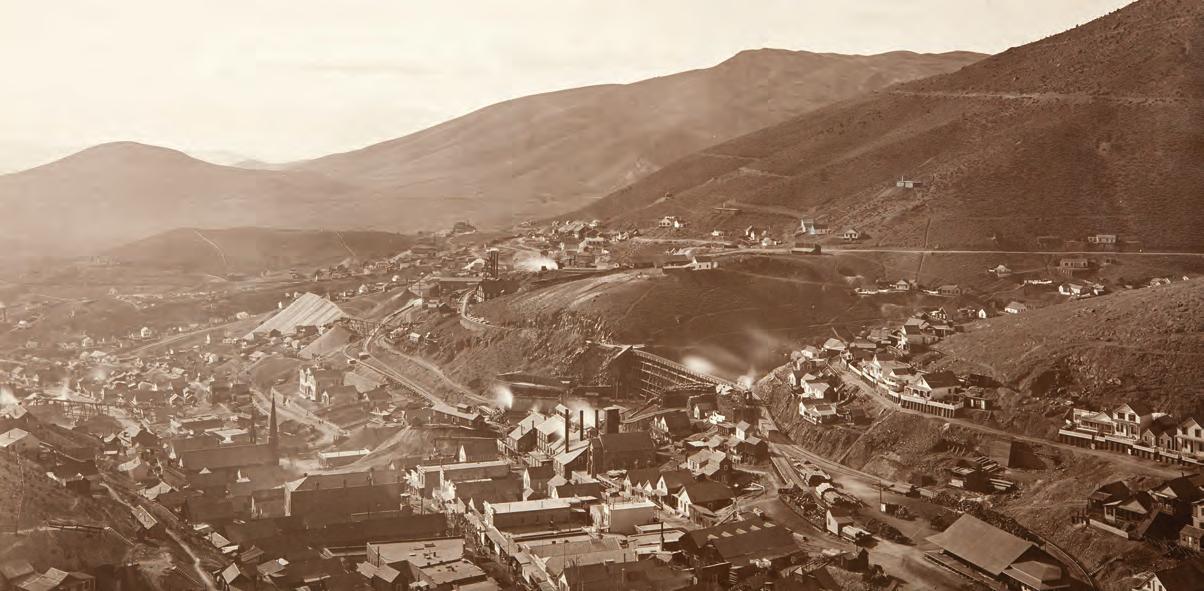
the shaft is terrible and produces sure and speedy death. Write a word to us and send it up on the cage, and let us know where you are.
The hoistman lowered the cage to the 1,000-foot level, where a number of miners were known to have been working. Tense minutes passed. When the cage returned to the surface, all could see the lantern had blown out and the candles were untouched, signaling the worst. At that point roll was taken. One man was missing from the Yellow Jacket, four from the Kentuck and 23 from the Crown Point. Counting the six recovered bodies, that brought the death toll to 34.
“This is by far the most appalling, terrible and fatal calamity that has ever happened in the mines of the Comstock ledge,” Doten editorialized, “and not only falls like black clouds of terror over the whole community, but it carries deep sorrow and distress.”

The following day, at noon, George Bickle perished, bringing the probable total to 35. But George wasn’t the last to die. On Monday, April 19, William H. Williams was ascending from the 400foot level of the Yellow Jacket when overcome by fumes. Swooning against the shaft wall, Williams was torn from the cage and fell 500 feet to the bottom. “Nearly every bone in his body was found to be broken,” Doten noted, “and his head torn completely off below the chin.”
Later that week, with the fires quashed and funerals over, the surviving Gold Hill miners returned to work. Three years would pass before rumors of arson sparked a political firestorm.
‘The Most Appalling, Terrible and Fatal Calamity’ Doten wrote of women with children in tow, “loudly weeping or eagerly inquiring after the safety of those near and dear to them.” Among the first responders was Father Pat Manogue (above center) of St. Mary’s of the Mountains. Firefighters from Virginia City and Gold Hill (at left) could do little but blast water down the shafts and recover bodies.
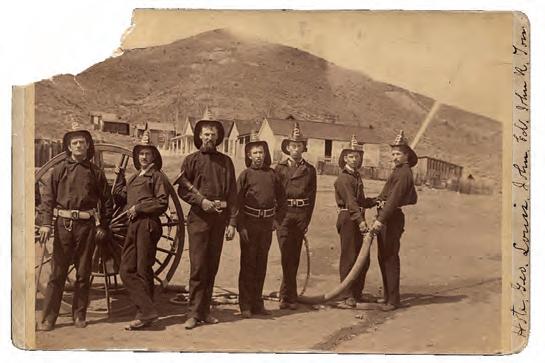
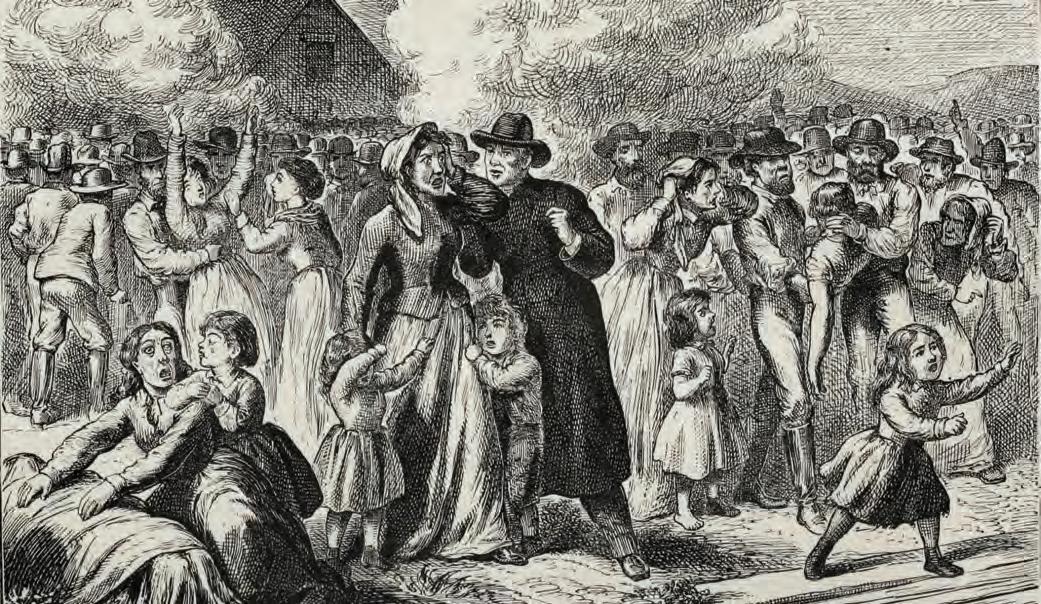
In the spring of 1872
James O’Donnell—who’d been foreman of the Yellow Jacket for eight years, although not at the time of the fire—met with mine owner William Sharon in San Francisco. To Sharon the onetime foreman confided having heard from a trusted source that the Yellow Jacket fire had indeed been arson.
According to O’Donnell, Ike Hubbell—underground foreman of the Yellow Jacket on April 7, 1869—had been approached by Crown Point foreman G.F. Kellogg the night before the fire. Hubbell alleged that Kellogg, in cahoots with Crown Point/ Kentuck superintendent Jones, planned to set fire to the mine to crash the market, whereupon Kellogg and Jones would enrich themselves through the mining stock board. “Now, Hubbell, you stick to me, and I will stick to you,” Kellogg supposedly told Yellow Jacket’s underground foreman. “I know J.P. Jones will not throw off on me, for there is more money in J.P. Jones than in those sons of bitches Sharon and [Comstock investor] J.B. Winters.”
Hubbell, the story continued, wanted nothing to do with it. But several hours later, at 3 a.m. on
the morning of April 7, Hubbell saw Kellogg at the 900-foot level with several carloads of blasting powder. A little before 7 a.m. Hubbell was on the 800-foot level when told the south end of the mine was on fire. Grabbing a pail of water, Hubbell dashed toward the fire, but the choking smoke forced him to crawl back to the shaft for fresh air. He and four or five other men then hopped aboard the cage. Before they could ring the bell, Kellogg joined them.
After being hoisted up, Hubbell whispered to Kellogg, “This is hell, and if it is found out, they will hang us all.”
Kellogg reiterated that if Hubbell stuck to him, he’d be all right. The superintendent then said aloud, “Everyone has come up—no one down there at all.” But that wasn’t the case. That evening Hubbell returned to the Yellow Jacket to help recover the bodies. The next day Kellogg cornered Hubbell, threatening to have him killed if he talked. Hubbell promised to keep silent. But Hubbell did tell his story to O’Donnell, who three years later shared it with Sharon.
“I had never believed that anyone had set the mine afire until hearing this man’s story,” Sharon reflected, “but then it at once flashed across my mind, from my knowledge of all the circumstances, that the story was true.”
Sharon instructed O’Donnell to bring Hubbell to San Francisco. O’Donnell did as bid, hopping a train to Carson, where Hubbell was employed as a guard at the Nevada State Prison. On April 29, 1872, Hubbell arrived on the noon train in San Francisco and checked into Room 330 at the Occidental Hotel. After dinner the next evening he returned to his room to find Sharon waiting in the sitting room. The mine owner introduced Hubbell to another man.
“This is my friend and private secretary,” Sharon said, “and whatever you say or agree to with him will be the same as if done with me.”
Sharon’s “secretary” had the look of a policeman about him and was, in fact, Captain Isaiah W. Lees, San Francisco’s chief detective. While Lees took notes, Sharon listened with interest to Hubbell’s yarn, particularly with regard to the culpability of Jones, who was in the running against fellow Republican Sharon for one of Nevada’s U.S. Senate seats. When Hubbell concluded his story, he expressed concern Kellogg or Jones would have him killed. On those grounds he refused to sign the affidavit.
Nonetheless, at 8 a.m. on May 6 Hubbell blurted to Jones’ friend Edmund Patten that he was about to sign an affidavit swearing Jones was behind the Yellow Jacket fire. Jones—who in 1870 had gained control of the Crown Point after striking a rich silver vein and subsequently purchased the Savage mine —was used to bunco artists and didn’t bite. Playing out the string, Hubbell met with Lees at the law office of Joseph P. Hoge, who had Hubbell’s statement transcribed into an affidavit. But when asked to sign the statement, Hubbell again refused, claiming fear of assassination.
“From his language I saw in a minute that he was talking money, and I would not lend myself to any such arrangement,” Captain Lees recalled. “He insinuated that he ought to be paid for his trouble, but I talked very severe to him, and that shut him up.”
Without a sworn statement the police could not move against Kellogg and Jones, but by then Lees doubted the entire yarn. Sharon still believed it, but whether anyone else would remained to be seen. Two days later all interested parties could judge for themselves. On May 8 the story broke in the San Francisco Chronicle. Hubbell’s accusation of arson proved so inflammatory that the paper sold out and was forced to print extra issues. Like wildfire the news spread to Gold Hill and Virginia City. If Sharon thought the “revelation” that Jones had masterminded the Yellow Jacket fire to make a fortune in stock market speculation would be met with outrage, he was correct. But he was dead wrong about at whom that outrage would be directed.
Rather than hanging Jones and Kellogg in effigy and demanding their arrest, residents on the Comstock Lode concluded Hubbell had created the story out of whole cloth. Furthermore, they accused Sharon of having paid Hubbell to blacken Jones’ reputation. Later that same day Virginia City’s Territorial Enterprise issued the following broadside: “Aware that Mr. Jones is favored in his political aspirations by a majority of miners of Storey, Mr. Sharon, it is plain to everyone here, has resorted to this atrocious means. …Malevolence has never suggested a means of vengeance more monstrous, nor has hatred ever struck with fangs so envenomed.”
Things went worse for Hubbell. Pressed, he changed his story, claiming he’d only learned of Kellogg’s involvement indirectly and hadn’t personally seen the carloads of blasting powder. All the information he’d given Sharon had supposedly derived from witnesses.
Ultimately, Hubbell returned to Gold Hill to face the music. On August 9 a grand jury convened to rehash the particulars of the Yellow Jacket fire. Of the several witnesses called, none claimed they had seen any blasting powder, nor could any corroborate the allegations Hubbell had made in San Francisco. By then a new rumor was flying: Hubbell had told his tale to Sharon and leaked it to Jones in hopes of one of two outcomes—either Sharon would pay him to sign the statement, or Jones would pay him not to. Ultimately, the grand jury concluded that no evidence existed
On April 30, 1872, Ike Hubbell, the Yellow Jacket mine’s onetime underground foreman, met at San Francisco’s Occidental Hotel with mine owner William Sharon and Police Captain Isaiah Lees. Hubbell accused Jones of arson, but the claim fell apart amid a political squabble.

to suggest arson in the Yellow Jacket fire, further dragging Hubbell’s name through the mud.
On August 10 Doten noted in the Gold Hill Daily News that Hubbell had also been expelled from the Gold Hill Miners’ Union earlier that month “by a unanimous vote.” To Doten’s mind, at least, Hubbell had suffered enough. “He has been worried and harassed throughout this matter enough to drive a more sane man than he is crazy. He has no desire to make anymore ‘statements’ or create any more sensational reports.…Let Ike Hubbell alone.”
One man who couldn’t forget Hubbell was William Sharon. On March 4, 1873, Jones—whose image had only been helped by Hubbell’s scheming—assumed office as Nevada’s next U.S. Senator. His rival remained undeterred. Two years later, having successfully fought off allegations he’d put Hubbell up to it, Sharon was elected to Nevada’s other Senate seat, joining Jones in the U.S. Capitol. As for Ike Hubbell, having seen his career as a miner and a grifter flame out, he learned his lesson and stayed out of the headlines.

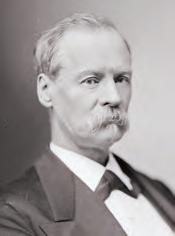
A frequent contributor to Wild West, Matthew Bernstein is the author of George Hearst: Silver King of the Gilded Age For further reading he recommends Eliot Lord’s Comstock Mining and Miners and The Journals of Alfred Doten, 1849–1903
Special thanks to librarian Donnelyn Curtis for making those journals accessible.
AN 1841 EXPEDITION TO ESTABLISH CONTROL OVER NEW MEXICO FAILED DISASTROUSLY, HELPING DOOM THE REPUBLIC OF TEXAS AND THE POLITICAL ASCENT OF ITS SECOND PRESIDENT
BY DAMOND BENNINGFIELDOn the morning of June 19, 1841, the Santa Fe Pioneers were ready to depart Kenney’s Fort, an outpost on the banks of Brushy Creek, north of Austin, the new capital of the Republic of Texas. After a review and address by Mirabeau
B. Lamar, the republic’s second president, a convoy of 24 ox-drawn wagons, 321 men, a herd of beef cattle, a 6-pounder brass field gun and about $200,000 in trade goods headed toward the wilds of northwest Texas, bound for Santa Fe.
Organized at Lamar’s direction, the expedition was charged with opening trade with Santa Fe, a growing commercial center controlled by Mexico. The trip also was designed to cement Texas’ claim to a large swath of territory east of the Rio Grande, including Santa Fe, with expedition leaders instructed to invite (but not try to compel) New Mexicans to join the republic. Lamar hoped the Texan Santa Fe Expedition, as it’s known today, would be the first step toward establishing an empire that would stretch to the Pacific Ocean.
It was not.
The expedition failed miserably. Poorly planned and led, it fell apart bit by bit as it crossed the wilderness. Men were killed in Indian attacks and spent much of the journey near starvation. The column lost most of its livestock, supplies and wagons. Survivors were readily captured by Mexican troops, sent on a forced march and imprisoned in Mexico. Perhaps 60 members of the group died, deserted or simply vanished during the 3,000-mile odyssey.
Lamar was strongly criticized for the debacle, his republic’s Congress even pondering impeachment. Yet the expedition generated renewed interest in Texas by the United States, accelerating its annexation and leading to a war that greatly increased the nation’s size, wealth and power and established the borders of the present-day state of Texas.

Born in Georgia in 1798, Mirabeau Buonaparte Lamar was a man of culture. An accomplished horseman and fencer (with swords, not barbed wire), he also painted, wrote poetry and read widely. He served as secretary to Georgia’s governor, was elected to the state senate and founded a newspaper. In 1834, though, after the death of his wife and two failed runs for Congress, he decided to move to Texas.
In April 1836, at the Battle of San Jacinto, the final clash of the Texas Revolution, his quick action saved a group of soldiers surrounded by Mexican forces, earning him a promotion to colonel and leadership of the cavalry. After the revolution he became secretary of war, then was elected vice president, serving with President Sam Houston, the hero of San Jacinto.
Lamar soon broke with Houston, however, over the president’s conciliatory approach to the bellicose Cherokees and Comanches. Texas’ Constitution prohibited Houston from serving consecutive terms, and Lamar succeeded him as president, taking office in December 1838.
A strong proponent of education, the cultivated Lamar convinced Texas’ Congress to set aside public lands for schools
The Texan–Santa Fe Expedition left Austin (beneath the X in Texas above) on June 19, 1841, its 321 men driving beef cattle and two dozen ox-drawn wagons loaded with some $200,000 in trade goods. Also toting a 6-pounder field gun, the men resolved to win over Santa Fe (at top left) one way or another. Instead, the party fell to pieces, losing most of its livestock and supplies, its surviving members captured and forcemarched to Mexico City (bottom center).
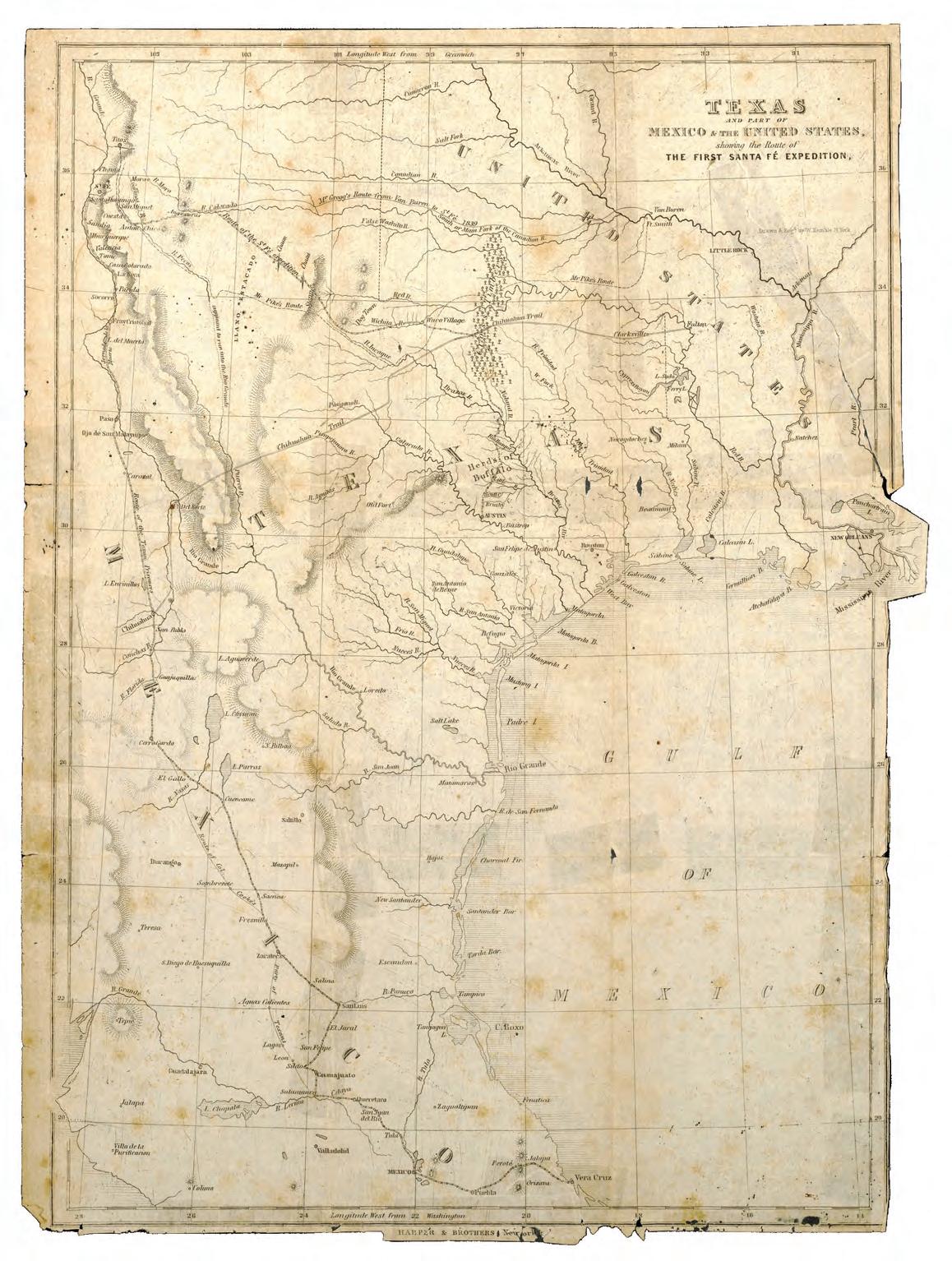
and two universities. On the other hand, he ordered troops to drive Indians from the frontier, alienating previously friendly tribes and stirring up more violence. Partly to expand the republic’s territory and partly to needle Houston, he convinced Congress to establish a new capital on the frontier, far from the existing capital named after Houston. Lamar’s term was also punctuated by run-ins with Mexico.
His policies were costly, and public debt soared. So, the republic printed paper money worth little at first and almost nothing later on. Texas needed cash and lots of it. Lamar saw the expedition as a way to tap into the lucrative trade between Santa Fe and its partners and to convince its merchants to use Texas ports.
The president also hoped to solidify the republic’s claim to New Mexico. When captured at San Jacinto, Mexican President Antonio López de Santa Anna had ceded much of the territory by treaty. Texas’ Congress formally claimed the land in late 1836, but the republic hadn’t yet tried to enforce the claim.
Lamar asked Congress to authorize the expedition in 1840, and both houses seemed amenable. Lamar left the country for health reasons late that year, though, and by the time he returned, Congressman Houston had torpedoed the idea.
Undaunted, Lamar pressed on. He had reason to believe a delegation would receive a warm welcome in Santa Fe. Several trusted men who’d spent time there advised him that its people were disgruntled with Mexican rule and their governor, Manuel Armijo.
That spring Lamar had written an open letter to the people of Santa Fe, inviting them to join the Texas cause. “We shall take great pleasure in hailing you as fellow citizens,” he wrote, “members of our young republic and co-aspirants with us for all the glory of establishing a new and happy and free nation.”

The capital of the nascent republic doesn’t quite look up to the task of realizing its imperial ambitions one year prior to the expedition. But Texas needed cash, and the Santa Fe trade was tempting.
Lamar appointed commissioners to carry greetings to Santa Fe and, if possible, assume control of the territory. He authorized a volunteer military force (Texas’ Congress having disbanded the republic’s army) and recruited merchants eager to ply their wares.
Lamar appointed William Gordon Cooke senior commissioner and commander of the expedition. The Virginia native had trained in the family pharmacy business before moving to New Orleans, where he joined other American volunteers off to fight in the Texas Revolution. He joined the Texas army in 1836 and at San Jacinto prevented worked-up troops from executing Santa Anna. Cooke later helped lay out roads, fought Indians, explored and mapped much of north-central Texas, and established a fort around which sprouted up Dallas.
Another commissioner was José Antonio Navarro, a Tejano —a Texan (or Texian) of Hispanic descent. He’d fought for Mexican independence but felt the Anglo-American settlers provided a better chance to develop Texas, so he sided with the revolutionaries. A signatory of Texas’ Declaration of Independence, he helped draft the republic’s constitution, was elected to its Congress and supported Lamar. He also fought for the rights of fellow Tejanos, many of whom were mistreated by Anglo settlers. Navarro would suffer more than any other member of the expedition, narrowly avoiding execution and spending more than two years in a squalid prison.
The expedition was imperiled almost from the moment it left Kenney’s Fort. Its departure had been delayed more than a month, so the men would cross Texas at the hottest, driest time of the year. The convoy carried limited food and within days of departure had to send for more cattle. “The supply of
cornmeal for bread hardly lasted over two weeks, flour or crackers we were not furnished, coffee we had only for about a month and not even salt enough to last more than two months,” recalled 18-year-old German volunteer Cayton Erhard. Oddly, no one knew exactly where they were going, how great a distance they would cover or the obstacles they would encounter.
Even so, the journey began smoothly enough. The expedition crossed prairies, camped along creeks and rivers, dined on the abundant bison and other game, and avoided confrontations with Indians. A month into the trip, though, its luck began to turn.
“After we reached the Cross Timbers [woodlands in central Texas], then our main troubles commenced,” Erhard wrote. “In fact we were lost. Great difficulties presented themselves for advance by a rough, broken country and great scarcity of water and provisions.…We were still about 500 miles distant from Santa Fe…a very unpleasant contemplation when we had nothing to live on but poor oxen, little game and great risk of life to hunt that, on account of hostile Indians.” A popular phrase among the men was, “I’ve seen the elephant—I’ve had enough!”

Reaching what they thought was the Red River, they turned west toward New Mexico. But they were in error. The river was the Wichita, 75 miles south of the Red. “Here commenced our great troubles and sufferings,” Erhard wrote.
The expedition forged paths through dense woods, encountered uncrossable gullies and at times endured a day or more without water. On August 13, while encamped in tall grass at the edge of a ravine, a fire broke out. “The flames spread with wonderful rapidity, and in a few moments two of our wagons were on fire, one of the tents was burnt up, and the other wagons were barely saved,” recalled expedition member Thomas Falconer, a British jurist and adventurer, in an 1843 paper for Britain’s Royal Geographical Society.
On August 30 Kiowas attacked a Texan scouting party, killing five men, then stripping and mutilating their bodies. One had his heart cut out. By then, the expedition’s supplies were exhausted. Daily beef rations were cut to a pound and a half per man, bones included, and they butchered the horses killed in the Kiowa attack. The combination of long marches, little water and poor food “had combined to weaken and dispirit the men, render them impatient of control and inclined to disobey all orders,” wrote merchant George W. Kendall in his Narrative of the Texan Santa Fe Expedition, the most extensive history of the enterprise written by one of its members.
The expedition’s appointed military commander, 27-year-old Brig. Gen. Hugh McLeod, had only managed to exacerbate the column’s troubles. Born in New York City and raised in Georgia, McLeod graduated from West Point, last in a class of 56. Later resigning his commission to join the new Republic of Texas,
The words of 18-year-old German volunteer Cayton Erhard were an understatement weeks into the trek, as the party faced scorching heat, a dearth of water, dwindling supplies and, if that weren’t enough, attack from marauding Kiowas.
he became a general, both fought against and negotiated with Indians, and studied and practiced law. McLeod’s command began meekly, as he fell ill soon after departure and had to return to civilization to recuperate. He was away from the party for two weeks, slowing its progress. He earned little respect as a commander, often requiring the independent-minded volunteers to drill. One officer resigned, and several men deserted. On August 31, with time and options running out, McLeod dispatched a vanguard of nearly 100 men, commanded by Commissioner Cooke, accompanied by troops under Captain John S. Sutton and equipped with most of the remaining horses and a few days’ food rations, to seek help in Santa Fe—still 300 miles away.
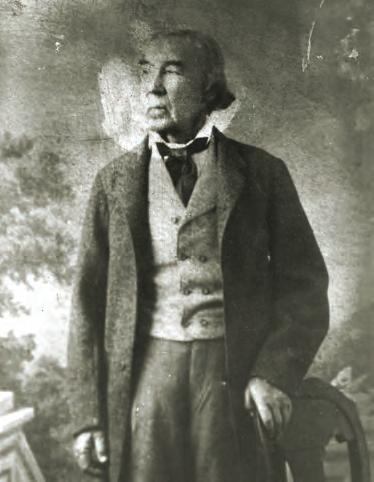
September 17 was a pivotal day for the expedition, one demonstrating that the assurances Lamar had received of a warm welcome in New Mexico had been startlingly wrong.
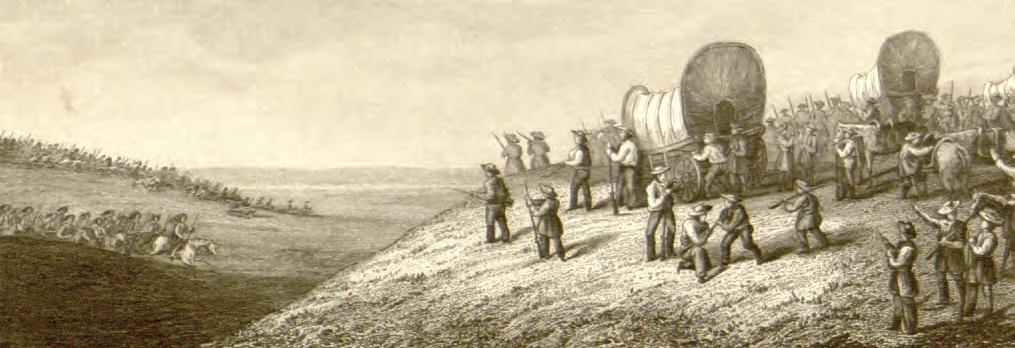
Mexico had deposed Santa Anna after his loss to Texas, and its Congress had refused to ratify the treaty he’d signed ceding control of New Mexico. After the Santa Fe Pioneers set out, Santa Anna had returned to office, and he regarded the expedition as an attack on Mexico’s sovereignty.
New Mexico Governor Armijo had long been preparing for a Texas incursion, petitioning Mexico City for more money and troops to protect his domain. He alerted his citizens to the potential threat and offered rewards to anyone warning of an enemy approach.
The New Mexican frontier was much farther than expected, and by the 17th Cooke’s vanguard had traveled more than two weeks instead of the expected few days. The group sustained itself by devouring “every tortoise and snake, every living and creeping thing…with a rapacity that nothing but the direst hunger could induce,” Kendall recalled. A desperate Cooke had dispatched three scouts on September 4 and five more on September 14. Both groups were captured by Mexican troops under Captain Damasio Salazar. On the 17th the second group watched helplessly as a firing squad shot two members of the first group in the back. A third Texan was killed after an escape attempt.
The rest of the vanguard surrendered that same day, thanks to an act of betrayal. As the second group of scouts was being marched toward Santa Fe, it encountered Armijo, who was leading a large force to intercept the Texans. He asked for an interpreter from among the Texans, and Captain William Lewis, who had spent time in Santa Fe, volunteered. Armijo sent him back to Cooke with a message.
Lewis was captain of the artillery and appears to have served honorably during the long journey. On September 17, however, he warned Cooke that Armijo was approaching with thousands of troops (the governor’s command was much smaller than that, though still larger and in better shape than that of the exhausted Texans). Lewis conveyed Armijo’s promise that if the Texans disarmed, they would be escorted to Santa Fe, where they could conduct their trade and return home safely. Lewis and Cooke were fellow
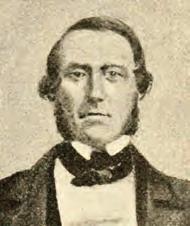

Masons, and Lewis swore a Masonic oath that Armijo’s assurances were honest and true. They weren’t.
On catching up with Cooke’s main column, Salazar’s men took the Texans’ arms, trade goods, blankets, money, even their coats, then bound them for the march to Santa Fe.
Some contemporaries suggested Lewis knew resistance was futile and was merely trying to save his comrades. Others said he was tricked by the New Mexicans. Most, however, thought he’d sold out, betraying his fellow Texans for his own life and a share of the expedition’s goods. Regardless, Lewis was later ostracized in both Mexico and the United States. His ultimate fate remains uncertain.
A few days prior to its capture the vanguard had encountered friendly New Mexicans who assured them villages were close by. Cooke sent messengers with the promising report back to McLeod at what the Texans called Camp Resolution, northeast of present-day Lubbock.
McLeod and party had spent a miserable couple of weeks there. At least 13 men had died of disease or in Indian attacks, and supplies were exhausted, the men having resorted to eating roasted or boiled hides from slaughtered animals. On September 15 Peter Gallagher, a 29-year-old Irish stonemason and merchant, recorded the state of things in his journal (the only diary to survive the trip): “Much discontent. The men wish to burn everything and return home. I never suffered so much in mind in my life.”
Cooke’s messengers arrived in camp on September 17, and McLeod followed them back to New Mexico. On October 4 he camped near presentday Tucumcari, there encountering forces under Colonel Juan Andrés Archuleta.
McLeod was oblivious to the fate of Cooke’s party, and his own group could muster only about
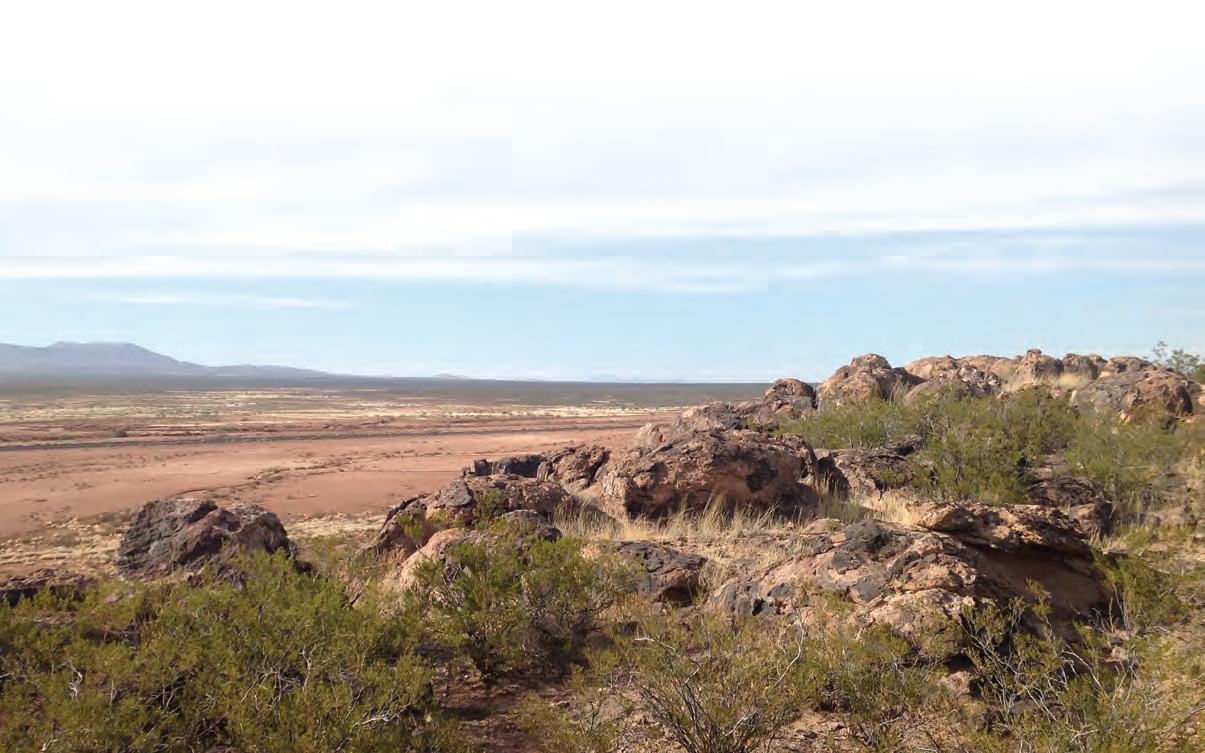
90 able-bodied men. So, on written assurances of fair treatment from Archuleta, he ordered his men to yield their arms. With that, the entire Santa Fe Expedition had surrendered without firing a single shot.
Archuleta escorted McLeod’s party to Armijo’s camp, where, stripped of their coats and all but a single blanket apiece, the Texans were bound together in groups. Armijo then convened a council of officers to consider their fate. “It was expected that all our men would be shot,” Erhard wrote. The council instead voted for imprisonment, and the group started on its long march south to Mexico City.
The Cooke and McLeod parties trudged into Mexico separately. Mc Leod’s group endured an especially brutal journey under Salazar, as re corded in Noel M. Loomis’ 1958 book The Texan–Santa Fe Pioneers. The captain scarcely fed the Texans, who were forced to march 30 or more miles a day on feet that were alternately blistered, bleeding and frostbitten. After one Texan died in his sleep, Salazar had his ears cut off as evidence for superiors the man hadn’t deserted. When another Texan with bad ankles refused to walk, Salazar summarily shot him and had his ears severed and preserved. Their only relief came when local women gave them food and water as they passed through pueblos and villages.
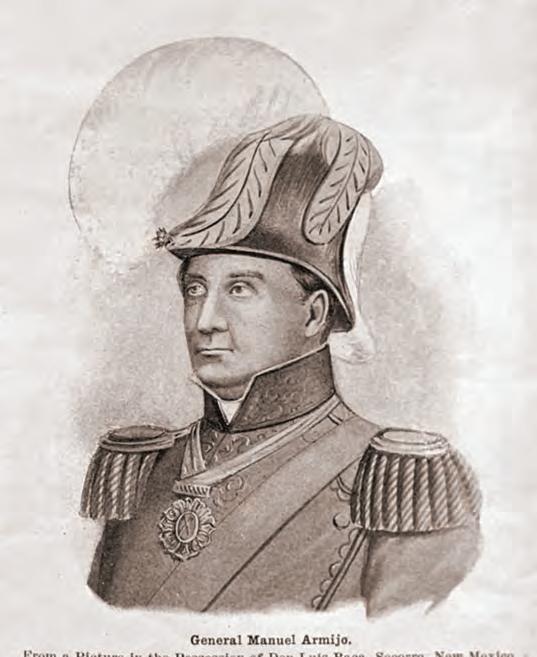
On October 30 the convoy entered the notorious Jornada del Muerto (“Journey of the Dead Man”) desert, a bone-dry, 90-mile stretch of sand, volcanic rock and thorny vegetation. Across this forbidding landscape Salazar force-marched the group overnight, providing no water and stopping only briefly to rest his horses. One Texan too weak to continue was smashed in the face with a musket and died, while another was shot.
The suffering didn’t end till they reached El Paso del Norte on November 4. “The greater number of the men were broken down by lameness and fatigue,” Falconer wrote. “Many were almost naked, and others were suffering from sickness. Immediately on their arrival everything in the power of the commandant, Colonel D. José María Elías, was done to relieve them, and assurances were given of their personal safety.”
After a few days’ rest the prisoners resumed their trek to Mexico City, where they arrived in early February 1842 and were dispersed among various prisons and asylums, including one for lepers. Some were later released, others escaped and some were abused. Finally, on June 13 Santa Anna declared an amnesty (except for Navarro, who was held in a notorious prison for 14 months before escaping). Each expedition member made his own way back to Texas.
The Texan Santa Fe Expedition had failed—dramatically and disastrously. Yet it would also prove disastrous for Mexico. Long before the expedition reached Mexico City, news of the men’s capture raced across Texas and the nation. Newspapers from New York to Atlanta published regular updates. Meanwhile, Lamar had to answer to his own republic. He tried to justify his actions in a message to Texas’ Congress on Nov. 3, 1841, writing that he believed the expedition “would do more towards reviving the drooping energies of the nation, enriching the people and relieving the government from its embarrassments, than all the financial theories and speculations which may be devised for a quarter of a century to come.”
Congress wasn’t mollified, however. That December 6, with Sam Houston already in Austin to be sworn in for his second term as president, a committee recommended the House of Representatives consider articles of impeachment against Lamar and his vice president and secretary of war, noting that Congress had authorized neither the expedition nor funding for it. “His Excellency the President, in fitting up and sending out the Santa Fe Expedition, has acted without the authority of law or the sanction of
reason,” the committee wrote in a draft resolution. “The reasons assigned by the president are strange, unnatural and unsatisfactory, and…the course pursued by his Excellency meets the disapprobation of Congress.”
Congress didn’t act on the recommendation, however, and Lamar retired to Richmond, Texas (though he fought with the U.S. Army during the subsequent Mexican War). Until his death at age 61 in 1859 he traveled, wrote poetry, remarried and campaigned in support of slavery.
The United States annexed Texas on Dec. 29, 1845, ending Lamar’s dream of empire. By then national opinion had turned strongly against Mexico, and shortly after Texas joined the Union, the United States declared war. Its victory stripped Mexico not only of Texas, but also of New Mexico and California. Yet Texas kept most of what it had already claimed, extending its boundaries far beyond its frontier and establishing the familiar outline it maintains today.
Damond Benningfield is a freelance writer and audio producer in Austin. For further reading he recommends Narrative of the Texan Santa Fe Expedition, by George W. Kendall; The Texan–Santa Fe Pioneers, by Noel M. Loomis; and Journals of the Sixth Congress of the Republic of Texas, 1841–1842.
THE CASE OF ONE PATRICK CLEARY OUT OF KANSAS FEATURED A DEADLY SHOOTING, A MURDER CONVICTION, A HUNG JURY AND A JAILBREAK— AND THAT’S ONLY HALF THE STORY
BY LAWTON R. NUSSOn the evening of June 3, 1889, Patrick Cleary grabbed a hatchet from beside the courtroom woodstove and burst outside into the darkness. Some later suggested Sheriff Thomas Boyle had intentionally released his prisoner, believing Cleary stood a better chance of escaping the lynch mob gathered outside than Boyle had of stopping them. Just that morning the sheriff had rescued a juror from a crowd of angry citizens demanding to know why the man had voted to acquit Cleary of murder. Many in the crowd believed Cleary had bribed the man, and some thought the juror himself merited lynching.

Cleary was struck by a bullet as he ran across the courthouse lawn, though it remained unclear whether the shot came from startled guards or angry citizens. Regardless, the vigilantes subsequently captured and lynched the wounded w ould-be escapee. The history of the Old West is replete with gunfights, jailbreaks, lynchings, murder convictions and even hung juries. But the
Cleary case in Lincoln County—the one in Kansas, not the one in New Mexico Territory that witnessed the 1878 Lincoln County War— featured all of those elements in one violent saga.

Over the years neighboring ranchers and fellow Civil War veterans Patrick “Patsey” Cleary and Jesse Turner had grown to hate one another. In 1888 the bad blood between them, brought to a head in a dispute over watering rights for their cattle herds, finally erupted. Cleary was in his mid-40s, Turner about 60. They had grown their herds to 300 head and 100 head, respectively.
On January 2 Cleary happened across Turner’s 12-year-old son, Charles, and 15-year-old son, Isaiah, tending the family herd at a watering place on the west branch of Elkhorn Creek. Cleary told the boys to inform their father that he’d recently bought the watering and grazing rights to the site, and that the Turners’ cattle were no longer welcome there. When Turner joined his sons at the watering place that afternoon, they gave
The Back Roads of Central Kansas
On Jan. 3, 1888, cattleman Jesse Turner urged his horse down a dirt road like this one in rural Lincoln County to the home of neighboring rancher Patrick Cleary. There, after an argument over watering rights, Cleary shot Turner in the head, killing him instantly. At trial it came out that Cleary had threatened others over the years.
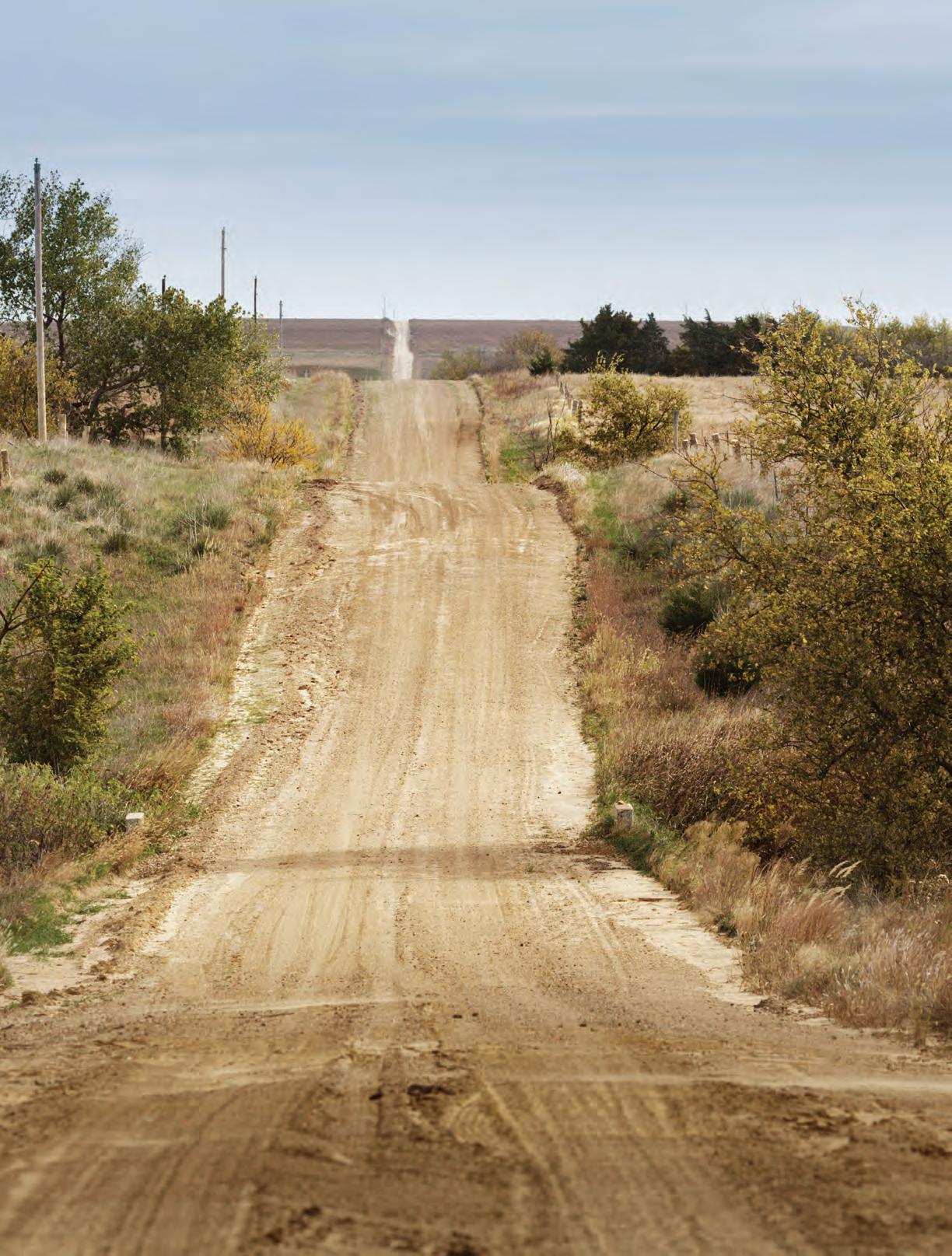
him Cleary’s message. It ran counter to Turner’s earlier understanding from Charley Jones, who lived on 80 acres adjoining the watering place. So, Jesse again confirmed with Jones that the Turners were, in fact, welcome to water their cattle on the creek. Given his stormy history with Cleary, Turner resolved to borrow a pistol for his own protection.
Later that day Cleary ranch hand John Demming rode out to the Turner ranch to deliver a note warning Jesse to keep his cattle away from the watering place:
Jesse Turner—Dear Sir: You are hereby notified not to trespass on sec. nine where your cattle watered and fed yesterday and today, as I have bought the right of grass and water on the place and need it for my own cattle. I will not have them there, and you will oblige me by keeping them off.
Respectfully yours, Pat. Cleary
Jesse wasn’t home, so Demming left the note with Turner employee Arthur White, who happened to be loading a cap-and-ball revolver at the time. Another revolver lay in plain view on a table. When Demming reported back to his boss, Cleary
concluded the Turners were set to kill him should he try to prevent them from watering their cattle.
Meanwhile, Turner had visited neighbor John W. Jaycox, a few miles south in Ellsworth County, to discuss the situation and borrow a pistol. As he had no other watering place for his cattle, Turner explained to his neighbor, he had no choice but to water his cattle on the Elkhorn the next day, Cleary’s warning be damned. Jaycox, who’d had his own run-ins with Cleary, loaned Turner a loaded revolver.
On arriving home, Turner read Cleary’s note—the second “don’t trespass” warning of the day—and told son Charles nothing had changed. They simply couldn’t deny their cattle water.
Like Turner, Cleary also made preparations for a potentially violent showdown over the watering place. The next morning, January 3, he visited neighbor Wellington J. Mills, also from Ellsworth County, and borrowed a revolver to supplement one he’d already borrowed from relative George Beggs. On arriving home, Cleary made bullets, pocketed one of his revolvers and went to feed his cattle from a corncrib near his farmhouse.
Around 9 a.m. Turner reined in his horse on the road beside the Cleary place and called for Pat to show himself. Cleary obliged and walked to within a few yards of where Turner sat his horse, armed with his borrowed revolver. Cleary’s 16-year-old son, John, looked on from the farmyard.
“What are you going to do about that watering place?” Turner asked.
“I don’t propose to let you water there,” Cleary replied. “I have bought the ground and the privilege of the watering place myself, and I need it for my own cattle.”
Turner then told his combative neighbor that he planned to water his cattle on the creek, and Cleary could not stop him.

“We’ll see about that,” retorted Cleary.
After a further exchange of insults, Turner raised a club and hollered, “You son of a bitch, I will kill you now!”
When Turner’s horse stepped closer, Cleary jumped back and yelled, “God damn you, don’t you hit me with that club!”
Turner promptly laid down the club on his saddle pommel. But then he yanked the mitten from his right hand and grabbed for his revolver. Cleary also drew his. According to Cleary and son John (the only other surviving eyewitness), Turner triggered his revolver, which misfired, and was aiming a second time when Pat shot him once over the left eye. Turner died instantly. When a township constable arrived on scene, Cleary turned over his revolver and surrendered, claiming self-defense.
Once news of the fatal shooting reached the county seat at Lincoln (population 1,000), local newspapers broke the explosive story. The Lincoln Beacon disclosed that more than a decade earlier Cleary had shot and severely wounded neighbor John Lyden. The paper also tied together two related events that put Cleary in a bad light—Cleary’s alleged attempt to murder Jaycox for having testified against him in a prior case, and Cleary’s fatal shooting of Turner, who had testified against Cleary in the same case. “One of the five men [Cleary] threatened has been disposed of and an attempt made upon the second,” wrote the paper, “and others feel that it may only be a question of time when others go the way of Turner.” The paper also quoted a reported threat from Cleary to act on his grudge against those men living along Elkhorn Creek: “I will ride a horse and leave a bloody trail along the Elkhorn Valley so that my name will be handed down to future generations as the bloody desperado Pat Cleary.”
Five weeks after the Turner killing jury selection began in Cleary’s murder trial at the Lincoln County Courthouse. Three attorneys prosecuted Cleary, and four defended him. Among Cleary’s defense team was fellow Civil War veteran Jeremiah G. Mohler. In 1879 Mohler had earned notoriety for having successfully obtained the dismissal of multiple first-degree murder charges against six Northern Cheyennes. The killings had been committed in western Kansas amid their band’s headline-grabbing flight from a reservation in Indian Territory (present-day Oklahoma) to their northern homelands.
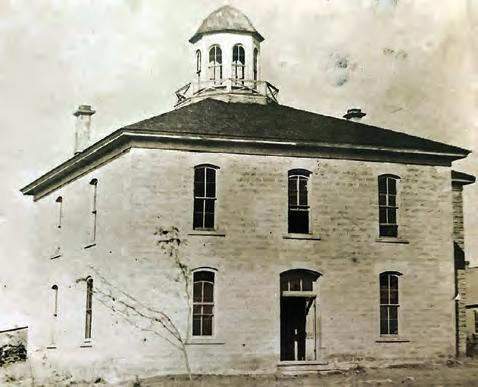
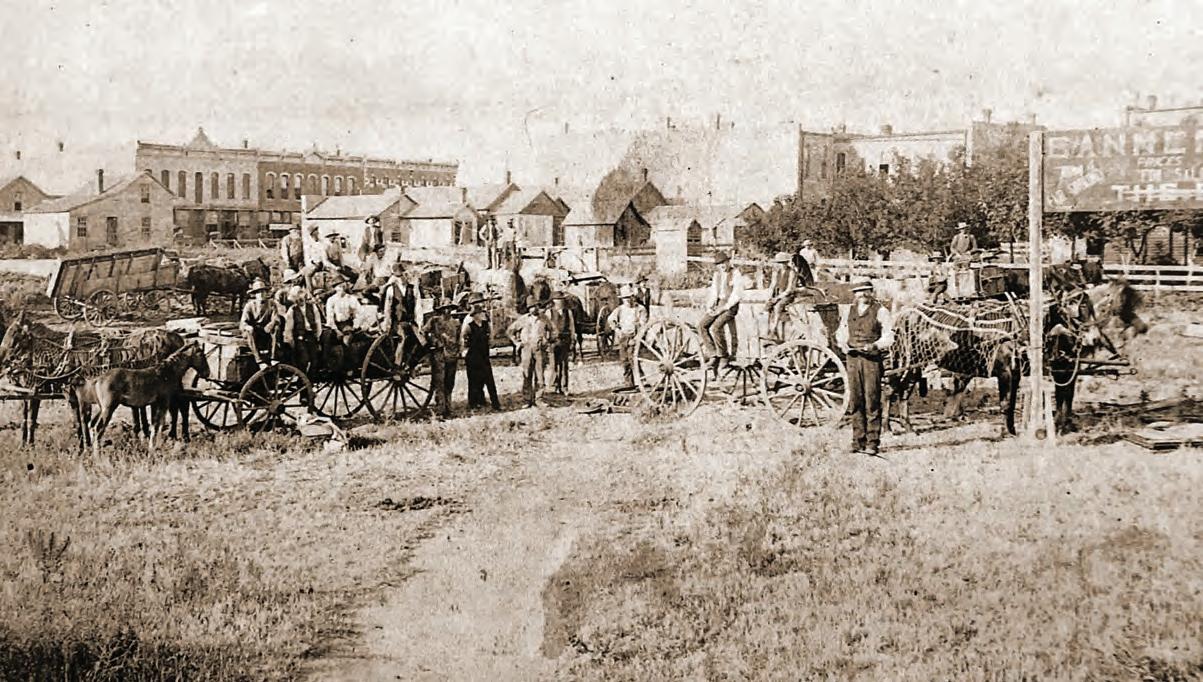
The prosecution presented as evidence Cleary’s pretrial statements, son John’s testimony about the shooting and the testimony of Jaycox, who related how Cleary had earlier tried to kill him. Other prosecution witnesses testified about threats Cleary had made over the years against Turner, Jaycox and other locals. Their statements elaborated on the Beacon ’s reference to the five men who had testified against Cleary in another case, Cleary’s threat to kill them and his “bloody desperado” boast.
A half-dozen prosecution witnesses spoke to Turner’s character, testifying that he’d been a peaceable fellow. Several defense witnesses contradicted their claims, insisting Turner had a reputation for being quarrelsome and had gone about armed on prior occasions. One witness testified that he’d been standing outside a community dance held the previous autumn when he spotted a revolver-shaped bulge in Turner’s coat pocket. When asked why he was carrying a gun, Turner reportedly answered, “I calculate to kill Mr. Patsey Cleary with that if I can.”
On February 21, having heard six days of testimony and opposing arguments, the jury rejected Cleary’s self-defense claim and convicted him of
second-degree murder. Judge Sampson O. Hinds sentenced him to 20 years of hard labor in the Kansas State Penitentiary. So it seemed those Lincoln County residents who’d been threatened by the self-proclaimed desperado could rest easy under the reasonable expectation Cleary would die in prison or at least age to the point of infirmity. Or could they?
Attorney Mohler immediately filed an appeal with the Kansas Supreme Court. Among his arguments was an allegation that juror Oscar Gorten had provided false or misleading answers during the jury selection process to hide his prejudice against Cleary. As proof, Mohler submitted affidavits from two men swearing that the morning after the killing Gorten had told them Cleary was a bad, desperate man and should be hanged to save the county further expense.
During its July term the Supreme Court accepted Mohler’s argument, reversed Cleary’s seconddegree murder conviction and sent the case back to Lincoln County.
Returned to Lincoln for retrial, Cleary was again defended by the same four attorneys, with three
Residents who’d been threatened by Cleary could rest easy that he would die in prison. Or could they?
attorneys arguing for the prosecution. Much of the testimony of the 70 witnesses at the retrial mirrored that given in the original trial. Claims that an unfair or partial juror had been seated would also resurface in the retrial—only this time the juror was allegedly biased for Cleary.
The trial began on May 16, 1889, the jury receiving the case late in the afternoon on Wednesday, May 29. For four days straight jury foreman John P. Harmon reported to the court that jurors were unable to agree. They kept at it, but as deliberations ground on, townspeople’s concerns turned into indignation.
By Sunday many believed that bribery of a juror or jurors had tilted the scales of justice toward Cleary. More alarming to authorities were openly expressed threats to lynch the accused. They responded with a declaration “to meet with firearms any attempt at violence” and placed an extra guard over Cleary. Concerned such threats might unduly influence the jury, they added two more bailiffs to protect jurors while they deliberated.
Early the next morning—Monday, June 3—the jury remained hung after its eighth ballot, and Judge William G. Eastland discharged it from duty. Within a half hour Cleary, seemingly unwilling to press his luck with yet another trial, pleaded guilty to the substantially reduced charge of thirddegree manslaughter. Judge Eastland handed him the maximum allowable sentence of three years’ confinement at hard labor.
The citizens of Lincoln were in disbelief. After all, the first jury had convicted Cleary of murder. How could the second jury ha ve hung after hearing the same basic facts from virtually the same witnesses?
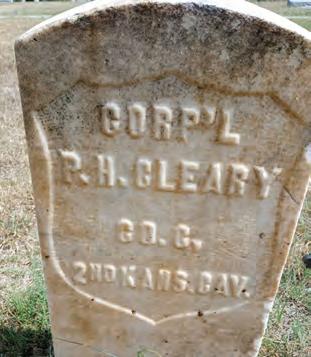
An explanation presented itself soon after the jury’s discharge when jurors volunteered that foreman Harmon— the former county superintendent of schools—had been the sole holdout for acquittal. Many citizens (and some jurors) drew the conclusion Harmon had lied about his “fairness and impartiality” during jury selection so he could get on the jury and hang it. His motive? Money.
bribe, and that he’d relied only on the evidence. Although the crowd jeered in disbelief, it eventually drifted away. But its dispersal was only the quiet before the storm.
Men continued to pour into town from throughout Lincoln County and neighboring Ellsworth County, swelling the population as well as the rumors. The bribery claim mixed with snippets of testimony recalled by those who had packed the courthouse during the trial. Particularly memorable were Cleary’s threats to kill men for having testified against him in a prior trial and his intention to be remembered as a bloody desperado. Those threatened had good reason to fear Cleary would do just as he’d promised after serving his three-year term.
Come nightfall foreman Harmon managed to slip out the back of the courthouse. Had he remained, the Salina Daily Gazette later observed, he “would have gone by the rope route in company with the murderer, as the people seemed determined to avenge the murder of old man Turner.”
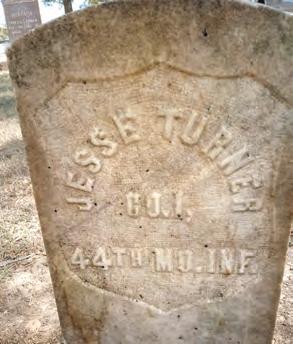
As the rumor spread, townspeople’s unhappiness turned into full-blown anger at foreman Harmon. The morning of the jury’s discharge a mob of angry men confronted Harmon on the street, demanding to know why the foreman had hung the jury. That’s when Boyle stepped in. For Harmon’s safety, the sheriff took the foreman to the courthouse, where Cleary was also being held.
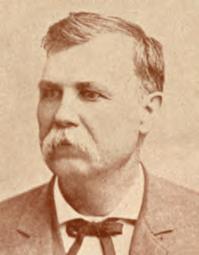
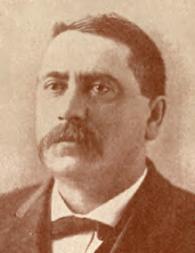
The fury of the crowd rapidly spread, and by midafternoon several hundred men had gathered outside the courthouse. Hollering up from the street, they again demanded Harmon explain why he hung the jury. Through a courthouse window he insisted that no one had offered him a
Around 9:30 p.m. Cleary, having watched Harmon slip away unnoticed, attempted his own escape. It looked promising at first. He made it outside with hatchet in hand and sprinted across the courthouse square. It is possible Sheriff Boyle released the convicted prisoner in an effort to spare him from a lynching. Others have suggested his escape from custody was legitimate. Regardless, he didn’t get far. As Cleary literally ran for his life, a bullet fired by an unknown assailant caught him in the left side, dropping him to the ground. Moments later a mob of 300 to 400 men materialized to seize Cleary.
The vigilantes dragged the wounded man to the Fourth Street railroad bridge, on the southern outskirts of Lincoln. During his terrifying half-mile journey Cleary confessed to having slain three men and attempted to kill two others. But each was done in self-defense, he insisted. Cleary,
the Lincoln Beacon reported, “was stubbornly obdurate and claimed justification for all violent acts he had ever taken part in.” Ignoring their captive’s pleas, the mob cinched a rope around Cleary ’s neck and unceremoniously hurled him off the west side of the bridge. His body was left hanging there until morning.
In the immediate wake of the lynching newspapers proffered several justifications for the mob’s actions. Some reprinted the pretrial stories about Cleary’s bad character and earlier misdeeds. Others ran new stories speaking to his bad intent. For example, George Beggs, the relative who’d loaned Cleary a revolver a few days before the gunfight, claimed Patsey had first tried to “lie him” into killing Turner. When Beggs refused, Cleary replied, “Then I will do it myself.” And he did. Beggs was certain his relative had committed cold-blooded murder.
“Accounts are rife of murders alleged to have been committed by the late Patsey Cleary” the Lincoln Beacon reported. One such murder cited by the Beacon and the other two local papers—the Lincoln County Democrat and Lincoln Republican—was “the wanton killing of a Negro at Fort Smith, Ark., during the war,” purportedly after the man had “[taken] up too much of the sidewalk.” Cleary also allegedly killed brother-inlaw Cornelius Deits and a man in Colorado. According to the Lincoln papers, Cleary also shot a man in Arizona and “is known to have shot
So spoke President Theodore Roosevelt in his third annual address to Congress in 1903. The question of guilt aside, the “Cowboy President” would certainly have been appalled at Cleary’s summary execution.
and wounded three men in this county at different times.” Back in 1869 other Kansas newspapers had reported that at a store on Elkhorn Creek he’d shot and wounded four men. Three of the victims—George Green, Henry Tucker and John Lyden—had served as Forsyth Scouts and fought Cheyennes the previous September at the Battle of Beecher Island in Colorado Territory. After that “shooting affray,” the Daily Kansas Tribune had opined, “the prospects were that [Cleary] would be lynched if caught.” Its prediction had been 20 years premature.
On June 3, 1889, in the wake of his retrial, a mob converged on the courthouse in Lincoln. At 9:30 p.m. Cleary made a mad dash to escape only to be cut down by a bullet. The vigilantes then dragged him to the Fourth Street railroad bridge, cinched a rope around his neck and hurled him off into eternity.
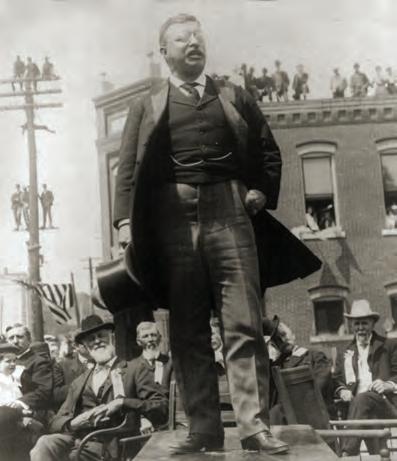

Based on the old and new accounts, as well as the events testified to at trial, the Lincoln Beacon concluded Cleary unquestionably “was a vicious and dangerous ‘badman’…[whose] highest ambition seemed to be to be regarded as a ‘terror.’”
The Lincoln Republican went so far as to opine that the occasional lynching might actually prove beneficial. “A few injudicial hangings have a good effect frequently,” it wrote, “in Kansas as well as in communities that claim a higher civilization than we.”
In contrast to such justifications for extralegal execution are the views of a formidable man who like Cleary, Turner and many others in the Lincoln and Ellsworth area raised cattle out West in the 1880s. Fourteen years after the Cleary lynching none other than “Cowboy President” Theodore Roosevelt spoke to Congress from his bully pulpit. “No man is above the law and no man is below it; nor do we ask any man’s permission when we require him to obey it,” he said. “Obedience to the law is demanded as a right; not asked as a favor.” Such sentiments help explain why Roosevelt was later immortalized in the Black Hills of South Dakota, his visage carved 60 feet high in the enduring granite.
Lawton R. Nuss is an honorary marshal of Dodge City, a frequent judge in cowboy poetry contests and the retired chief justice of the Kansas Supreme Court. This article is a modified version of one published in the July/August 2021 issue of The Journal of the Kansas Bar Association Sources for both articles include period newspapers and court records.
THE WEST TEXAS TOWN OF COLORADO CITY, WHICH BOOMED IN THE 1880s THANKS TO THE RAILROAD AND ABUNDANT WATER, WAS NO STRANGER TO VIOLENCE
BY PRESTON LEWISBad, bawdy and bankable during its 1880s heyday, Colorado City blossomed as one of the Lone Star State’s major cattle towns, only to wilt away within the decade like a funeral wreath beneath the scorching west Texas sun. When the Texas & Pacific (T&P) Railway came to Colorado City in 1881, west Texas and eastern New Mexico Territory cattlemen and their herds followed, prompting an economic boom that made the community the last, if least remembered, of the great cow towns that dotted the American West between 1865 and ’90.
Perched on the banks of the Colorado River, the railhead at Colorado City was central to the development of the region, so much so that the town earned the moniker “Mother City of West Texas.” The community provided not only vice and nice for area ranch hands but also supplies and building materials for regional ranches and other nascent communities seeking prosperity and permanence in west Texas and the Texas Panhandle. The latter distinction would prove its undoing.
What started on Sept. 1, 1880, as A.W. Dunn’s 25-by-60-foot store with a dirt floor, plank walls and a canvas roof evolved into west Texas’ first boomtown. Colorado (as the settlement was known before opening a post office and proclaiming itself a city) developed an early reputation as the lustiest and roughest town between Fort Worth and El Paso. Though Dunn settled the site, the burgeoning city owed its decade of economic signifi-

cance to financier Jay Gould, among the most unscrupulous and reviled business magnates of the 19th century.
Chartered by Congress in 1871 to extend from Marshall, Texas, to El Paso, where it would connect with the Southern Pacific, the T&P experienced financial difficulties in 1876 that halted construction at Fort Worth. For more than three years all work on the T&P stopped while Gould sought investors to revive the moribund project. Meanwhile, the Southern Pacific muscled its way eastward through El Paso and 92 miles farther to Sierra Blanca. Westward tracklaying on the T&P resumed on April 1, 1880, reached Colorado City on April 16, 1881, and finally linked up with the Southern Pacific at Sierra Blanca on Dec. 16, 1881.
A.W. DunnIts riverside locale made Colorado City special among rival railheads along the route. Cattle can gulp down as many as 15 gallons of water each on hot days, and the Colorado River provided arriving herds plentiful, albeit brackish, water. Besides beeves, the community also shipped out sheep and wool, securing its place as a regional livestock hub.
When the T&P arrived, Colorado City had already grown to include 12 merchants, five saloons, three hotels, two livery stables, two wagon yards and a restaurant, plus three lawyers. By 1884 it boasted 75 merchants, 28 saloons, seven billiard halls, four hotels, four theaters, two banks, two livery stables, a 75-by-100-foot skating rink and a mule-drawn streetcar service that ran from downtown east to a 60-acre city park with
Plenty of tap handles are in evidence behind the bar at Bill King’s saloon, one of more than two dozen operating in Colorado City by 1884. The only requisite for patronage seems to be a well-worn hat. Such dispensaries of liquid refreshment proved a locus for the violence that plagued the Texas town in its heyday.
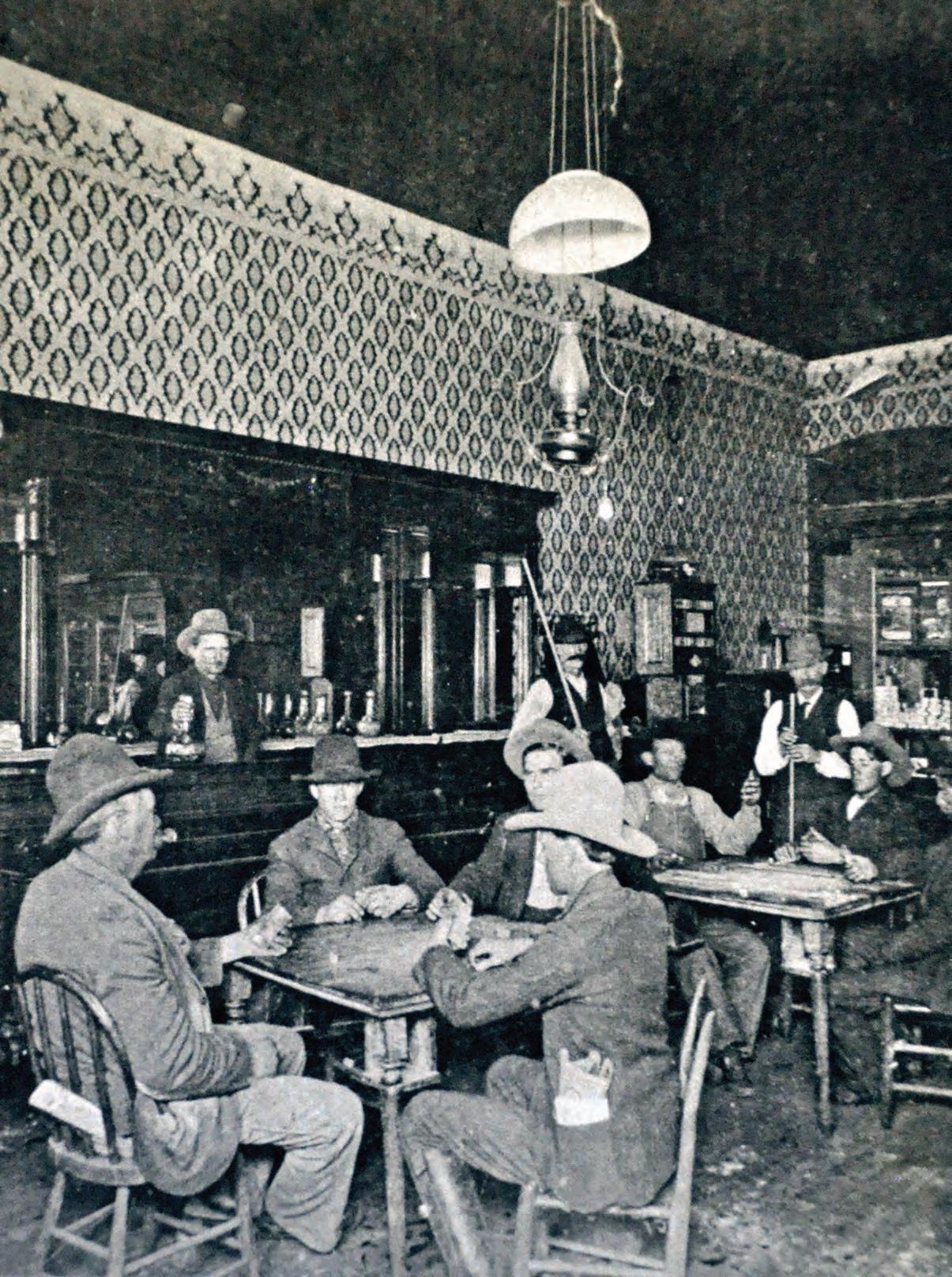
a pavilion, beer garden, zoo and racetrack. Professionals hanging up their slates included 17 doctors, 12 lawyers, seven peddlers, three land agents, two photographers, two lightning rod salesmen and a dentist.
That same year English novelist Morley Roberts visited Texas—“the land of revolution and rude romance and pistol arbitration,” as he called it—to see his brother in Colorado City. “My impressions of the town and its people were favorable,” he wrote. “There were many men walking round the streets dressed in wide-brimmed hats, leather leggings with fringe adornments and long boots with large spurs rattling as they went. They were mostly tall and strong, and I noticed with interest the look of calm assurance about many of them, as if they had said to themselves: ‘I am a man, distinctly a man, nobody dares insult me; if anyone does, there will be a funeral—and not mine.’”
Locals seemed to carry fewer guns than Roberts, having read Bret Harte stories, had expected. But his brother soon disavowed him of that notion, revealing “that almost everybody in town carried revolvers concealed under his coattails or inside his waistcoat, and that people were occasionally shot in spite of the peaceful look of the place.”
In Reconstruction-era Texas state laws and local ordinances limited the carrying of weapons in public. A detail of Texas Rangers stationed in the area since 1877 often enforced those restrictions. But while the weapons may have been hidden, violence was all too painfully obvious at times.
Soon after the first T&P train rolled into town in April 1881, one snarky reporter quipped, “Colorado City has started out with a gross population of 250 cutthroats and gamblers.” Such hyperbole aside, ne’er-do-wells did inevitably follow the tracks.
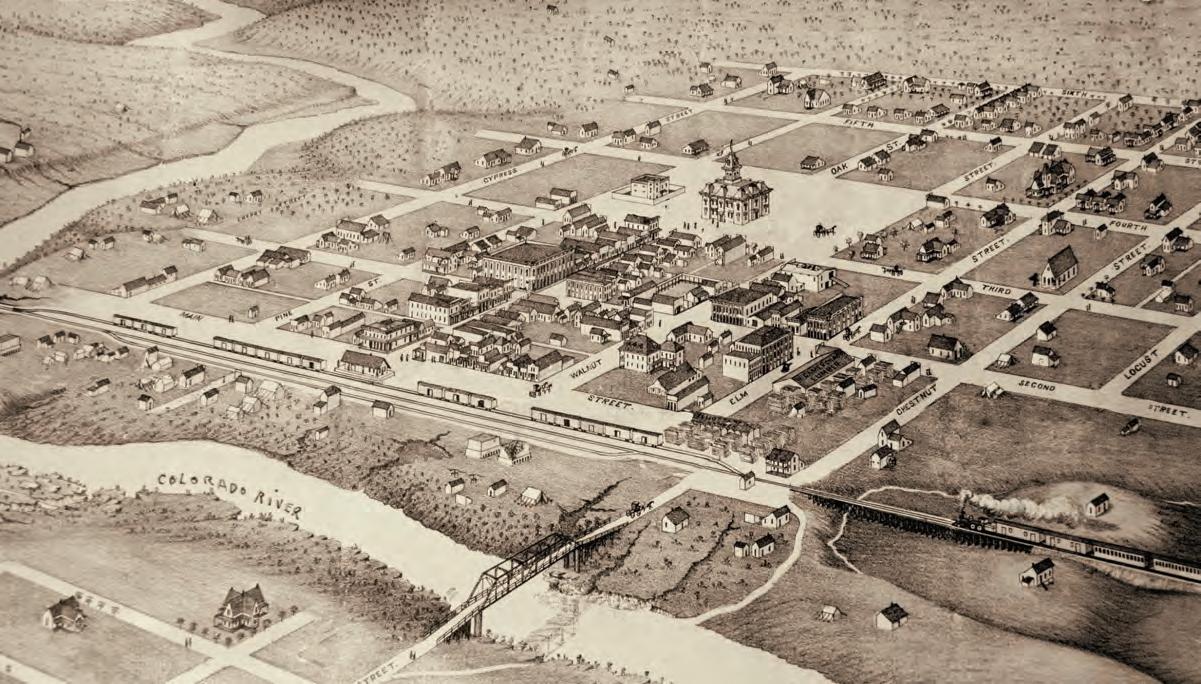
Within a month Colorado City recorded its first killing, not by an outsider, but by a trio of Texas Rangers. By most accounts cattleman William P. Patterson, the deceased, was a popular and likeable fellow—except when drunk. That January he’d lost by a single vote an election for sheriff of newly organized Mitchell County. His victorious rival was Texas Ranger Rich-
This 1883 bird’s-eye illustration by Augustus Koch depicts what was known at the time as Colorado, Texas. Perched on the banks of the namesake river, it had already proven a standout among railhead rivals, as waiting thirsty steers could drink their fill.
ard C. “Dick” Ware, a lawman involved in the 1878 fatal shooting of notorious train robber Sam Bass in Round Rock, Texas.
In the wake of his loss Patterson took to drink. During a binge that early May he shot up the town until Rangers disarmed and chained him to a mesquite tree, as Colorado City lacked a jail. Shortly after midnight on May 17 the recently freed Patterson started firing into the air outside the Nip & Tuck saloon. When a trio of patrolling Rangers—Corporal J.M. Sedberry and Privates Jeff Milton and L.B. Wells—investigated, they spotted Patterson and companion Ab Adair ambling down the street. Confronting the pair, the Rangers asked who had done the shooting. Patterson pled ignorance. A dubious Corporal Sedberry demanded to check the cattleman’s pistol. “Damn you,” Patterson answered, “you will have to go examine somebody else’s pistol!” With a nod, Sedberry and rookie Ranger Wells moved to grab Patterson’s arms, but the muscled cowman broke free, yanked his pistol and fired at the corporal, who dodged the bullet but suffered powder burns. Before Pat-
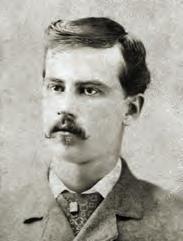
terson could fire again, Milton pulled his .45 and dropped him dead. The frightened and inexperienced Wells then shot the downed Patterson a second time as he lay on the street.
As word of the shooting spread, the crowd of cowmen at the bar inside the Nip & Tuck clamored for vengeance and the Rangers’ lynching—that is, until fearless Milton strode in with his Winchester leveled at the agitators.
When Sheriff Ware arrived, Sedberry, Milton and Wells turned themselves over to his custody, and tensions eased. Two days later Ware escorted the trio to their examining trial in the temporary courthouse. The justice set bond at $1,500, which local citizens sympathetic to the Rangers’ efforts to keep order soon provided. Though indicted for the killing, all three Rangers were exonerated two years later after a change of venue and a trial in Taylor County.
Deputy Sheriff Wayne B. Parks never received his day in court after a controversial 1885 shooting in Page & Charley’s saloon. That February 4 Ike and Joe Adair, sons of a prominent local cattleman, raised such a ruckus in the saloon’s gambling room that Deputy Parks had to step in to quell the commotion. The brothers took offense. Ike bolted from their table with gun in hand and aimed for Parks, who grabbed Ike’s arm. As they grappled, Joe opened his pocketknife, got behind Parks and slashed at the deputy’s head. Parks then yanked his pistol and blindly shot over his shoulder at the slasher while trying to keep his sibling from shooting. Joe collapsed to the floor with a bullet through his heart. The deputy continued wrestling with Ike until City Marshal Jim Woods arrived to disarm the gunman, ending the confrontation but not the rancor.
Though Parks was indicted for murder, animosity lingered for weeks among Adair’s family and friends. Three months later the deputy killed an inmate named Middleton during a May 3 escape attempt from the second-floor jail of the Mitchell County Courthouse. Middleton, an accused horse thief, jumped jailer T.J. Robinson, who was delivering supper to the prisoners. Hearing the commotion, Robinson’s wife dashed upstairs with a pistol and held off Middleton until Parks bounded up the steps to assist. When Middleton moved to resume his attack on the jailer, the deputy shot him through the head. A coroner’s jury ruled the killing justifiable.
Late on the evening of June 6 Parks was standing at the intersection of Oak and Second streets, speaking with friends, when an unknown assailant approached within 20 feet, took a potshot at Parks, then vanished in the night. Though Parks
emerged unscathed, the deputy ran out of luck that October 29 following an opera house ball. After seeing his lady safely home around midnight, Parks started for his place, only to be shotgunned from ambush by someone in hiding. Parks dropped with 10 buckshot pellets in his neck and torso, living just long enough for neighbors to hear his moans.
Rangers & Deputies at Rest
Top: These Texas Rangers in repose include the trio involved in the May 17, 1881, shooting of William Patterson—namely J.M. Sedberry (left), Jeff Milton (third from left) and L.B. Wells (right). Above: Deputy Sheriff Wayne Parks (seated at left) was slain from ambush in 1885.
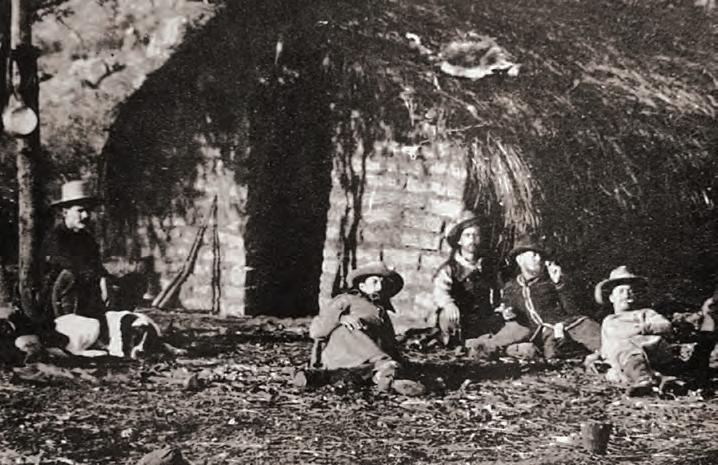
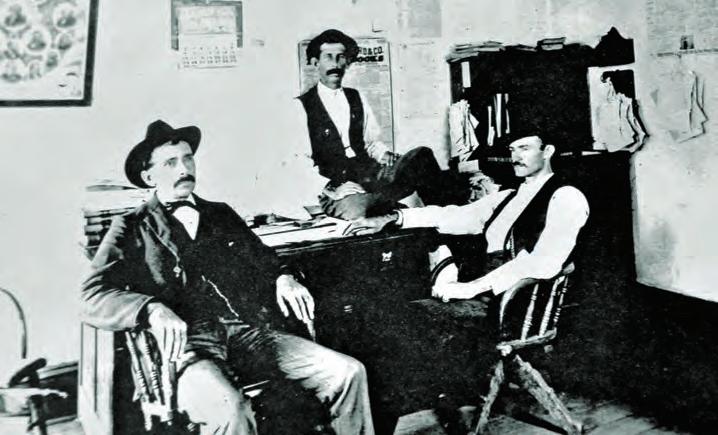
Investigators found tracks and signs indicating one man had waited with two horses behind a tree while an accomplice—described by a Fort Worth newspaper as “some unknown fiend”—fired the fatal blast. Though suspicions fell on Adair family and friends, and authorities offered a $5,000 reward, Parks’ killers were never identified.
Parks was the second local lawman to have been killed that year. On May 28 gambler Ben Jacobs had shot and killed Deputy City Marshal W.B. “Black” Hardeman in a “variety bawdy house in the west end,” as one newspaper described the crime scene. “West end” was a euphemism for the town’s red-light and seedy saloon district. Details of the dispute between Hardeman and Jacobs remain murky, though news accounts reported Jacobs shot the deputy in the abdomen, left breast and face.
So common were Colorado City gunfights that one newspaper in 1884 flippantly detailed a minor encounter. “There was, as the ‘boys say,’ a six-shooter play made in the Favorite saloon on Oak Street last night, but
nobody was hurt,” the reporter noted. “Officers and friends to the parties being near, the difference was soon adjusted.” Not all gunplay in town occurred in the west end. On May 28, 1886, a serious shooting broke out in a downtown photography gallery after one Amanda Bradley, described as “an inmate of a bagnio,” or brothel, threw a fit. Ordered to leave by proprietor F. Chapman, the woman departed and bitched about the insulting eviction to gambler Jack Martin, who strode to the studio to avenge the affront to the lady of questionable virtue. After the gallant Martin threatened Chapman, the photographer repaid Martin’s chivalry with a fatal blast from a shotgun that “filled his carcass with shot,” according to one news account, “and he went the way all such characters should go.”
Colorado City’s police blotter recorded a variety of other violent incidents in the 1880s. Sheriff Ware held off a lynch mob intent on dispensing immediate justice to an accused child molester; a saloonkeeper attempted to murder a prominent businessman; a local resident shot his mistress before killing himself; an assailant with a sheep-shearing blade engaged in a “serious cutting affray” that left the victim with protruding entrails; and authorities discovered a mystery man with a fractured skull laid out in a freight car. T&P agent J.W. Ayers, who arrived in town in 1883, recalled no fewer than 16 fatal shootings on the city streets that decade.
Colorado City bloodshed received enough negative news coverage that the Sept. 1, 1883, edition of El Paso’s Daily Times reported, “We think that Colorado City is somewhat like a great many other western Texas towns—a good place to make money in, but rather a poor one, just yet, to carry a family to and make a home in.”
The violence might have been worse save for a rumored alliance between Sheriff Ware and west end kingpin “Uncle Archie” Johnson. Reportedly at the urging of the town fathers, Ware looked the other way regarding prostitution and illegal gambling, as long as the games remained square and visiting cowboys were not rolled, drugged, robbed, cheated or murdered. In return Johnson and cronies would tip off the law about potential breaches of the peace.
The arrangement between Ware and Johnson was important. Unlike the Kansas railheads, which cowhands might visit once a year after long drives, Colorado City expected and coveted the regular return business of cowboys. If crime got too far out of hand, ranchers might steer clear of town and trade elsewhere along the T&P.
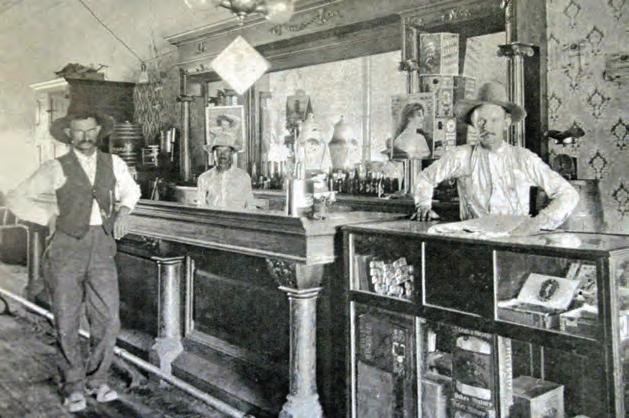
One old-timer recounted an 1886 visit to Colorado City with his newly paid pals after their spring roundup. “We were all pretty well-heeled with cash,” he recalled, “but by the next morning there was not enough left in the whole outfit to buy a feed of oats for one of our horses. Old Archie and his gals had gotten it all, but nobody kicked.”
While Uncle Archie and company were liberating cowhands from their cash, Colorado City merchants and area ranchers also raked in money. For five years after the railroad’s arrival the town boomed, at one point claiming to be the busiest cattle shipping point in the nation. When the newly created Matador Cattle Co. marketed its first herd in 1881, drovers pushed the steers 110 miles south from Motley County to Colorado City. The 12-day drive earned the company an impressive $75 a head.
While outbound trains shipped cattle, sheep and wool out of Colorado City, inbound trains brought building supplies, ranching materials and consumer wares, which merchants distributed north and west for 200 or more miles. In the northwest corner of the Texas Panhandle the 3-million-acre XIT Ranch—which extended more than 200 miles south from the Oklahoma border in an irregular 30-mile-wide strip—split its purchases between the railhead in Colorado City, to the southeast, and the one in Trinidad, Colo., to the northwest. According to investor Amos Babcock of the Capitol Syndicate, which owned and operated the ranch, it was just over 100 miles from either railhead to the XIT. The distance mattered little. As the bookkeeper of a ranch headquartered 120 miles north of the railhead noted, “We had then to go to Colorado City for almost everything.”
Legendary Texas rancher Charles Goodnight ordered supplies from Colorado City for the 140,000-acre Quitaque Ranch he managed for Cornelia Adair in the Texas Panhandle. One 1882 freight receipt from merchant A.W. Dunn recorded a delivery of 334 spools of barbed wire, six kegs of fencing staples and 38 pieces of lumber. The 33,000-pound load was freighted at a rate of $1 per 100 pounds per 100 miles. Similar commercial transactions plus livestock sales made Colorado City a wealthy community.
Beyond supplying ranches with barbed wire, windmill equipment and necessities, Colorado

City also provided emerging communities in west Texas and the South Plains with provisions and the most valuable commodity of all in the largely treeless country—lumber, an absolute essential for pioneers seeking to build homes and businesses and realize their dreams. Pioneering merchant George Singer, whose circa-1881 one-room store in Yellow House Canyon eventually spawned Lubbock, received his merchandise and mail from Colorado City, as did fledgling communities as far away as Tascosa, in the far northwestern corner of the panhandle.
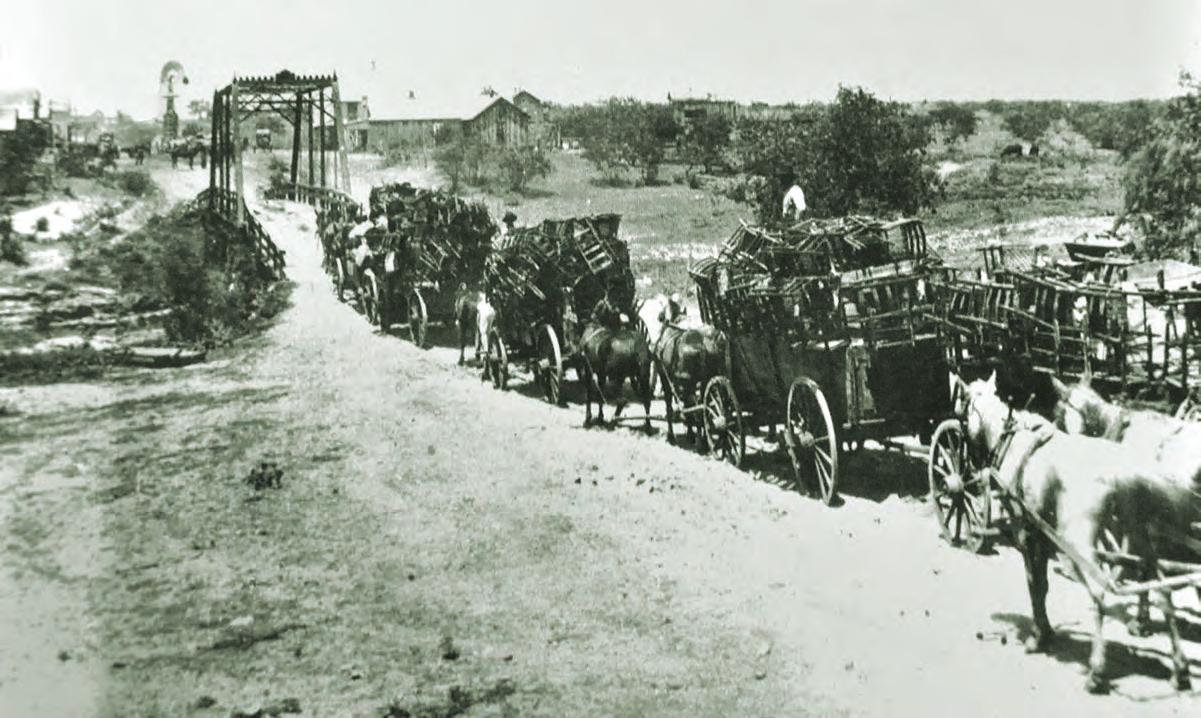
In January 1883 Colorado City’s boom caught the eye of a St. Louis Globe-Democrat reporter who noted that the town’s business transactions for the prior year “amounted to about $10,000,000,” or more than $300 million in present-day dollars. A tenth of that income, reported the paper, went to town founder Dunn for his aggregate sales in merchandise and cattle.

Anticipating a bright future, Colorado City in 1885 hosted a stockman’s ball to celebrate both the town’s prosperity and the opening of the new three-story brick St. James Hotel, complete with indoor plumbing. Cattlemen and their families from throughout Texas and New Mexico Territory

attended the celebration. One contemporary young observer said of the ball, “They put the big pot in the little one.”
As impressive and ostentatious as the “pot” may have been, the celebration marked the end of Colorado City’s heyday, not its beginning. Multiple factors contributed to the subsequent rapid economic decline, including droughts, harsh winters, declining cattle prices and competing regional railroads, particularly those extending to Amarillo and San Angelo. Given multiple railheads from which to choose, west Texas ranchers weighed their options as closely as they weighed their steers. As the manager of the Spur Ranch in 1888 explained, “The advantage of a shipping point on the railroad depends not so much on its proximity to the ranch as on the condition of the range between here and there.”
Over the latter half of the 1880s Colorado City gradually declined in wealth, significance and, mercifully, violence. By 1890 the population had plummeted from its 1884 peak of 6,000 to 1,582, while several of the surrounding communities it had spawned surpassed it with their own rail stops and ambitions. Perhaps if Sheriff Ware and vice king Johnson hadn’t colluded to curb violence, Colorado City might have developed a more flamboyant reputation and ensured its place among the Old West’s famed cattle towns. Or maybe if Colorado City hadn’t been so convenient to the ranches it served —at least compared to Kansas cow towns—it would have birthed a trail herd or cowhand Herodotus to chronicle for posterity its brief time in the sun. Instead, Colorado City flamed out like a west Texas sunset, spectacular in its moment but soon replaced by other, more boisterous cow towns.
Texas author Preston Lewis, a past president of Western Writers of America, is an award-winning author and historian with more than 40 books to his credit. For further reading he recommends If I Can Do It Horseback, by John Hendrix; Jeff Milton: A Good Man With a Gun, by J. Evetts Haley; and Lore and Legend: A Compilation of Documents Depicting the History of Colorado City and Mitchell County, compiled by J. Lee Jones Jr. and Nona C. Jones.
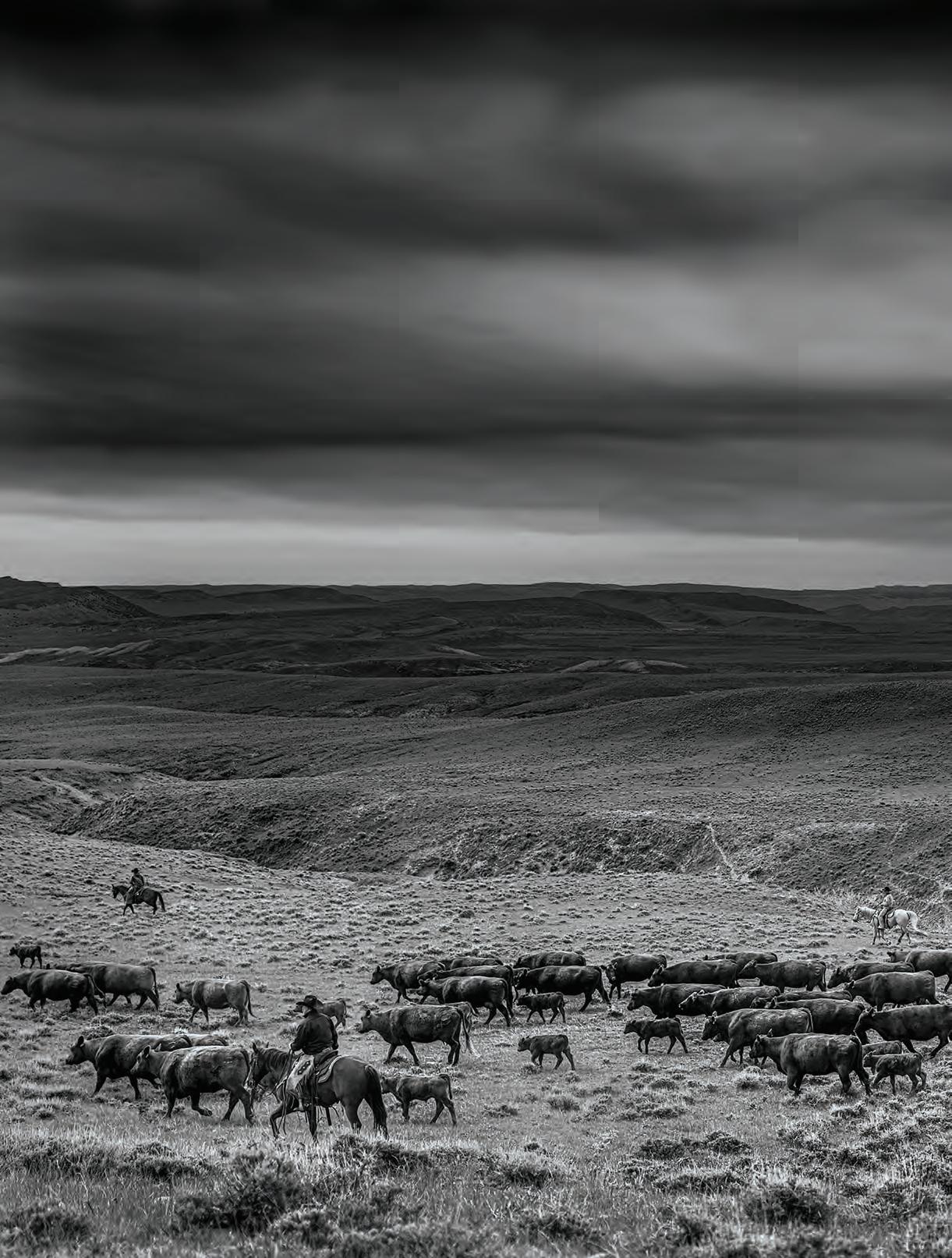

LIFE ON WYOMING’S WAGONHOUND, AS CAPTURED IN AN AWARD-WINNING RECENT BOOK, HAS CHANGED
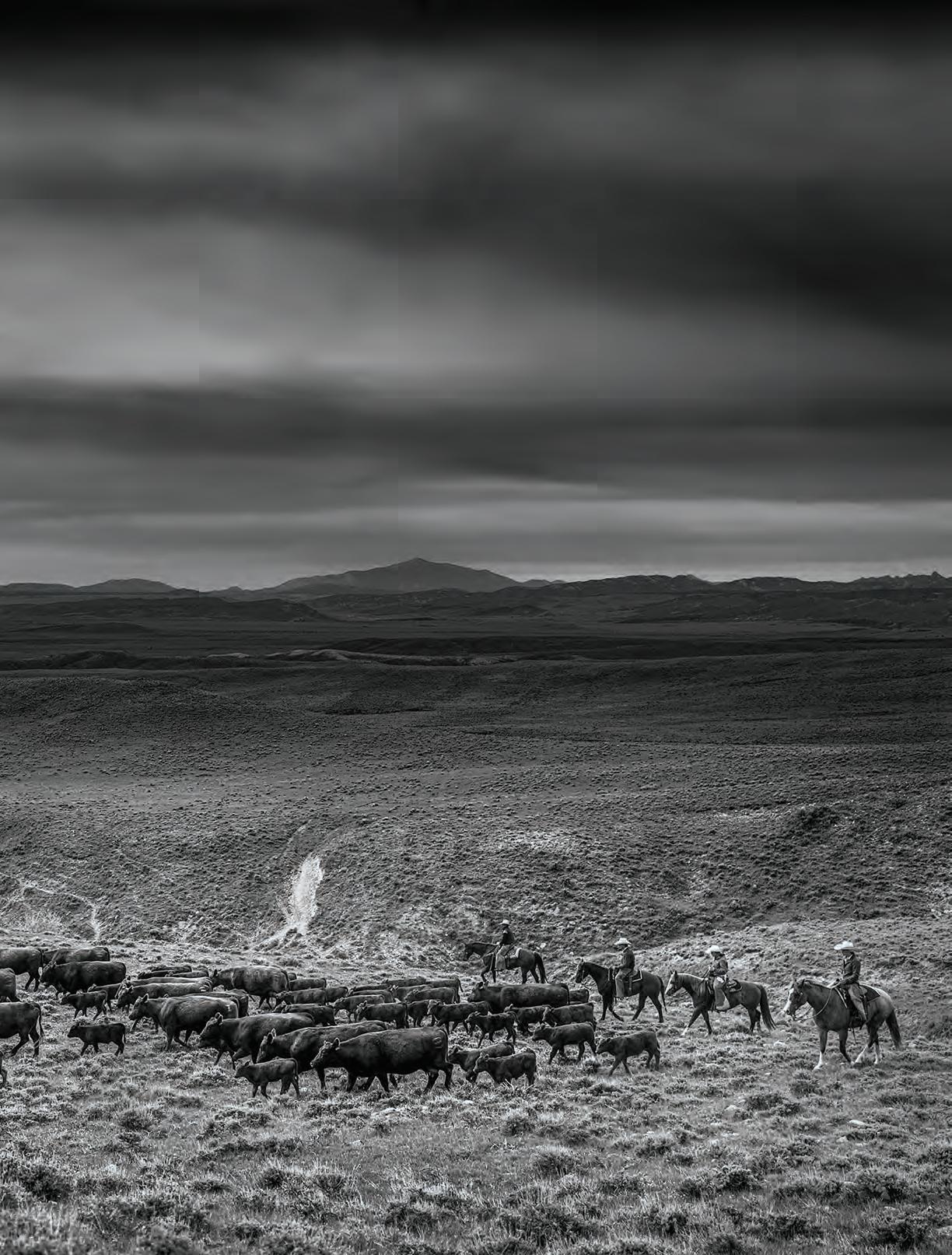
SURPRISINGLY LITTLE SINCE THE DAYS OF THE OLD WEST
BY CANDY MOULTONKeep
Historical photographs, like the one opposite, appear alongside Anouk Krantz’s images on the following pages, showing Wyoming ranch life then and now. Good cowhands know to move the herd along nice and easy so as not to run off any weight. “There is no wild, wild west running cows down the mountain,” says Krantz. “It is a very peaceful process. Slowly moving them, stopping every half hour, letting them graze.”
The romance of ranching is a myth. The reality of ranching is work. The people who live and work Wyoming’s ranchlands, no matter the location, are a hardy breed. When it is snowing and the wind is blowing—winter conditions common throughout the “Cowboy State”—they simply don a few more layers of clothing before venturing out to tend livestock, forking hay to cattle and seldom begrudging passing deer or elk from also eating a mouthful or two.
Ranchers might dub a major weather front a “million-dollar storm,” referring to the costs it wrings in lost crops or livestock. Perhaps it’s a storm that deposits more than a foot of heavy, water-laden snow on crop and pastureland just when grass needs to start growing, or one that drops snow deep in the fall or during calving season, weakening and killing newborn animals. Ranchers perpetually worry about the weather they cannot control, and about the animals they tend and depend on for a living.
Ranch work is often generational. Many of the men and women riding for such big ranches as Wagonhound—the 300,000-acre spread outside Douglas, Wyo., depicted on the following pages—learned their craft riding alongside their fathers or mothers and sometimes grandparents. Many then share the work and lifestyle with their own children and grandchildren. The best hands care for the land and stock as if they owned them. They do the work with excellence because they love the land and ride for a brand.
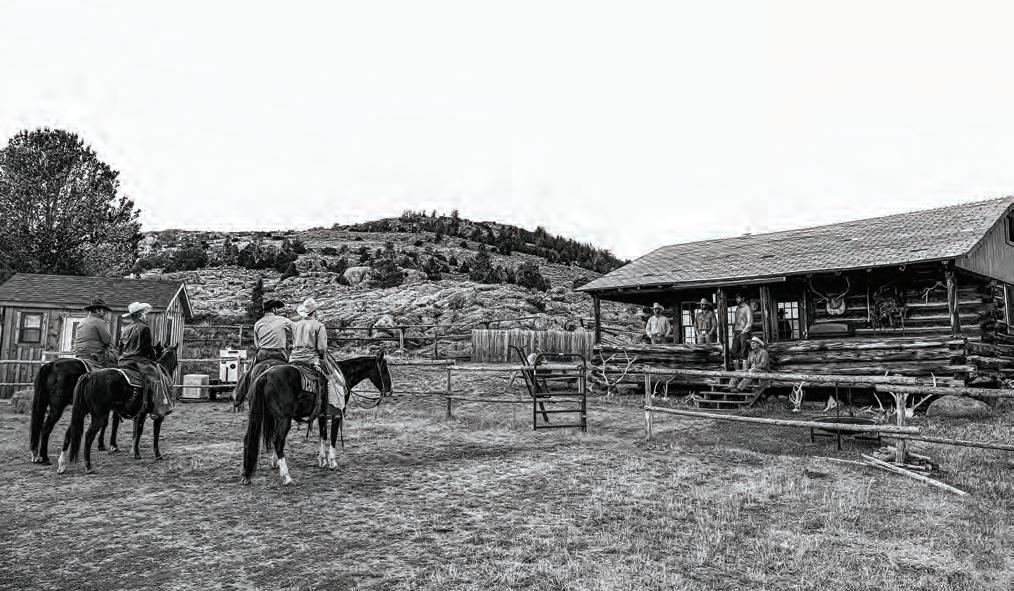
Ranchland: Wagonhound, by Anouk
 Masson Krantz,
Masson Krantz,
The Images Publishing Group, Melbourne, New York, London and Shanghai, 2022, $85
A French-born photographer from New York may seem an unlikely person to document life on a Wyoming ranch, and Anouk Krantz admits she initially came to Wagonhound with little understanding of what she saw through the viewfinder. “All my knowledge about the cowboy around this Western way of life were all sort of misconceptions,” she came to realize. “Once I put my foot through the door, I realized this culture wasn’t dying, but was very much still alive.” Wyoming’s wide-open ranchlands, “the power of nature, these amazing landscapes,” proved her inspiration.
Meanwhile, Back at the Ranch: It took photographer Krantz most of a day to fly from her hometown of New York City to Denver and then to drive north to the Wagonhound in east-central Wyoming, which she deems “one of the most isolated, remote places in the country.” The familiar welcome she received is akin to that captured in her image above of a group of riders returning to waiting fellow hands at the ranch bunkhouse. Anouk’s connection to Wagonhound “started with one piece of paper with one phone number of one rancher in Texas. He introduced me to his friends, and they introduced me to their friends.” Though a stranger to ranch life, she soon found a “connection with this land, freedom, independence.” Wagonhound headquarters is about an hour west of Douglas in the midst of an isolated landscape “like the wilderness.”
Come and Get It: Though a ranch’s mobile kitchen may be better equipped today than when the cowboys at left in Rawlins, Wyo., spread out behind their waiting chuck wagon, eating grub from a tin plate is a ritual that carries over from the 1870s–’80s heyday of open range trail drives. “Cookie” is still expected to dish out hot meals on time for busy cowboys to eat while spread out on the ground, their horses at the ready. Anouk soon earned their respect when she proved willing to follow them at all hours.

“When you are thinking about what these people are doing from dark to dark,” she says, “they are caring for their herds, but they have to do it within their surroundings. I wanted to bring that into my pictures.”

Riding for the Brand: A cowhand’s tasks—corralling, roping, castrating, branding—haven’t changed much from time of the 1890s Wyoming roundup captured below. Neither has the clothing or gear. A hand doesn’t choose clothing based on style but practicality. You’ll never see cowboys at a branding wearing short sleeves. Likewise, they’ll have on sturdy jeans, work boots and, more so today, a pair of leather chaps like those above to protect their legs from kicking calves, rope burns and the stray hot branding iron. Hat styles have become more of an individual choice, but wide brims remain necessary to shield one from the sun or keep rain from running down one’s neck.

In Wyoming, by the way, the term “cowboy” is gender neutral, as applicable to the women and girls as the men and boys who ride, rope and work cattle. That said, on the Wagonhound most ranch wives work as teachers or nurses in town. They may throw in a hand at brandings, but the daily operations are mostly men’s work. The two years Anouk spent at the Wagonhound allowed her to follow these busy men and women as they gathered and branded and otherwise did their daily chores. “I was able learn how they run a ranch, how hard they work, how much it takes to do all this,” she says. “And their deep affection and love for the land, for the animals, the cows, the calves, their dogs and their horses. It all works together in such a harmony.”
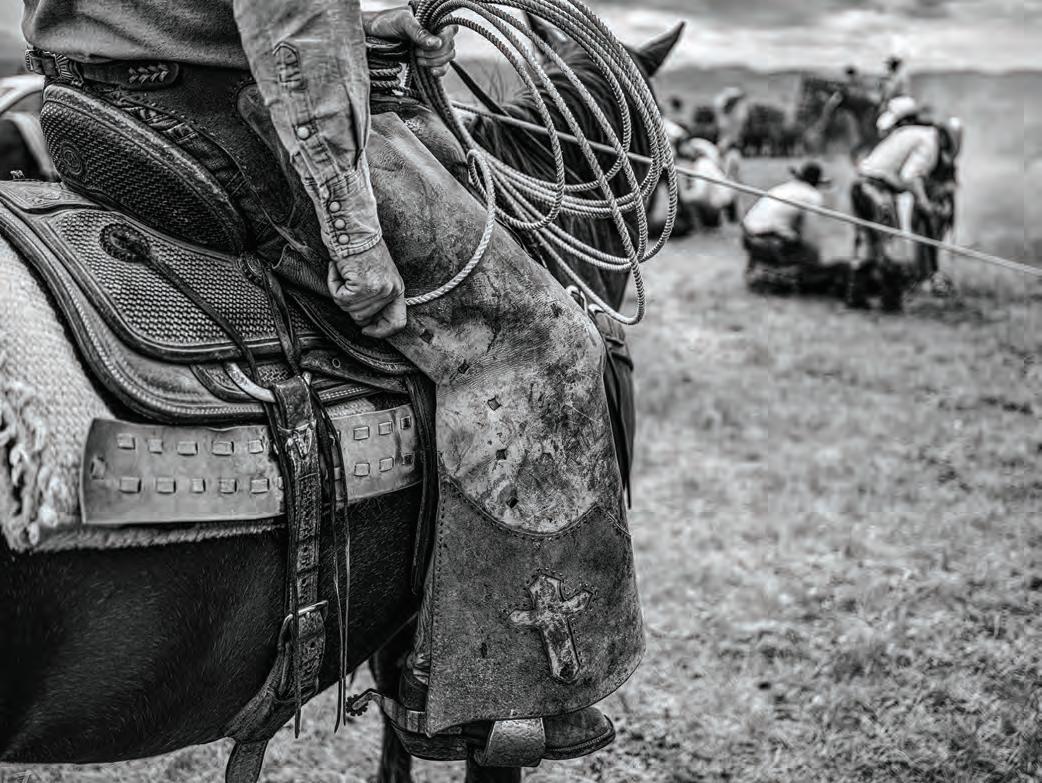
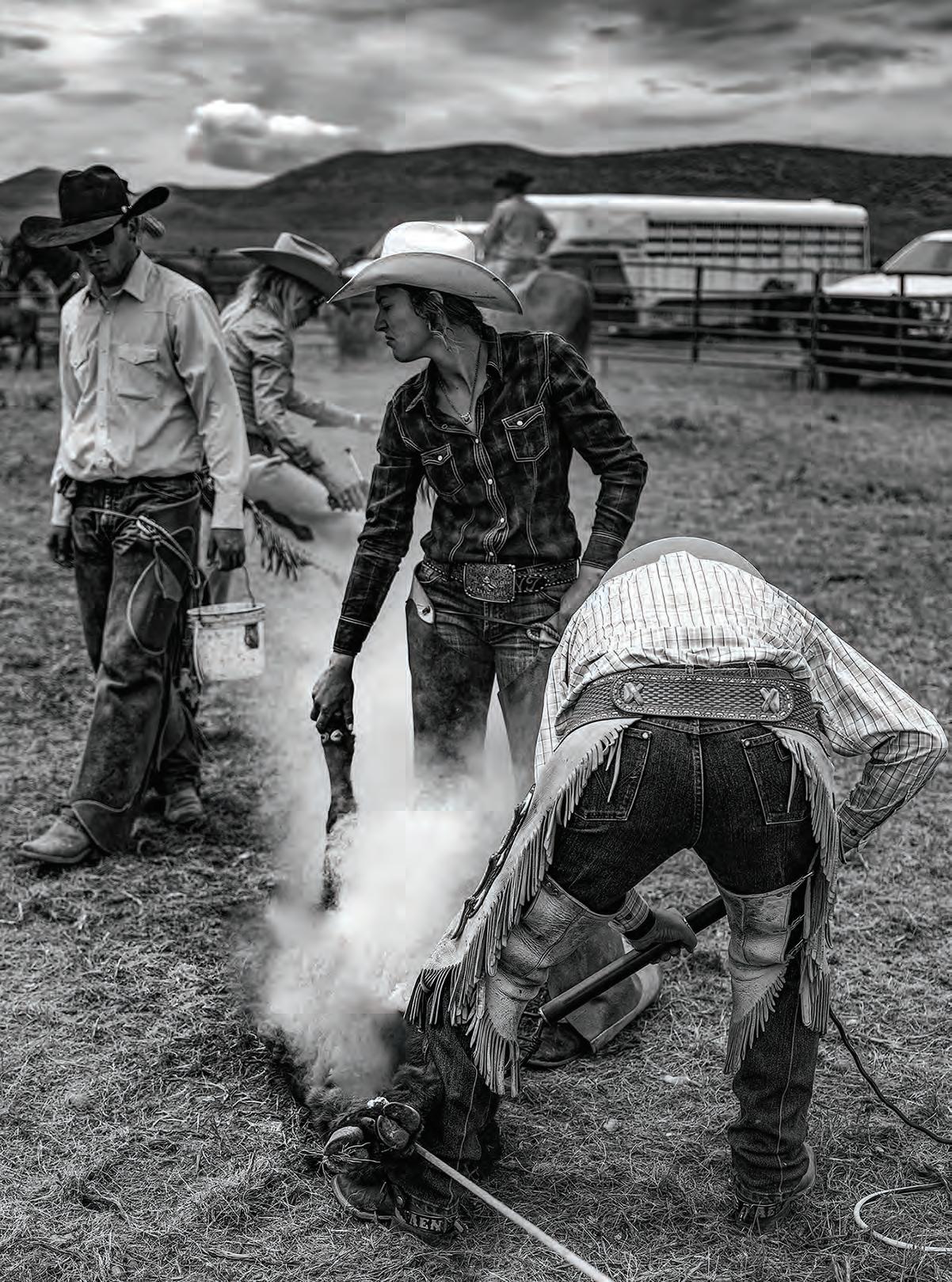
Follow the Wagon Ruts: The ranch itself inspired every photograph in the book. “It’s the scale of the land, the sky, the air we breathe and mother nature,” Anouk says. “The land came first, and then we came. To me it’s very important. I think that is what still inspires people from around the world to connect with the American Western landscape.” In the 1800s hundreds of thousands of emigrants drove and followed covered wagons across these foothills along the Oregon, California and Mormon trails. The ranchers who staked claims after approval of the 1862 Homestead Act and the cattleman who trailed the first herds north from Texas into Wyoming also used wagons to haul food and supplies. Wagonhound’s true expanse is revealed above, as pickups and horse trailers crossing the ranch in line seem like child’s toys.
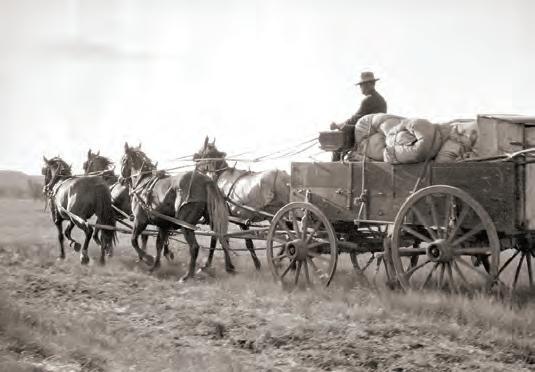
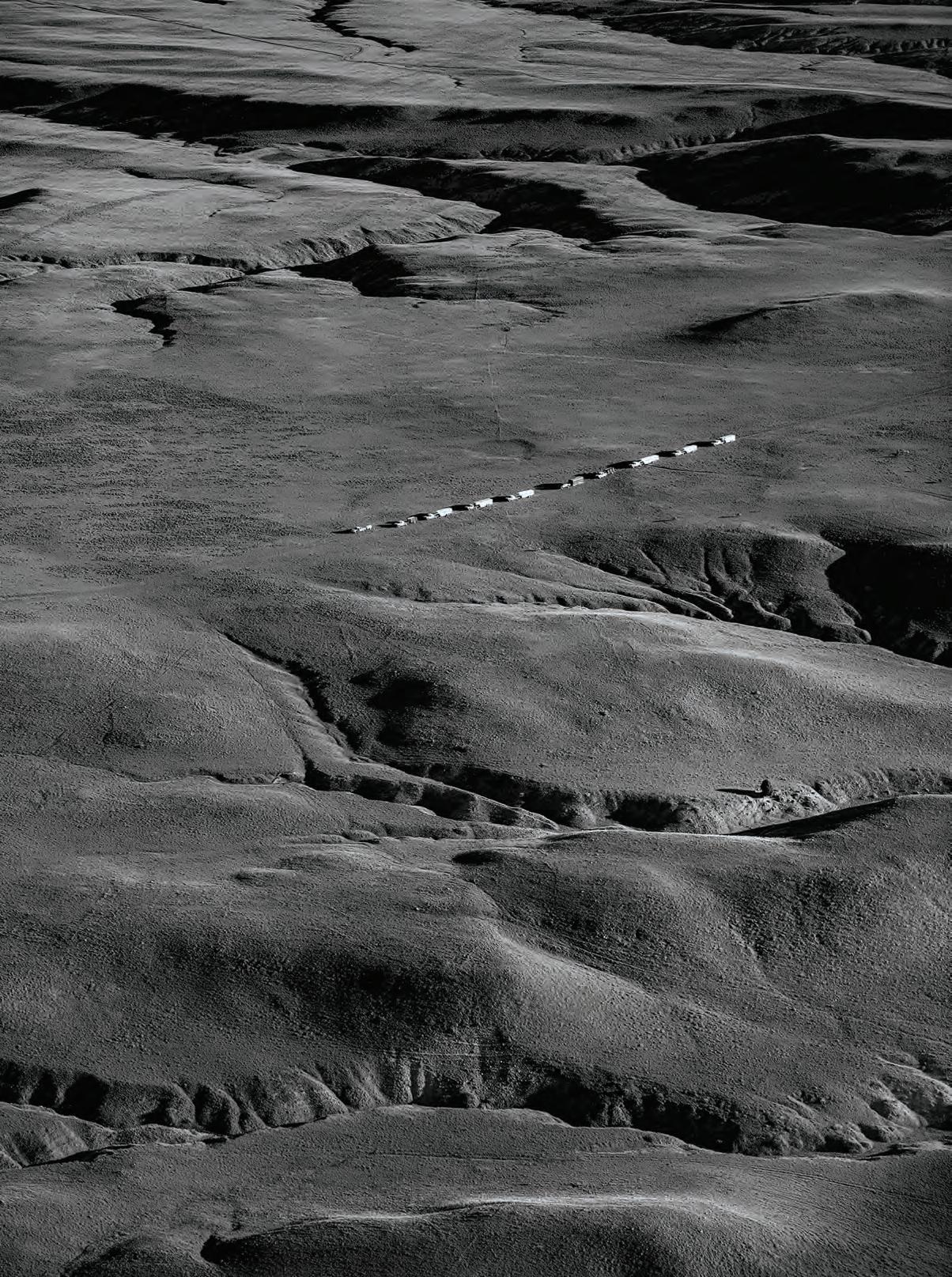
Learning the Ropes: Ranch life is multigenerational. Often a roundup or branding crew includes grandma and grandpa, mom and dad, sons and daughters, all riding and working side by side. Little ones might ride saddles their own parents used when they were small. The best babysitter on a ranch remains a steady, older horse named Dunny or Brownie or even Sweet Pea. The best such horses can be depended on to be gentle around kids but still able to manage quarrelsome steers. If a kid doesn’t know how to push cows down a trail or out of brush, but the horse does, then that’s a partnership that will get the job done. When adults involve their children in the chores—the kids usually consider it fun— they are not only passing on a legacy, but also instilling a work ethic and an appreciation for stewardship of the land, work animals and livestock. Among Anouk’s revelations as she photographed the Wagonhound were how hard people work and how they work together as a community with their families and neighbors. But her biggest discovery was how much they truly cared for the land. “How they use pasture rotation, a wonderful way to let the earth breathe, rest,” she says. “What they are doing for our earth is unknown to most people.”
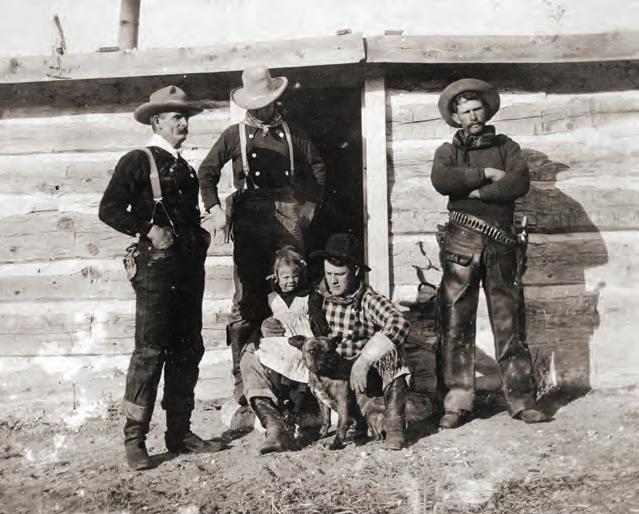


THE SPRINGFIELD MODEL 1842 SERVED IN THE ANTEBELLUM

U.S. ARMY, SAW USE BY BOTH SIDES IN THE CIVIL WAR AND SPREAD WEST, SOUTH OF THE BORDER AND OVERSEAS AS POSTWAR SURPLUS
BY GEORGE LAYMANAmong the most widely used and distributed percussion muskets, the Springfield Model 1842 was the last .69-caliber smoothbore arm issued to the U.S. Army. Some 275,000 rolled off the assembly lines—172,000 from the namesake federal armory in Springfield, Mass., another 103,000 from the armory in Harpers Ferry (in present-day West Virginia). Between 1856 and ’59 armorers at both locations rifled the barrels on 14,182 Model 1842s for use with conical bullets and fitted some 10,000 of them with long-range rear sights. It was the first U.S. musket produced with a percussion lock. Its effective range with any accuracy was limited to 100 yards, though with a stout enough powder charge it remained lethal out to 300 yards.
The Model 1842 remained in production from 1844 (when adopted by the U.S. military) to ’55 (when supplanted by the Model 1855, a .58-caliber rifled musket). The Palmetto Armory in Columbia, S.C., produced 6,020 Model 1842s for that state’s militia and use by antebellum federal troops. They were finished in an arsenal bright (with no browning or bluing), and many have transitioned to a speckled brown patina over time. During
the 1846–47 Mexican War the Army issued troops the Model 1842 and other .69-caliber muskets, including the Springfield Models 1816 and ’22, most in their original flintlock configuration, though some had been converted to percussion. At the outbreak of the Civil War thousands of Model 1842s were in storage in Southern armories, thus Confederate troops also used them in substantial numbers.
After the war the government sold many such muskets (issued by B. Flagg and A.H. Waters as well as the Palmetto Armory) surplus at fire sale prices, and many westbound settlers purchased them. Celebrated New York City arms dealer Schuyler, Hartley & Graham sold thousands of Model 1842s in Latin America as well as in China through Hong Kong dealers. The American Trading Co. sold examples to various Japanese clans during the 1868–69 Boshin War (aka Japanese Revolution).
From 1871 to ’76 the Mexican government also purchased many Model 1842s. The one detailed on the opposite page was one of 600 sold to Mexico in the spring of 1875 and issued to various state militias. Its barrel features the signature speckled surface patina, while its walnut stock shows light splits caused
Left: The Springfield detailed here and in the photos below was among 600 sold to Mexico in the spring of 1875 and issued to state militias. Note its signature speckled surface patina. Below: Its barrel is stamped Estado Yucatán (the state of issue) and RM (for República Mexicana). Bottom: Light splits in its walnut stock are indicative of temperature changes and irregular oiling of the wood. The origin and meaning of the scratched initials H.R.P. have been lost to time, but are likely those of a former owner. Today Springfields are highly collectible.
by temperature changes and irregular oiling of the wood. The barrel is crudely stamped Estado Yucatán with an adjacent RM, for República Mexicana . The lock plate is stamped 1850 and was made in Springfield, while the rear upper breech plug is stamped 1848. It was first acquired in the late 1940s from an individual whose ancestor, a Mexican bandido, participated in the infamous Dec. 4, 1875, attempted robbery of the entire town of Campo, Calif. That bandido had his neck stretched from a tree not far from the original trading post, yet his smoothbore somehow remained in the family. The initials on the stock are attributable to either U.S. soldiers or those issued the arm in Mexico. Yours truly acquired it from Jim Masterson, a lifelong collector who through the 1950s and ’60s discovered dozens of such military and civilian arms in Mexico.
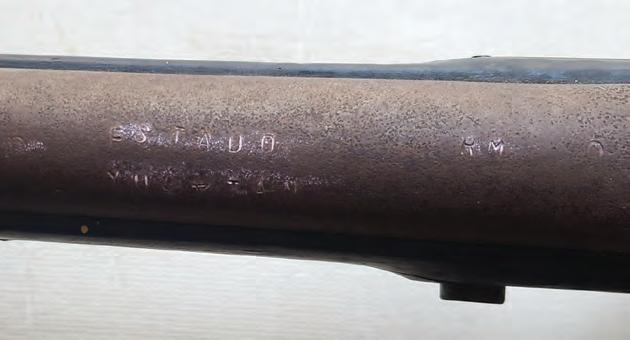
Often in cut-down versions the Model 1842 saw use in two major American wars, south of the border and in other hot spots around the world. It remains highly collectible. Since the mid-2000s Dixie Gun Works has imported an Italian-made reproduction Model 1842 for Mexican and Civil War re-enactors, shooters and collectors. Over the decades several originals have turned up as relics in the former Comancheria of the Texas Panhandle, some decorated with tacks in typical Indian fashion.
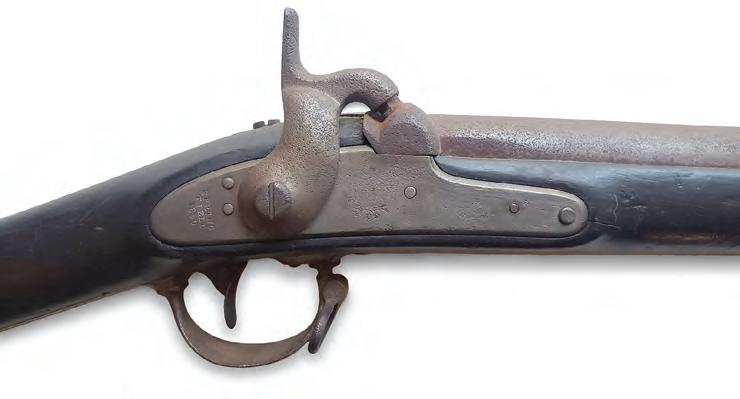


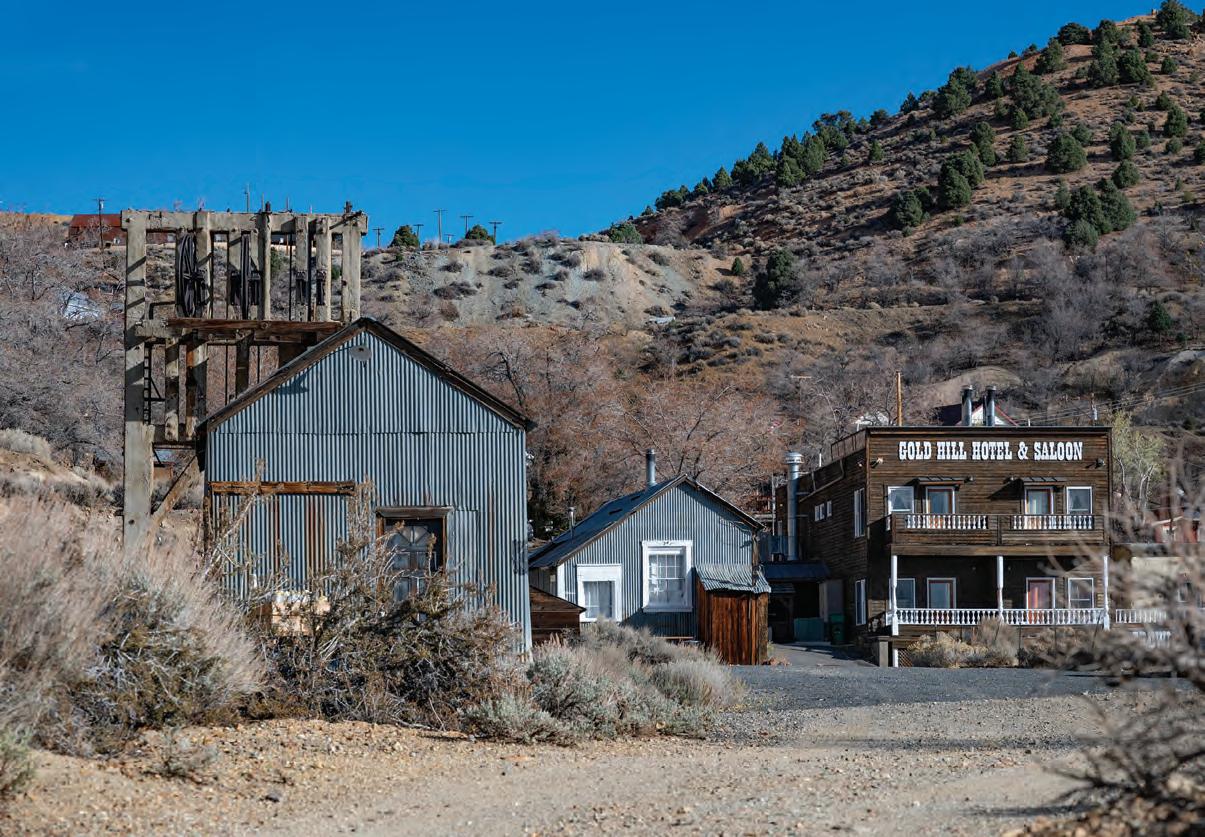
Most Western mining camps marked distinct beginnings and endings based on the initial discovery of precious metals and the end of mining activities. Such towns sprang into being, boomed with profitability and then faded away when the costs of extracting the metal from the porphyry exceeded the return. Gold Hill also faced the challenge of its location in a deep and precipitous canyon given to flooding. Indeed, its very discovery in January 1859 was driven by men who journeyed to the head of Gold Canyon in response to snowmelt from warm weather. They followed a rivulet north up the ravine to discover a huge quartz outcrop streaked with gold. It resembled a veritable hill of gold, hence the name of the town that rose up beneath it. The very channel of the ravine that led men to its riches became the main business street through town. Within months of the discovery Gold Hill comprised a scattering of log houses and one large log boardinghouse inhabited by a few hardy
miners scraping out $20 a day. Placer miners would exploit the shimmering hillock for three years before realizing it was an extension of the Comstock Lode and that silver ore was thus more plentiful and profitable than the gold.
It was in June 1859 that miners discovered the seemingly inexhaustible silver deposits of the Comstock, a mile north of Gold Hill, thrusting the entire region into prominence. Though destined to toil in the shadow of Virginia City—the town the Comstock birthed and Nevada’s largest metropolis through century’s end—the residents of Gold Hill could still crow about its age. It was five months older than Virginia City and boasted the territory’s oldest mill (erected in 1860), as well as some of the oldest foundries and factories supplying machinery for the mines and mills. As its mines developed, the population grew, and hard rock mining replaced the placer claims. Such productive mines as the Yellow Jacket, Crown Point, Kentuck, Belcher, Justice, Imperial and Empire duly
garnered headlines nationwide. By 1864 nine boardinghouses lined Gold Hill’s steep streets, and the population peaked in 1875 at roughly 8,000 souls.
Blacksmith V.A. Houseworth, the first so-called recorder in Gold Hill, kept his tattered book of records behind the bar of a local saloon, the miners recording their own claims as they saw fit. The original June 1859 location notice of the Yellow Jacket mine claimed 1,200 feet of a vein, including all its depths and spurs—“depths and spurs” meaning the miners intended to follow the vein of precious metal wherever it led, regardless of how complicated or conflicted it became with other claims. One historian estimated that more money was made by Comstock lawyers trying to settle poorly recorded claims than was generated by the mines themselves.
One enduring local rags-to-riches-to-rags love story centered on Alison “Eilley” Oram Bowers and her younger, handsome husband, Sandy. Eilley ran one of the first boardinghouses in town, and Sandy was one of her longtime boarders. Their love grew as his wealth from the mine bearing his surname mushroomed. The two soon built a magnificent home in the Washoe Valley, today preserved as a museum within a regional park. Sadly, their lavish lifestyle ended when Sandy fell ill and died at age 35. Bankrupted soon after, Eilley resorted to telling fortunes and prognosticating under the alias of “The Famous Washoe Seeress,” though apparently she didn’t foresee her own eventual impoverishment and death.
Gold Hill enjoyed solid, steady growth through the 1860s. By 1864 residents had erected a Town Hall, with police court and jail, opposite the popular Vesey House. The oldest operating hotel in Nevada, it welcomes visitors today as the Gold Hill Hotel. Virginia & Truckee Railroad tourist trains make occasional stops at the restored depot.
In 1867 the Gold Hill Daily News estimated that a stunning $85 million ($1.8 billion in today’s dollars) had been extracted to date from the state’s mines. Seven years later the aggregate value of the Virginia City and Gold Hill mines topped $93 million (nearly $2 billion in today’s dollars). But all that wealth came at a steep cost. In the early morning hours of April 7, 1869, a fire broke out in the Yellow Jacket (see related feature, P. 38). It soon spread to the Crown Point and Kentuck, claiming the lives of at least 35 men (perhaps as many as 45) in one of the worst mining disasters in American history. The day shift began work at 7 a.m., and dozens of men were lowered into the mine before the fire was discovered. Families gathered at the surface in despair to wait inconsolably for lost husbands, brothers and sons. At the time the popular dramatic actress Amy Stone was playing Piper’s Opera House in Virginia City, and she promptly hosted benefit concerts for the families of the deceased Gold Hill miners.

Gold Hill’s most famous resident may have been author Mark Twain, who lived in a local boardinghouse sometime in 1863. A co-worker from Twain’s days at Virginia City’s Territorial Enterprise recalled their having roomed together in Gold Hill. But traditional hard-rock mining ended in the late 1880s, and the Gold Hill of Twain’s memory is long gone, having faded with the long-ago shriek of steam whistles and thunderous bellow of machinery.
Far left: The 1880s headframe of the Yellow Jacket rises tomblike atop the site of the horrific 1869 fire that claimed several dozen men. Above: The Virginia & Truckee tourist train approaches the depot. At last count in 2005 Gold Hill’s population was 191.
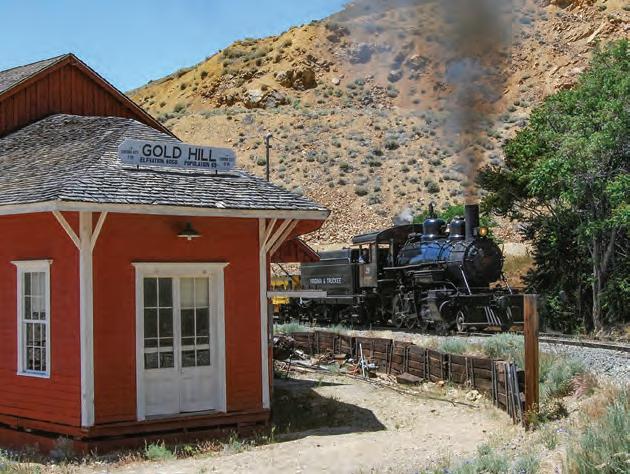
The Gold Hill of Mark Twain’s memory is long gone, having faded with the long-ago shriek of steam whistles

The Call of the Wild (1903, by Jack London)
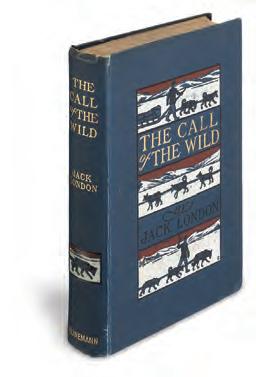
Kidnapped from a comfortable life, Buck the dog is forced to labor on the trail to and from the Klondike goldfields before ultimately escaping to join a wolf pack. Jack London’s novel gives the reader a gritty impression of the gold rush and brought its author international repute. Dogs London encountered during his own adventures in the Yukon likely served as models for Buck.
“To Build a Fire” (1908, by Jack London)
An author of many classics, London outdid himself with this haunting short story about a man who, having underestimated the danger of subzero temperatures during a solo journey into the Yukon interior, makes every effort to avoid freezing to death. No spoiler alert.
Good Time Girls (1998, by Lael Morgan)
Lael Morgan spent years researching the history of the Klondike Gold Rush. This book centers on period accounts of prostitution, outlining its amusements and horrors not only in the gateway towns of Skagway (Alaska Territory) and Dawson (Yukon Territory), but also in the Alaskan settlements of Dyea, Juneau, Wrangell and Tenakee Springs, where prostitutes served as “winter wives” to miners for a cut of their poke.
The Klondike Fever
(1958, by Pierre Berton)
The Best of Robert Service
(1940, by Robert W. Service)
Poetry pulls at the heart, and with such poems as “The Shooting of Dan McGrew” Robert Service also did an excellent job of capturing the atmosphere of the Yukon, where he lived from 1904 to ’12 while working as a bank teller. His poetry evokes both feel and attitude far better than facts and figures.
Call of the Wild (1935, on DVD and Blu-ray)
There are several film versions of Jack London’s Call of the Wild, among them ones starring Charlton Heston and Harrison Ford. But the 1935 version with Clark Gable, Loretta Young and Jack Oakie remains the best. It not only captures the feel of the Klondike Gold Rush, but also focuses on Buck the dog more than the other versions. Though the narrative strays from that of London’s novel, a gritty and defiant Gable is terrific in the lead role.
The Gold Rush (1925, on DVD and Blu-ray)
Present-day viewers may balk at films released during the silent era, but Charlie Chaplin’s Gold Rush is truly a must see. A wonderful satire on the Klondike, it includes such timeless comic scenes as the “Little Tramp” cooking and eating his shoes, and his prospecting partner envisioning him as a roast chicken. Aware of the starvation suffered by many Klondike prospectors, Chaplin turned their suffering into comedy gold.
White Fang (1991, on DVD)
Jack London’s 1906 novel, which revolves around the Klondike adventures of the eponymous wolfdog, has proved popular enough to inspire several films. The 1991 version—starring Ethan Hawke as a young man who, with White Fang’s help, seeks a valley of gold in the Yukon to fulfill his late father’s dying wish—is probably the best. The producers built an entire town for the film. Disney later turned over the set to the town of Haines, Alaska, which uses the buildings as a backdrop for its annual Southeast Alaska State Fair in late July.
The Far Country (1954, on DVD and Blu-ray)
Shocking, enthralling and satisfying from first page to last, Pierre Berton’s award-winning account of the Klondike Gold Rush presents readers both the broad narrative and the personal histories that round out any retelling. Berton was born and raised in Yukon Territory in the wake of the rush and plumbed period records and personal recollections to relate this absorbing tale.
Hollywood often portrays the Klondike as just a colder version of the Old West, though horses do not do well in the region. Still, this James Stewart “Northwestern” is a well-acted, fast-paced film. John McIntire portrays the villainous Judge Gannon, a character loosely based on real-life con man Jefferson “Soapy” Smith. The latter’s descendants reportedly threatened to sue if producers portrayed Soapy in a bad light, hence the name change.
The Spoilers (1942, on DVD and Blu-ray) Centering on the Nome Gold Rush, which followed on the heels of the Klondike, Rex Beach’s 1906 tale of prospecting partners forced to battle corrupt, claim-jumping government officials has been brought to the big screen five times. Starring John Wayne, the 1942 version best captures the feel of what a real gold rush must have been like. Western aficionados will appreciate the epic fistfight waged between Wayne and a villainous Randolph Scott over the alluring Marlene Dietrich. Spoiler alert: Wayne wins—barely.
The title surely attracts attention, but as David Thomas relates in his preface, Rudabaugh’s contemporaries never applied the catchy “Dirty Dave” sobriquet to the gunfighter. Rudabaugh did join up with Billy the Kid, but just how feared Dave was is debatable. Certainly, in retrospect there wasn’t much reason to fear Rudabaugh (spelled Radenbaugh in the only U.S. census in which his name appears). The author does an excellent job of de-
bunking the myth that Rudabaugh was a nasty and, yes, dirty bully who killed and brutalized people. Rudabaugh was, according to Thomas, “an exceptionally smart, well-educated man” who mostly proved treacherous only to fellow wrongdoers. For example, while six men committed the Jan. 27, 1878, train robbery at Kinsley, Kan., Rudabaugh was the only one not to pay the price for that crime. He confessed and was freed after turning state’s evidence against his fellow robbers. After leaving Kansas, Rudabaugh hired on as a constable in Las Vegas, New Mexico Territory, not that a badge deterred him from partnering with two outlaws to rob a stagecoach 4 miles south of town on Aug. 14, 1879. Another trio was falsely arrested, but Rudabaugh later confessed and named his partners in crime. Just over a year later Rudabaugh repeated his performance—partnering with another pair of outlaws to rob a stagecoach north of Fort Sumner on Oct. 16, 1880, then later confessing and naming his accomplices.
Drawing on a never-before-published trial transcript, Thomas relates in detail how Rudabaugh was falsely accused and later convicted of the murder of jailer Antonio Lino Valdez during a visit Dave made with one John J. Allen to the Las Vegas jail

 By David G. Thomas, Doc45 Publishing, Las Cruces, N.M., 2023, $24.95
By David G. Thomas, Doc45 Publishing, Las Cruces, N.M., 2023, $24.95
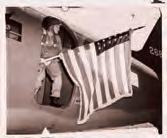

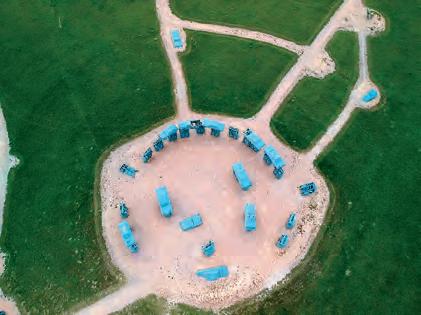

ChartyourCoursetoexperiencetheunexpected discoveriesinandaroundAlliance,Nebraska wherethereishistoryateveryturn.Fromscenic drives,toourlocalbrewery,remarkableparks, richartandthelegendaryCarhenge;youwillbe transportedtoanostalgicplacewherequaint shopslineourhistoricdowntownbrickpaved streetsandfolksyou’venevermetwillsmileand wave.Ourhospitalityandbeautyofourcitywill leaveyouwantingtocomebackformore.
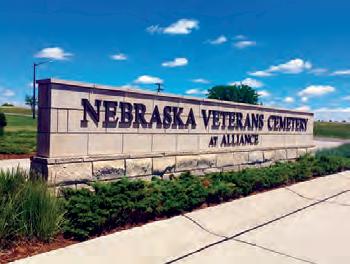

Planyourgetawaynowbyvisiting www.visitalliance.com

on April 2, 1880. The pair got away clean, but a few weeks later Rudabaugh apparently did kill Allen, the one who actually murdered Valdez. By midOctober Dave was hanging out in Fort Sumner with Billy the Kid and cohorts.
On Dec. 23, 1880, Sheriff Pat Garrett captured both Rudabaugh and the Kid at Stinking Springs. Like Billy, Dave was slated to be hanged but escaped that fate (both successfully broke jail in 1881). While Billy succumbed to a fatal bullet from Garrett at Fort Sumner on July 14, 1881, Rudabaugh found sanctuary in Mexico until shot down and beheaded by a grocer in Parral on Feb. 18, 1886. Thomas, a standout researcher who has produced 10 books in his Mesilla Valley History Series, provides the provenance of two well-known but controversial photographs in which the outlaw’s head appears minus the body.
—Gregory LalireIf you’re searching for an exquisite illustrated book on Texas history, Ron Tyler’s Texas Lithographs certainly fits the bill. Here’s the catch: This 518-page book is far more than simply a pretty book to display on a coffee table.

Tyler’s book is a hybrid of stunning period images and tightly woven sentences that relate the origin story of Texas in a refreshingly new way.
Charles E. Boles, born in England in 1829, was destined to become America’s greatest stagecoach robber, mostly while using the alias Charles Bolton but becoming nationally known as Black Bart. One of the most interesting Wild West outlaws to ever rob at gunpoint (in his case brandishing a doublebarreled shotgun), he has been the subject of at least three earlier biographies—William Collins and Bruce Levene’s Black Bart: The True Story of the West’s Most Famous Stagecoach Robber (1992), George Hoeper’s Black Bart: Boulevardier Bandit (1995), and Laika Dajani’s Black Bart: Elusive Highwayman-Poet (1996). Award-winning California author John Boessenecker, who has been researching Black Bart for a half century, acknowledges the groundbreaking work done by those authors and dedicates his book to Levene. Boessenecker himself goes one step further to reveal the true character of Black Bart, thanks to digitized newspapers, online genealogical data banks, Wells Fargo contacts and his own dedicated research.
 By John Boessenecker, Hanover Square Press, Toronto, Ontario, 2023, $32.99
By John Boessenecker, Hanover Square Press, Toronto, Ontario, 2023, $32.99
As Andrew J. Torget—author of Seeds of Empire: Cotton, Slavery and the Transformation of the Texas Borderlands, 1800–1850—so eloquently noted in his praise for this book, “I thought I knew 19th-century Texas well, but I found myself learning something new and fascinating in every chapter, because I had not encountered the art of the era in this way.”
None of that happened by accident—or overnight. The seeds for this book were planted more than 37 years ago. Tyler put the project on hold in 1986, after accepting a position as a history professor at the University of Texas, and again in 2006, after becoming director of the Amon Carter Museum. Finally, in 2011 the newly retired Tyler resumed his research, soon discovering the internet had unearthed a multitude of new resources stretching far beyond Texas. Archival staffs nationwide helped Tyler compile an amazing collection of images that alone tell a stirring story of the “Lone Star State.”
Tyler found lithographs on everything from old calendars and pamphlets to maps and song sheets. You’ll find John James Audubon’s extraordinary hand-colored lithographs of wildlife within these pages, as well as Edward Everett’s iconic watercolor and sketches of the Alamo ruins in 1847. Taken as a whole it presents journey through a 19th-century Texas seldom seen.
—Ron J. Jackson Jr.Boles, who immigrated to New York with his family as an infant, was among the scores of hopefuls who failed to strike it rich in the California Gold Rush. On Nov. 27, 1856, he married Mary Elizabeth Johnson, who was 19 years old and four months pregnant, in Farmington Iowa. Boles proved no more successful as a farmer than a miner. In August 1862 he joined the 116th Illinois Volunteer Infantry Regiment. His extensive Civil War service, which the author details, was valiant. After the war, instead of sticking by Mary and their children, he again struck out west seeking wealth and adventure. “And three years of facing Confederate gunfire seems to have led him to believe that he was entitled to his freedom,” writes Boessenecker. Mining again didn’t work out for him, but in San Francisco he found his calling—posing as a prosperous mine owner and becoming quite respectable while going out of town on stagecoach-robbing excursions.
Black Bart maintained his dual lifestyle from his first robbery on July 26, 1875, until shortly after his last robbery on Nov. 3, 1883, when Wells Fargo detectives finally caught up with him after finding his handkerchief with a laundry mark they tracked down in San Francisco. By then he’d achieved infamy as a lone bandit who left passengers alone, never shot anyone in a record 29 stagecoach holdups, always escaped afoot instead of on horseback and left poems at the scenes of his robberies. Yes, he was a gentleman in San Francisco and far from a ruffian when ordering stagecoach drivers to throw down the Wells Fargo express boxes. But as Boessenecker points, Black Bart got bigger hauls robbing the stagecoach mail (the way poorer people trans-
You can’t always lie down in bed and sleep. Heartburn, cardiac problems, hip or back aches – and dozens of other ailments and worries. Those are the nights you’d give anything for a comfortable chair to sleep in: one that reclines to exactly the right degree, raises your feet and legs just where you want them, supports your head and shoulders properly, and operates at the touch of a button.


Our Perfect Sleep Chair® does all that and more. More than a chair or recliner, it’s designed to provide total comfort. Choose your preferred heat and massage settings, for hours of soothing relaxation. Reading or watching TV? Our chair’s recline technology allows you to pause the chair in an infinite number of settings. And best of all, it features a powerful lift mechanism that tilts the entire chair forward, making it easy to stand. You’ll love the other benefits, too. It helps with correct spinal alignment and promotes back pressure relief, to prevent back and muscle pain. The overstuffed, oversized biscuit style back and unique seat design will cradle you



OVER 100,000 SOLD
OVER 100,000 SOLD

in comfort. Generously filled, wide armrests provide enhanced arm support when sitting or reclining. It even has a battery backup in case of a power outage.
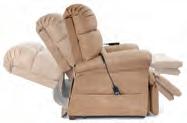











White glove delivery included in shipping charge. Professionals will deliver the chair to the exact spot in your home where you want it, unpack it, inspect it, test it, position it, and even carry the packaging away! You get your choice of Luxurious and Lasting Miralux, Genuine Leather, stain and liquid repellent Duralux with the classic leather look, or plush MicroLux microfiber, all handcrafted in a variety of colors to fit any decor. Call now!
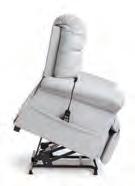
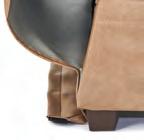


1-888-639-6855
Please mention code 117924












“To you, it’s the perfect lift chair. To me, it’s the best sleep chair I’ve ever had.”
— J. Fitzgerald, VA 3CHAIRS IN ONE: SLEEP/RECLINE/LIFT
mitted their money) than the express boxes, and his worst crime of all was having deserted his wife and children. Mary kept believing her husband would return, but even after having served his time at San Quentin and made many promises to her by mail, he never did. In fact, the author writes, the negligent husband and father went on to rob three more stagecoaches, giving him a grand total of 32. Black Bart’s ultimate fate is a mystery not even the dogged Boessenecker could solve, though in his usual thorough and entertaining fashion the author suggests many possibilities.
Gregory LalireThe vast literature on the Battle of the Little Bighorn and the Indian wars might suggest there is little room for additional contributions. But Rodney Thomas has broken the mold with this comprehensive examination of warrior, Army scout and artist White Swan (circa 1850/51–1904), whom one art expert dubbed the “Rembrandt of the Crow people.”
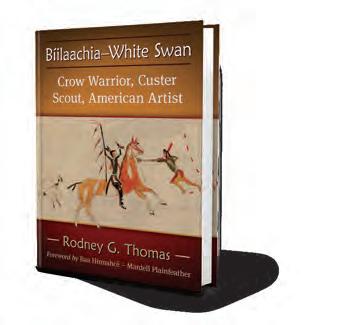
White Swan was one of six Crow scouts present at the 1876 battle on Montana Territory’s Little Bighorn River, where he counted coup three times and sustained crippling wounds to his right leg and hand during Major Marcus Reno’s Valley Fight. Gunfire and a severe blow to the head during the fight so impaired his hearing and speech he could only communicate by signs. Yet, he remained an Army scout until 1881.
that the “Plains Indian warrior biographic art form is now accepted as both ‘history’ and ‘art.’”
—C. Lee NoyesThe June 1876 defeat of the 7th U.S. Cavalry on the Little Bighorn River in Montana Territory shocked the nation, people from New York to California mourning the loss of Lt. Col. George Armstrong Custer and his immediate command. Mourning the dead most acutely were the soldiers’ widows. The Widowed Ones focuses on the seven wives of 7th Cavalry officers who lost their husbands to Custer’s Last Stand. Six of the seven remained in close communication for the rest of their lives. “The bond the women shared proved to be what they needed to survive,” co-authors Enss and Kazanjian write. “Each admitted to family or in their memoirs the crucial necessity of their friendships.”

To fill the void of available information about White Swan’s life, Thomas chased down and interpreted the scout’s extensive artwork, which by the 1890s had provided “a safe and even productive refuge from the heartfelt perceived cultural losses.” White Swan’s works also won the praise of such prominent artists as Elbridge Ayer Burbank and Joseph Henry Sharp. “Using the biographic art form employed by Plains Indian warriors to proclaim their battle and hunting prowess,” Thomas notes, “he created at least 13 hide and muslin paintings and at least 24 drawings on paper depicting his and others’ deeds in battle.” The author’s detailed analysis confirms White Swan’s participation in such intertribal warfare as the battle with Lakotas at Shoulder Blade Creek near the Little Bighorn, probably in 1870. Of special interest to this reviewer is the Denver muslin about the Little Bighorn, which graphically records his having counted coup and been attacked by the Lakota Brave Bear.
This stellar contribution to Plains Indian wars literature might not appeal to readers with only a general interest. However, subject matter experts should welcome such specialized studies and agree with the author’s well-documented observation
The widow who gained the lion’s share of attention was Elizabeth “Libbie” Custer, who, though married to George for just a dozen years, kept his memory alive until her own death on April 4, 1933, just four days short of her 91st birthday. Libbie was the one who broke the tragic news to the other officers’ wives and, despite her intense grief, seemingly held together better than her fellow “widowed ones,” a name given the women by the editor of the Minneapolis Star Tribune. “Elizabeth Custer,” the authors write, “had made a life for herself beyond the tragic death of her husband, but not without his omnipresent memory shaping her every decision. Her identity was tied to General Custer’s career, and she made no apologies for that.”
The widows who stayed in touch with Libbie included sister-in-law Maggie Calhoun (who was married to Lieutenant James Calhoun), Annie Yates (Captain George W. Yates), Eliza Porter (Lieutenant James Ezekiel Porter), Nettie Bowen Smith (Lieutenant Algernon Smith) and Molly McIntosh (Lieutenant Donald McIntosh). Grace Harrington, the widow of Lieutenant Henry Moore Harrington, did not keep in contact with the other six, in no small part because her husband’s remains were never found, thus she became preoccupied with the idea he had somehow survived and was being held captive somewhere. Custer outlived the other widows and spent her declining years overseeing fundraising efforts for museums, participating in charitable events and traveling as an unofficial ambassador for the United States. “No matter where she traveled,” the authors write, “she never strayed far from the topic of her infamous husband. She was his champion and took on any author who dared publish a book that cast Custer in a negative light.”
Gregory LalireWestern
Writers Of America

Holiday Inn Rapid City Downtown-Convention Center
Western Writers of America was founded in 1953 to promote the literature of the American West and bestow Spur Awards for distinguished writing in the Western field.
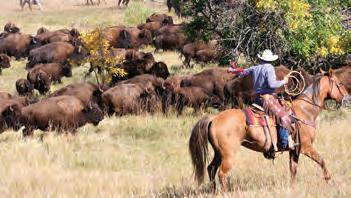
WIWP-230700-WWA-AD.indd 2 4/19/23 3:03 PM



Mention of the Inside Passage—a stretch of North American Fjordland that wends its way northwest nearly 1,000 miles from Seattle through British Columbia, Canada, to Skagway, Alaska—evokes images of carefree days spent lolling aboard luxury cruise ships between ports of call. Such is the impression imparted in this photo by Michel Verdure of Royal Caribbean’s Radiance of the Seas lingering before the perpetually calving face of Hubbard Glacier. Around the turn of the 20th century, however, shipboard accommodations were anything but luxurious. In his painting Embarking for the Klondike Gold Rush (inset) the late British comic artist Graham Coton imagined the scene in 1897 when the first of the Klondike Gold Rush hopefuls arrived off Skagway aboard a screw steamer from Seattle and either waded or rowed a tender ashore to begin the grueling trek into the Yukon interior (see related feature, P. 30). Scarcely a third of them would make it.
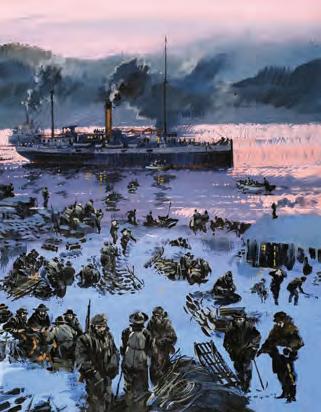
Ifyou’re anything like my dad, you give your family everything. Your name, your time, your values — the people in your life know they can depend on you for practically anything. In exchange for imparting all of this energy and experience, you expect nothing in return.




e point? You deserve to treat yourself once in a while. You do so much for the people you care about. Now it’s time to focus on you for just a few minutes. at’s where the Men’s Due Volta Watch comes in. is astonishing innovation provides a digital readout that’s powered by a precise quartz engine, combining both analog and digital timekeeping.








Out tted with a stopwatch, alarm, a.m./ p.m. settings, and day, date and month complications, this timepiece stands out from the crowd. With its large face and handsome, masculine design, this watch is perfect for the back nine and the happy hour afterwards. Water-resistant up to 3 ATM, this timepiece won’t wimp out if you have a run-in with a water hazard.


Other hybrid watches can sell for thousands of dollars, but because we’ve built more than 1 million watches, we know how to create real value. at’s why we can o er this timepiece for just $59! If you’re not completely satis ed with this watch, return it for a full refund.






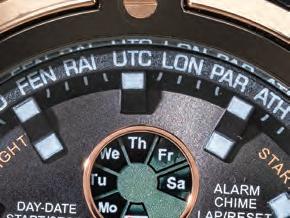

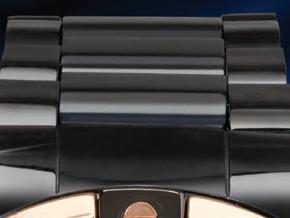
Act quickly! is one-of-a-kind watch has been one of our fastest sellers this year. Of our original run of 2,872, we only have 389 left for this ad! In the last couple of years there’s been a watch shortage, but Stauer has got you covered. If you’re the kind of man who gives everything and expects nothing in return, it’s time to treat yourself. Watch



A TOUR YOU WON’T FORGET! Explore The Great Plains and the Rocky Mountains on our Crazy Horse & Custer Tour as you travel through Wyoming, South Dakota and Montana to learn about these legendary leaders. One had a drive to keep his people and land free; the other a mission ordained by manifest destiny. In October 2024, join us on our Apache Wars of the Southwest Tour, an unforgettable journey through the scenic Southwest that follows in the footsteps of Geronimo and cast of remarkable historical characters. Our American History, Civil War and WWII tours are unrivaled in their historical accuracy!
